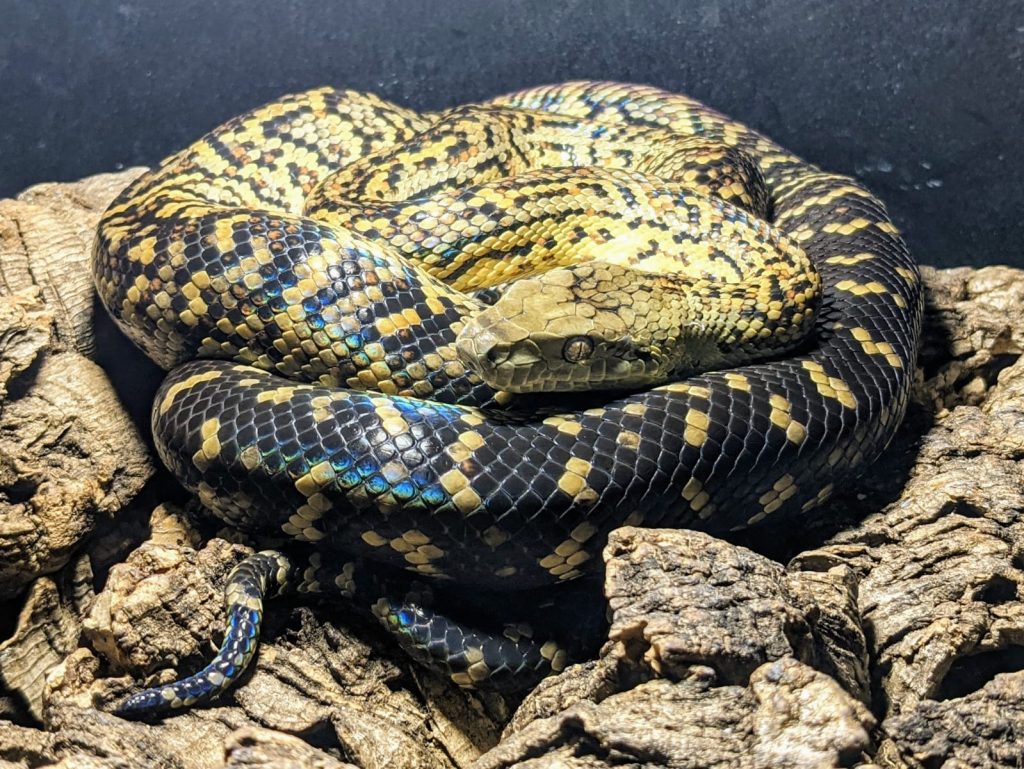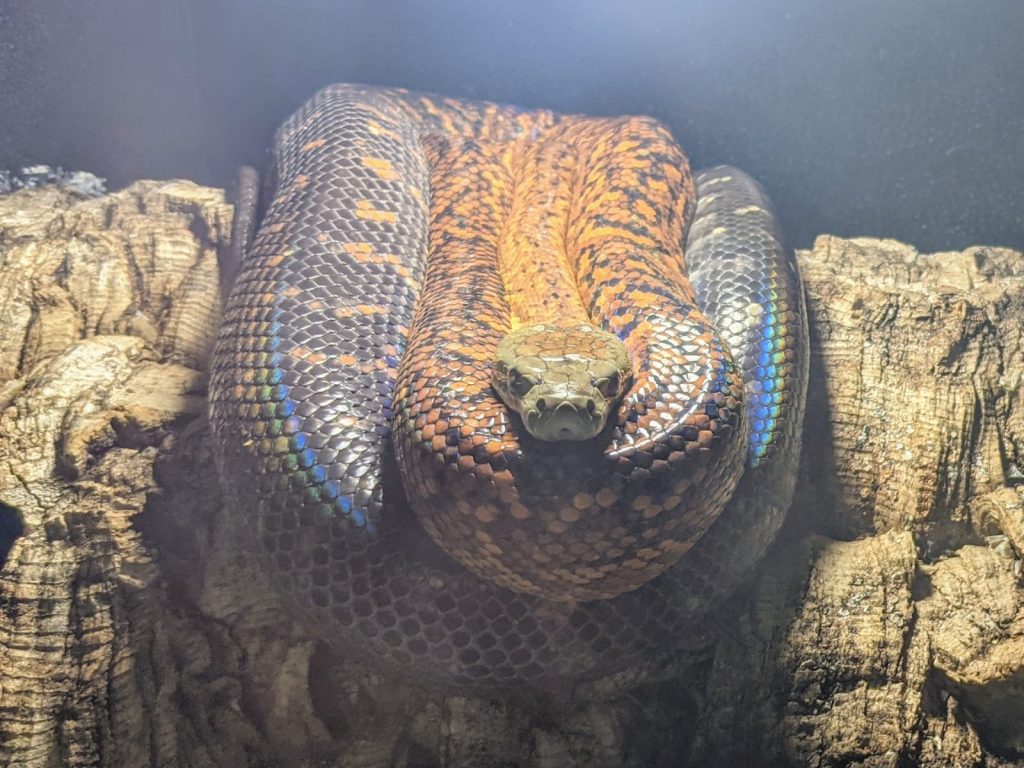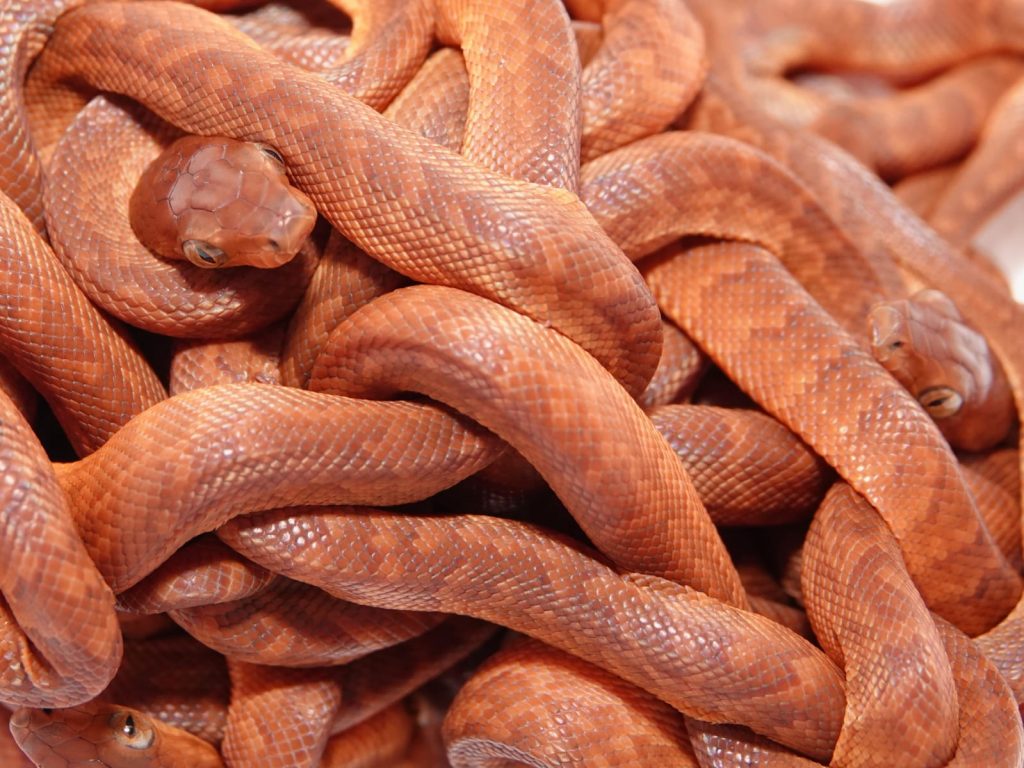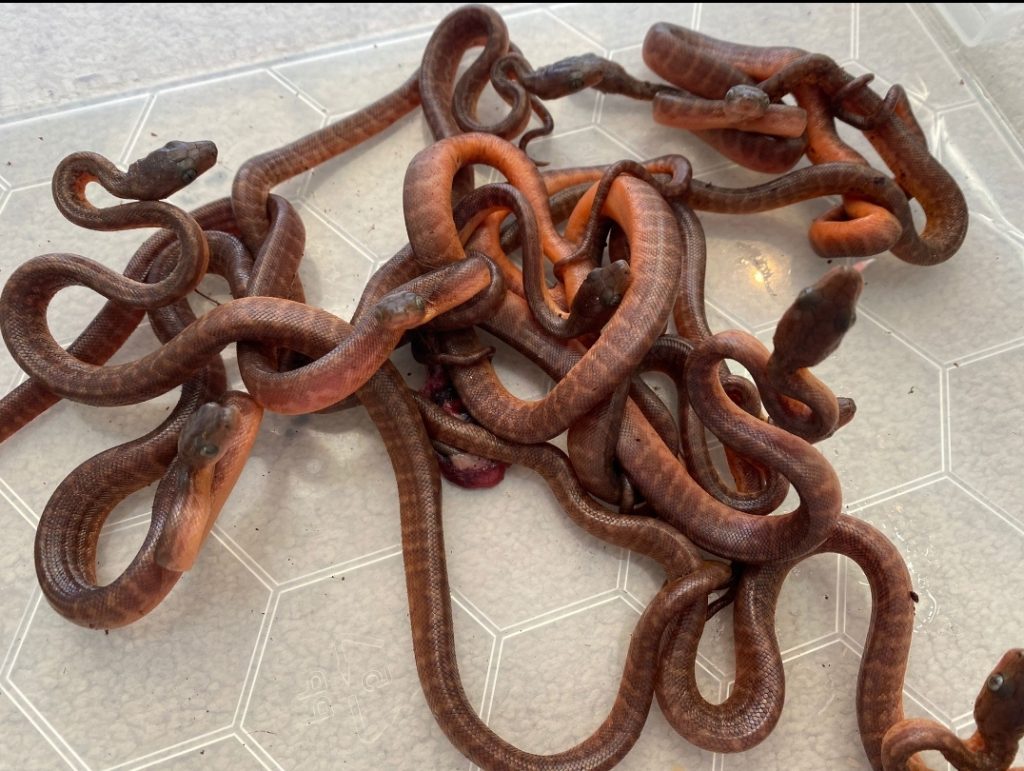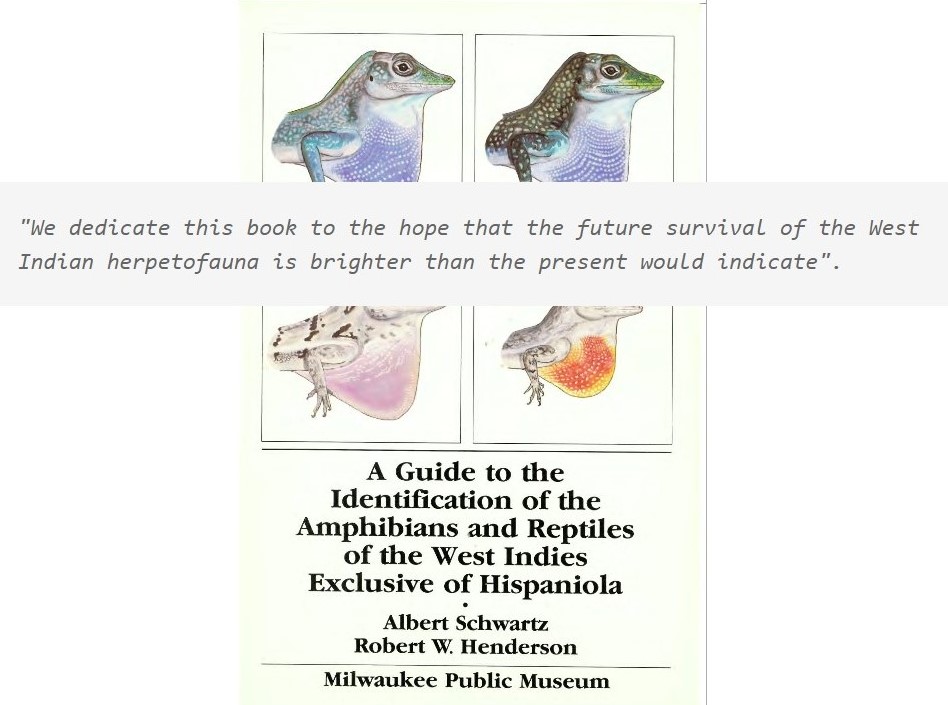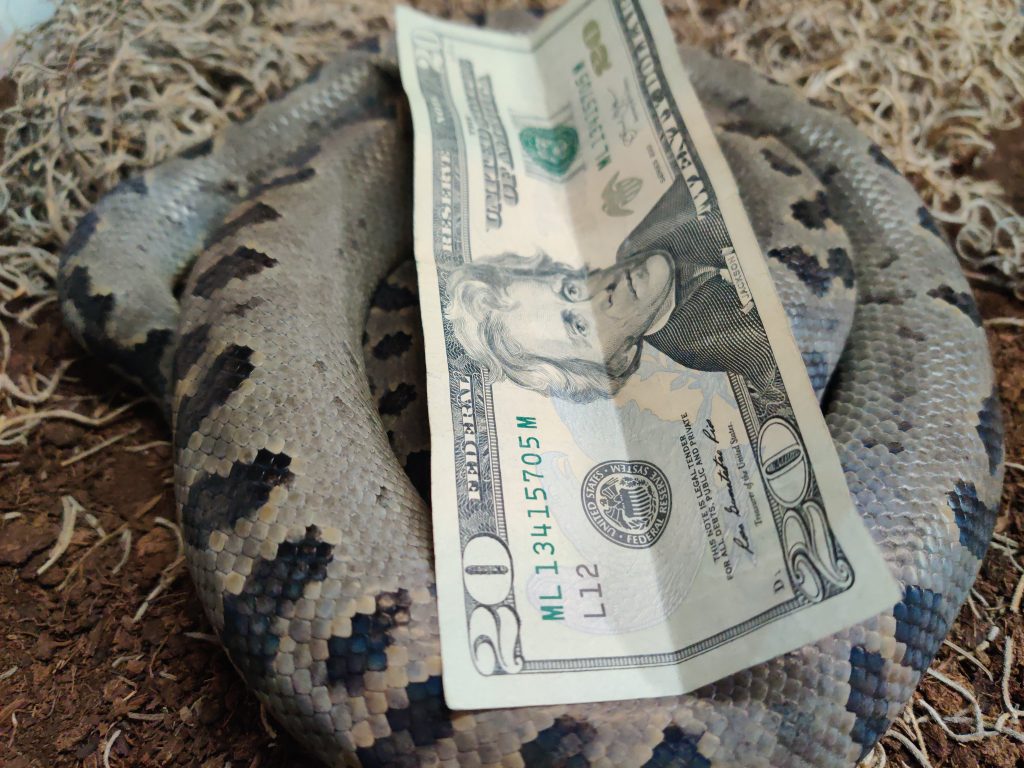Humans as a species behave in interesting ways. We respond to events such as a terrorist attack, a flooding or a wildfire with some sort of intellectual answer – not always the right response but that’s a different story. On the other hand, dramatic events that affect our world as a whole and which are long lasting seem too big to fathom. Nature Climate Change
Hurricane Maria to the southeast of Puerto Rico. Source Wikimedia Commons Why is this important and what does it mean? The Gulf Stream is considered the long-distance heater of Europe, as it brings heat as far as the British Isles and off the coast of Norway. The Gulf Stream, in turn, is part of the larger Atlantic Meridional Overturning Circulation (AMOC). This carries warm and salty water northward at the ocean surface, while cold and low-salinity water flows back at depth. Based on evidence from Earth’s history, researchers suspect that the circulatory system can, in principle, switch between two different operating states: a strong circular motion, as currently observed, and a much weaker one.
And the boas? We saw in the recent past glimpses of what hurricane intensification means for the West Indies. Hurricane Maria devastated the northeastern West Indies in September 2017, particularly Dominica (Category 5), Saint Croix, US Virgin Islands and Puerto Rico (Category 4) were affected. It is regarded as the worst natural disaster in recorded history to affect those islands. Considering the above mentioned study, we need to prepare for more of this.
Addendum On August 9th the IPCC published it’s Sixth Assessment Report
Key findings:
Global surface temperature was 1.09C higher in the last decade (2011-2020) than in the last pre industrialisation half century (1850-1900). The past five years have been the hottest on record since 1850 The recent rate of sea level rise has nearly tripled compared with 1901-1971 Human influence is “very likely” (90%) the main driver of the global retreat of glaciers since the 1990s and the decrease in Arctic sea-ice It is virtually certain that hot extremes including heatwaves have become more frequent and more intense since the 1950s, while cold events have become less frequent and less severe https://www.ipcc.ch/assessment-report/ar6/
Citations
{2129430:BDKRG2JD};{2129430:UAVV46ZD}
chicago-author-date
default
asc
0
14838 %7B%22status%22%3A%22success%22%2C%22updateneeded%22%3Afalse%2C%22instance%22%3Afalse%2C%22meta%22%3A%7B%22request_last%22%3A1950%2C%22request_next%22%3A50%2C%22used_cache%22%3Atrue%7D%2C%22data%22%3A%5B%7B%22key%22%3A%22QHW3LQDU%22%2C%22library%22%3A%7B%22id%22%3A2129430%7D%2C%22meta%22%3A%7B%22creatorSummary%22%3A%22Tolson%20and%20Henderson%22%2C%22parsedDate%22%3A%221993%22%2C%22numChildren%22%3A0%7D%2C%22bib%22%3A%22%26lt%3Bdiv%20class%3D%26quot%3Bcsl-bib-body%26quot%3B%20style%3D%26quot%3Bline-height%3A%201.35%3B%20padding-left%3A%201em%3B%20text-indent%3A-1em%3B%26quot%3B%26gt%3B%5Cn%20%20%26lt%3Bdiv%20class%3D%26quot%3Bcsl-entry%26quot%3B%26gt%3BTolson%2C%20Peter%20J.%2C%20and%20Robert%20W.%20Henderson.%201993.%20%26lt%3Bi%26gt%3BThe%20Natural%20History%20of%20West%20Indian%20Boas%26lt%3B%5C%2Fi%26gt%3B.%201st%20ed.%20Taunton%2C%20Somerset%2C%20England%26%23x202F%3B%3A%20Excelsior%2C%20MN%2C%20USA%3A%20R%20%26amp%3B%20A%20Pub.%26%23x202F%3B%3B%20Distributed%20in%20the%20Americas%20by%20Eric%20Thiss%20Serpent%26%23x2019%3Bs%20Tale.%26lt%3B%5C%2Fdiv%26gt%3B%5Cn%26lt%3B%5C%2Fdiv%26gt%3B%22%2C%22data%22%3A%7B%22itemType%22%3A%22book%22%2C%22title%22%3A%22The%20natural%20history%20of%20West%20Indian%20boas%22%2C%22creators%22%3A%5B%7B%22creatorType%22%3A%22author%22%2C%22firstName%22%3A%22Peter%20J.%22%2C%22lastName%22%3A%22Tolson%22%7D%2C%7B%22creatorType%22%3A%22author%22%2C%22firstName%22%3A%22Robert%20W.%22%2C%22lastName%22%3A%22Henderson%22%7D%5D%2C%22abstractNote%22%3A%22%22%2C%22date%22%3A%221993%22%2C%22language%22%3A%22%22%2C%22ISBN%22%3A%22978-1-872688-04-6%22%2C%22url%22%3A%22%22%2C%22collections%22%3A%5B%224E2FHAKS%22%5D%2C%22dateModified%22%3A%222020-07-23T11%3A45%3A01Z%22%7D%7D%2C%7B%22key%22%3A%22C3LEHJB9%22%2C%22library%22%3A%7B%22id%22%3A2129430%7D%2C%22meta%22%3A%7B%22creatorSummary%22%3A%22Secor%20et%20al.%22%2C%22parsedDate%22%3A%221995-02-15%22%2C%22numChildren%22%3A0%7D%2C%22bib%22%3A%22%26lt%3Bdiv%20class%3D%26quot%3Bcsl-bib-body%26quot%3B%20style%3D%26quot%3Bline-height%3A%201.35%3B%20padding-left%3A%201em%3B%20text-indent%3A-1em%3B%26quot%3B%26gt%3B%5Cn%20%20%26lt%3Bdiv%20class%3D%26quot%3Bcsl-entry%26quot%3B%26gt%3BSecor%2C%20Stephen%20M.%2C%20P.%20J.%20Tolson%2C%20and%20R.%20W.%20Henderson.%201995.%20%26%23x201C%3BThe%20Natural%20History%20of%20West%20Indian%20Boas%20by%20P.%20J.%20Tolson%3B%20R.%20W.%20Henderson%20-%20Bookreview%20by%3A%20Stephen%20M.%20Secor.%26%23x201D%3B%20%26lt%3Bi%26gt%3BCopeia%26lt%3B%5C%2Fi%26gt%3B%201995%20%281%29%3A%20254.%20%26lt%3Ba%20class%3D%26%23039%3Bzp-DOIURL%26%23039%3B%20href%3D%26%23039%3Bhttps%3A%5C%2F%5C%2Fdoi.org%5C%2F10.2307%5C%2F1446832%26%23039%3B%26gt%3Bhttps%3A%5C%2F%5C%2Fdoi.org%5C%2F10.2307%5C%2F1446832%26lt%3B%5C%2Fa%26gt%3B.%26lt%3B%5C%2Fdiv%26gt%3B%5Cn%26lt%3B%5C%2Fdiv%26gt%3B%22%2C%22data%22%3A%7B%22itemType%22%3A%22journalArticle%22%2C%22title%22%3A%22The%20Natural%20History%20of%20West%20Indian%20Boas%20by%20P.%20J.%20Tolson%3B%20R.%20W.%20Henderson%20-%20Bookreview%20by%3A%20Stephen%20M.%20Secor%22%2C%22creators%22%3A%5B%7B%22creatorType%22%3A%22author%22%2C%22firstName%22%3A%22Stephen%20M.%22%2C%22lastName%22%3A%22Secor%22%7D%2C%7B%22creatorType%22%3A%22author%22%2C%22firstName%22%3A%22P.%20J.%22%2C%22lastName%22%3A%22Tolson%22%7D%2C%7B%22creatorType%22%3A%22author%22%2C%22firstName%22%3A%22R.%20W.%22%2C%22lastName%22%3A%22Henderson%22%7D%5D%2C%22abstractNote%22%3A%22%22%2C%22date%22%3A%221995-02-15%22%2C%22language%22%3A%22%22%2C%22DOI%22%3A%2210.2307%5C%2F1446832%22%2C%22ISSN%22%3A%2200458511%22%2C%22url%22%3A%22http%3A%5C%2F%5C%2Fwww.jstor.org%5C%2Fstable%5C%2F1446832%3Forigin%3Dcrossref%22%2C%22collections%22%3A%5B%224E2FHAKS%22%5D%2C%22dateModified%22%3A%222020-07-23T11%3A43%3A05Z%22%7D%7D%2C%7B%22key%22%3A%22346FAPNU%22%2C%22library%22%3A%7B%22id%22%3A2129430%7D%2C%22meta%22%3A%7B%22creatorSummary%22%3A%22Losos%22%2C%22parsedDate%22%3A%221990%22%2C%22numChildren%22%3A0%7D%2C%22bib%22%3A%22%26lt%3Bdiv%20class%3D%26quot%3Bcsl-bib-body%26quot%3B%20style%3D%26quot%3Bline-height%3A%201.35%3B%20padding-left%3A%201em%3B%20text-indent%3A-1em%3B%26quot%3B%26gt%3B%5Cn%20%20%26lt%3Bdiv%20class%3D%26quot%3Bcsl-entry%26quot%3B%26gt%3BLosos%2C%20Jonathan%20B.%201990.%20%26%23x201C%3BThe%20Evolution%20of%20Form%20and%20Function%3A%20Morphology%20and%20Locomotor%20Performance%20in%20West%20Indian%20Anolis%20Lizards.%26%23x201D%3B%20%26lt%3Bi%26gt%3BEvolution%26lt%3B%5C%2Fi%26gt%3B%2044%20%285%29%3A%201189.%20%26lt%3Ba%20class%3D%26%23039%3Bzp-DOIURL%26%23039%3B%20href%3D%26%23039%3Bhttps%3A%5C%2F%5C%2Fdoi.org%5C%2F10.2307%5C%2F2409282%26%23039%3B%26gt%3Bhttps%3A%5C%2F%5C%2Fdoi.org%5C%2F10.2307%5C%2F2409282%26lt%3B%5C%2Fa%26gt%3B.%26lt%3B%5C%2Fdiv%26gt%3B%5Cn%26lt%3B%5C%2Fdiv%26gt%3B%22%2C%22data%22%3A%7B%22itemType%22%3A%22journalArticle%22%2C%22title%22%3A%22The%20Evolution%20of%20Form%20and%20Function%3A%20Morphology%20and%20Locomotor%20Performance%20in%20West%20Indian%20Anolis%20Lizards%22%2C%22creators%22%3A%5B%7B%22creatorType%22%3A%22author%22%2C%22firstName%22%3A%22Jonathan%20B.%22%2C%22lastName%22%3A%22Losos%22%7D%5D%2C%22abstractNote%22%3A%22%22%2C%22date%22%3A%2208%5C%2F1990%22%2C%22language%22%3A%22%22%2C%22DOI%22%3A%2210.2307%5C%2F2409282%22%2C%22ISSN%22%3A%2200143820%22%2C%22url%22%3A%22http%3A%5C%2F%5C%2Fwww.jstor.org%5C%2Fstable%5C%2F2409282%3Forigin%3Dcrossref%22%2C%22collections%22%3A%5B%224E2FHAKS%22%5D%2C%22dateModified%22%3A%222020-07-23T11%3A42%3A25Z%22%7D%7D%2C%7B%22key%22%3A%22FZWTKGNG%22%2C%22library%22%3A%7B%22id%22%3A2129430%7D%2C%22meta%22%3A%7B%22creatorSummary%22%3A%22LOSOS%20and%20SINERVO%22%2C%22parsedDate%22%3A%221989%22%2C%22numChildren%22%3A1%7D%2C%22bib%22%3A%22%26lt%3Bdiv%20class%3D%26quot%3Bcsl-bib-body%26quot%3B%20style%3D%26quot%3Bline-height%3A%201.35%3B%20padding-left%3A%201em%3B%20text-indent%3A-1em%3B%26quot%3B%26gt%3B%5Cn%20%20%26lt%3Bdiv%20class%3D%26quot%3Bcsl-entry%26quot%3B%26gt%3BLOSOS%2C%20JONATHAN%20B%2C%20and%20BARRY%20SINERVO.%201989.%20%26%23x201C%3BTHE%20EFFECTS%20OF%20MORPHOLOGY%20AND%20PERCH%20DIAMETER%20ON%20SPRINT%20PERFORMANCE%20OF%20ANOLIS%20LIZARDS.%26%23x201D%3B%20%26lt%3Bi%26gt%3BJournal%20of%20Experimental%20Biology%26lt%3B%5C%2Fi%26gt%3B%20145%3A%2023%26%23x2013%3B30.%26lt%3B%5C%2Fdiv%26gt%3B%5Cn%26lt%3B%5C%2Fdiv%26gt%3B%22%2C%22data%22%3A%7B%22itemType%22%3A%22journalArticle%22%2C%22title%22%3A%22THE%20EFFECTS%20OF%20MORPHOLOGY%20AND%20PERCH%20DIAMETER%20ON%20SPRINT%20PERFORMANCE%20OF%20ANOLIS%20LIZARDS%22%2C%22creators%22%3A%5B%7B%22creatorType%22%3A%22author%22%2C%22firstName%22%3A%22JONATHAN%20B%22%2C%22lastName%22%3A%22LOSOS%22%7D%2C%7B%22creatorType%22%3A%22author%22%2C%22firstName%22%3A%22BARRY%22%2C%22lastName%22%3A%22SINERVO%22%7D%5D%2C%22abstractNote%22%3A%22We%20investigated%20the%20mechanistic%20basis%20for%20the%20observed%20correlation%20between%20leg%20length%20and%20perch%20size%20among%20West%20Indian%20Anolis%20lizards%20by%20testing%20the%20hypothesis%20that%20species%20use%20those%20perches%20upon%20which%20they%20can%20move%20most%20effectively.%20We%20used%20four%20Anolis%20species%20which%20differed%20in%20leg%20length%20and%20perch%20use%20in%20nature.%20We%20measured%20maximum%20sprint%20speed%20on%20rods%20of%20several%20sizes.%20Longer-legged%20species%20ran%20faster%20on%20thick%20rods.%20The%20speed%20of%20all%20species%20declined%20on%20thinner%20rods%2C%20but%20long-legged%20species%20were%20affected%20to%20a%20greater%20extent%20in%20that%20all%20species%20ran%20at%20approximately%20the%20same%20speed%20on%20the%20smallest%20rod.%20The%20short-legged%20A.%20valencienni%20experienced%20much%20less%20difficulty%20moving%20on%20thin%20rods%20than%20did%20the%20other%20species.%20Variation%20in%20leg%20length%20among%20Anolis%20might%20thus%20represent%20an%20evolutionary%20trade-off%20between%20maximizing%20sprint%20speed%20and%20maximizing%20stability%20on%20thin%20perches.%22%2C%22date%22%3A%221989%22%2C%22language%22%3A%22en%22%2C%22DOI%22%3A%22%22%2C%22ISSN%22%3A%22%22%2C%22url%22%3A%22%22%2C%22collections%22%3A%5B%224E2FHAKS%22%5D%2C%22dateModified%22%3A%222020-07-23T11%3A41%3A20Z%22%7D%7D%2C%7B%22key%22%3A%22Y7CD9URI%22%2C%22library%22%3A%7B%22id%22%3A2129430%7D%2C%22meta%22%3A%7B%22creatorSummary%22%3A%22Hedges%20et%20al.%22%2C%22parsedDate%22%3A%221992%22%2C%22numChildren%22%3A1%7D%2C%22bib%22%3A%22%26lt%3Bdiv%20class%3D%26quot%3Bcsl-bib-body%26quot%3B%20style%3D%26quot%3Bline-height%3A%201.35%3B%20padding-left%3A%201em%3B%20text-indent%3A-1em%3B%26quot%3B%26gt%3B%5Cn%20%20%26lt%3Bdiv%20class%3D%26quot%3Bcsl-entry%26quot%3B%26gt%3BHedges%2C%20S.%20Blair%2C%20Carla%20A.%20Hass%2C%20and%20Linda%20R.%20Maxson.%201992.%20%26%23x201C%3BCaribbean%20Biogeography%3A%20Molecular%20Evidence%20for%20Dispersal%20in%20West%20Indian%20Terrestrial%20Vertebrates.%26%23x201D%3B%20%26lt%3Bi%26gt%3BProceedings%20of%20the%20National%20Academy%20of%20Sciences%20of%20the%20United%20States%20of%20America%26lt%3B%5C%2Fi%26gt%3B%2089%3A%201909%26%23x2013%3B13.%20%26lt%3Ba%20class%3D%26%23039%3Bzp-ItemURL%26%23039%3B%20href%3D%26%23039%3Bhttp%3A%5C%2F%5C%2Fwww.jstor.org%5C%2Fstable%5C%2F2358899%26%23039%3B%26gt%3Bhttp%3A%5C%2F%5C%2Fwww.jstor.org%5C%2Fstable%5C%2F2358899%26lt%3B%5C%2Fa%26gt%3B.%26lt%3B%5C%2Fdiv%26gt%3B%5Cn%26lt%3B%5C%2Fdiv%26gt%3B%22%2C%22data%22%3A%7B%22itemType%22%3A%22journalArticle%22%2C%22title%22%3A%22Caribbean%20Biogeography%3A%20Molecular%20Evidence%20for%20Dispersal%20in%20West%20Indian%20Terrestrial%20Vertebrates%22%2C%22creators%22%3A%5B%7B%22creatorType%22%3A%22author%22%2C%22firstName%22%3A%22S.%20Blair%22%2C%22lastName%22%3A%22Hedges%22%7D%2C%7B%22creatorType%22%3A%22author%22%2C%22firstName%22%3A%22Carla%20A.%22%2C%22lastName%22%3A%22Hass%22%7D%2C%7B%22creatorType%22%3A%22author%22%2C%22firstName%22%3A%22Linda%20R.%22%2C%22lastName%22%3A%22Maxson%22%7D%5D%2C%22abstractNote%22%3A%22ABSTRACT%20The%20geological%20association%20of%20the%20Greater%20An-%20tilles%20with%20North%20and%20South%20America%20in%20the%20late%20Cretaceous%20led%20to%20the%20hypothesis%20that%20the%20present%20Antillean%20biota%20reflects%20those%20ancient%20land%20connections.%20Molecular%20data%20from%20diverse%20West%20Indian%20amphibians%20and%20reptiles%20and%20their%20mainland%20relatives%20support%20a%20more%20recent%20derivation%20of%20the%20Antillean%20vertebrate%20fauna%20by%20overwater%20dispersal.%20The%20catastrophic%20bolide%20impact%20in%20the%20Caribbean%20region%20at%20the%20close%20of%20the%20Cretaceous%20provides%20a%20proximate%20cause%20for%20the%20absence%20of%20an%20ancient%20West%20Indian%20biota.%22%2C%22date%22%3A%221992%22%2C%22language%22%3A%22en%22%2C%22DOI%22%3A%22%22%2C%22ISSN%22%3A%22%22%2C%22url%22%3A%22http%3A%5C%2F%5C%2Fwww.jstor.org%5C%2Fstable%5C%2F2358899%22%2C%22collections%22%3A%5B%224E2FHAKS%22%5D%2C%22dateModified%22%3A%222020-07-23T11%3A40%3A34Z%22%7D%7D%2C%7B%22key%22%3A%22MLZHGNLV%22%2C%22library%22%3A%7B%22id%22%3A2129430%7D%2C%22meta%22%3A%7B%22creatorSummary%22%3A%22Murphy%20et%20al.%22%2C%22parsedDate%22%3A%222019-01-15%22%2C%22numChildren%22%3A1%7D%2C%22bib%22%3A%22%26lt%3Bdiv%20class%3D%26quot%3Bcsl-bib-body%26quot%3B%20style%3D%26quot%3Bline-height%3A%201.35%3B%20padding-left%3A%201em%3B%20text-indent%3A-1em%3B%26quot%3B%26gt%3B%5Cn%20%20%26lt%3Bdiv%20class%3D%26quot%3Bcsl-entry%26quot%3B%26gt%3BMurphy%2C%20John%20C.%2C%20Alvin%20L.%20Braswell%2C%20Stevland%20P.%20Charles%2C%20Renoir%20J.%20Auguste%2C%20Gilson%20A.%20Rivas%2C%20Ama%26%23xEB%3Bl%20Borz%26%23xE9%3Be%2C%20Richard%20M.%20Lehtinen%2C%20and%20Michael%20J.%20Jowers.%202019.%20%26%23x201C%3BA%20New%20Species%20of%20Erythrolamprus%20from%20the%20Oceanic%20Island%20of%20Tobago%20%28Squamata%2C%20Dipsadidae%29.%26%23x201D%3B%20%26lt%3Bi%26gt%3BZooKeys%26lt%3B%5C%2Fi%26gt%3B%20817%20%28January%29%3A%20131%26%23x2013%3B57.%20%26lt%3Ba%20class%3D%26%23039%3Bzp-DOIURL%26%23039%3B%20href%3D%26%23039%3Bhttps%3A%5C%2F%5C%2Fdoi.org%5C%2F10.3897%5C%2Fzookeys.817.30811%26%23039%3B%26gt%3Bhttps%3A%5C%2F%5C%2Fdoi.org%5C%2F10.3897%5C%2Fzookeys.817.30811%26lt%3B%5C%2Fa%26gt%3B.%26lt%3B%5C%2Fdiv%26gt%3B%5Cn%26lt%3B%5C%2Fdiv%26gt%3B%22%2C%22data%22%3A%7B%22itemType%22%3A%22journalArticle%22%2C%22title%22%3A%22A%20new%20species%20of%20Erythrolamprus%20from%20the%20oceanic%20island%20of%20Tobago%20%28Squamata%2C%20Dipsadidae%29%22%2C%22creators%22%3A%5B%7B%22creatorType%22%3A%22author%22%2C%22firstName%22%3A%22John%20C.%22%2C%22lastName%22%3A%22Murphy%22%7D%2C%7B%22creatorType%22%3A%22author%22%2C%22firstName%22%3A%22Alvin%20L.%22%2C%22lastName%22%3A%22Braswell%22%7D%2C%7B%22creatorType%22%3A%22author%22%2C%22firstName%22%3A%22Stevland%20P.%22%2C%22lastName%22%3A%22Charles%22%7D%2C%7B%22creatorType%22%3A%22author%22%2C%22firstName%22%3A%22Renoir%20J.%22%2C%22lastName%22%3A%22Auguste%22%7D%2C%7B%22creatorType%22%3A%22author%22%2C%22firstName%22%3A%22Gilson%20A.%22%2C%22lastName%22%3A%22Rivas%22%7D%2C%7B%22creatorType%22%3A%22author%22%2C%22firstName%22%3A%22Ama%5Cu00ebl%22%2C%22lastName%22%3A%22Borz%5Cu00e9e%22%7D%2C%7B%22creatorType%22%3A%22author%22%2C%22firstName%22%3A%22Richard%20M.%22%2C%22lastName%22%3A%22Lehtinen%22%7D%2C%7B%22creatorType%22%3A%22author%22%2C%22firstName%22%3A%22Michael%20J.%22%2C%22lastName%22%3A%22Jowers%22%7D%5D%2C%22abstractNote%22%3A%22Tobago%20is%20a%20small%20island%20on%20the%20southeast%20edge%20of%20the%20Caribbean%20Plate%20with%20a%20continental%20flora%20and%20fauna.%20Using%20DNA%20sequences%20from%20Genbank%2C%20new%20sequences%2C%20and%20morphological%20data%20from%20the%20snakes%5Cn%20%20%20%20%20%20%20%20%20%20%20%20%20%20Erythrolamprusepinephalus%5Cn%20%20%20%20%20%20%20%20%20%20%20%20%20%20%2C%5Cn%20%20%20%20%20%20%20%20%20%20%20%20%20%20E.melanotus%5Cn%20%20%20%20%20%20%20%20%20%20%20%20%20%20%2C%5Cn%20%20%20%20%20%20%20%20%20%20%20%20%20%20E.reginae%5Cn%20%20%20%20%20%20%20%20%20%20%20%20%20%20%2C%20and%5Cn%20%20%20%20%20%20%20%20%20%20%20%20%20%20E.zweifeli%5Cn%20%20%20%20%20%20%20%20%20%20%20%20%20%20%2C%20the%20species%20status%20of%20specimens%20of%20a%20Tobago%20snake%20previously%20considered%20to%20be%5Cn%20%20%20%20%20%20%20%20%20%20%20%20%20%20Erythrolamprusreginae%5Cn%20%20%20%20%20%20%20%20%20%20%20%20%20%20was%20assessed.%5Cn%20%20%20%20%20%20%20%20%20%20%20%20%20%20Erythrolampruszweifeli%5Cn%20%20%20%20%20%20%20%20%20%20%20%20%20%20%2C%20long%20considered%20a%20subspecies%20of%5Cn%20%20%20%20%20%20%20%20%20%20%20%20%20%20E.reginae%5Cn%20%20%20%20%20%20%20%20%20%20%20%20%20%20%2C%20was%20found%20to%20be%20a%20northern%20Venezuela-Trinidad%20endemic%20and%20the%20sister%20to%5Cn%20%20%20%20%20%20%20%20%20%20%20%20%20%20E.reginae%5Cn%20%20%20%20%20%20%20%20%20%20%20%20%20%20.%20The%20trans-Andean%20species%5Cn%20%20%20%20%20%20%20%20%20%20%20%20%20%20E.epinephalus%5Cn%20%20%20%20%20%20%20%20%20%20%20%20%20%20is%20shown%20to%20be%20non-monophyletic%20while%20the%20Costa%20Rican%20lineage%20of%5Cn%20%20%20%20%20%20%20%20%20%20%20%20%20%20E.epinephalus%5Cn%20%20%20%20%20%20%20%20%20%20%20%20%20%20is%20weakly%20supported%20as%20the%20sister%20to%20the%20Tobago%20population.%20The%20Tobago%5Cn%20%20%20%20%20%20%20%20%20%20%20%20%20%20Erythrolamprus%5Cn%20%20%20%20%20%20%20%20%20%20%20%20%20%20is%20described%20as%20a%20distinct%20taxon%20based%20upon%20five%20specimens%20from%20four%20localities%20in%20lower%20montane%20rainforest.%20Much%20of%20the%20new%20species%20range%20includes%20the%20Main%20Ridge%20Forest%20Reserve%20of%20Tobago%2C%20the%20oldest%20protected%20forest%20in%20the%20Western%20Hemisphere.%20All%20known%20locations%20fall%20within%20a%20400-ha%20area%2C%20and%20its%20total%20geographic%20distribution%20is%20likely%20to%20be%20less%20than%204%2C566%20ha.%20The%20restricted%20distribution%20of%20this%20new%20snake%20makes%20it%20a%20likely%20candidate%20for%20threatened%20status.%20The%20new%20species%20also%20becomes%20another%20biogeographic%20link%20between%20northern%20Venezuela%20and%20Tobago.%22%2C%22date%22%3A%222019-01-15%22%2C%22language%22%3A%22en%22%2C%22DOI%22%3A%2210.3897%5C%2Fzookeys.817.30811%22%2C%22ISSN%22%3A%221313-2970%2C%201313-2989%22%2C%22url%22%3A%22https%3A%5C%2F%5C%2Fzookeys.pensoft.net%5C%2Farticle%5C%2F30811%5C%2F%22%2C%22collections%22%3A%5B%224E2FHAKS%22%5D%2C%22dateModified%22%3A%222020-07-23T11%3A39%3A27Z%22%7D%7D%2C%7B%22key%22%3A%22J4HJYGK6%22%2C%22library%22%3A%7B%22id%22%3A2129430%7D%2C%22meta%22%3A%7B%22creatorSummary%22%3A%22Babtiste%20and%20Smardon%22%2C%22parsedDate%22%3A%222012-09%22%2C%22numChildren%22%3A1%7D%2C%22bib%22%3A%22%26lt%3Bdiv%20class%3D%26quot%3Bcsl-bib-body%26quot%3B%20style%3D%26quot%3Bline-height%3A%201.35%3B%20padding-left%3A%201em%3B%20text-indent%3A-1em%3B%26quot%3B%26gt%3B%5Cn%20%20%26lt%3Bdiv%20class%3D%26quot%3Bcsl-entry%26quot%3B%26gt%3BBabtiste%2C%20April%20Karen%2C%20and%20Richard%20Smardon.%202012.%20%26%23x201C%3BA%20Review%20of%20Wetland%20Use%20and%20Management%20of%20the%20Nariva%20Swamp%2CTrinidad.%26%23x201D%3B%20%26lt%3Bi%26gt%3BCaribbean%20Geography%26lt%3B%5C%2Fi%26gt%3B%2017%20%28September%29%3A%2073%26%23x2013%3B91.%26lt%3B%5C%2Fdiv%26gt%3B%5Cn%26lt%3B%5C%2Fdiv%26gt%3B%22%2C%22data%22%3A%7B%22itemType%22%3A%22journalArticle%22%2C%22title%22%3A%22A%20review%20of%20wetland%20use%20and%20management%20of%20the%20Nariva%20Swamp%2CTrinidad%22%2C%22creators%22%3A%5B%7B%22creatorType%22%3A%22author%22%2C%22firstName%22%3A%22April%20Karen%22%2C%22lastName%22%3A%22Babtiste%22%7D%2C%7B%22creatorType%22%3A%22author%22%2C%22firstName%22%3A%22Richard%22%2C%22lastName%22%3A%22Smardon%22%7D%5D%2C%22abstractNote%22%3A%22Summary%3AThis%20paper%20provides%20a%20case%20study%20of%20the%20use%20and%20management%20of%20the%5CnNariva%20Swamp%2C%20Trinidad%5Cu2019s%20largest%20freshwater%20swamp.%20Key%20informant%20interviews%5Cnand%20focus%20groups%20are%20used%20to%20supplement%20a%20literature%20review%20on%20the%20use%20of%20this%20mangrove%5Cnsystem%20and%20the%20management%20policies%20applicable%20from%20international%20to%20local%5Cnlevels.%20Nariva%20Swamp%20is%20a%20staple%20for%20livelihoods%20provision%20among%20the%20inhabitants%20of%5Cnthe%20surrounding%20communities.%20These%20include%20agricultural%20production%2C%20fishing%20provision%2C%5Cnrecreational%20and%20cultural%20uses.%20The%20paper%20highlights%20the%20importance%20of%5Cnmangrove%20systems%20for%20local%20use%20in%20Trinidad%2C%20and%20gives%20a%20sense%20of%20management%20policies%5Cnthat%20are%20successful%20in%20one%20context%20and%20therefore%20can%20be%20applied%20to%20other%5CnTrinidadian%20and%20Caribbean%20settings.%20Furthermore%2C%20the%20paper%20provides%20an%20overview%5Cnfor%20researchers%20and%20coastal%20zone%20management%20practitioners%2C%20and%20essential%5Cnbackground%20information%20for%20testing%20and%20understanding%20wetland%20management%20tools%5Cnthat%20facilitate%20the%20protection%20of%20the%20natural%20resource%20for%20dependent%20livelihoods.%22%2C%22date%22%3A%22September%202012%22%2C%22language%22%3A%22%22%2C%22DOI%22%3A%22%22%2C%22ISSN%22%3A%22%22%2C%22url%22%3A%22%22%2C%22collections%22%3A%5B%224E2FHAKS%22%5D%2C%22dateModified%22%3A%222020-07-23T11%3A38%3A43Z%22%7D%7D%2C%7B%22key%22%3A%22MV2RNZ7N%22%2C%22library%22%3A%7B%22id%22%3A2129430%7D%2C%22meta%22%3A%7B%22creatorSummary%22%3A%22Letsch%22%2C%22parsedDate%22%3A%221986%22%2C%22numChildren%22%3A2%7D%2C%22bib%22%3A%22%26lt%3Bdiv%20class%3D%26quot%3Bcsl-bib-body%26quot%3B%20style%3D%26quot%3Bline-height%3A%201.35%3B%20padding-left%3A%201em%3B%20text-indent%3A-1em%3B%26quot%3B%26gt%3B%5Cn%20%20%26lt%3Bdiv%20class%3D%26quot%3Bcsl-entry%26quot%3B%26gt%3BLetsch%2C%20Wolfgang.%201986.%20%26%23x201C%3BHaltung%20Und%20Vermehrung%20von%20Epicrates%20Angulifer%20%28Cocteau%20Und%20Bibron%201840%29.%26%23x201D%3B%20%26lt%3Bi%26gt%3BElaphe%26lt%3B%5C%2Fi%26gt%3B%208%20%283%29%3A%2041%26%23x2013%3B44.%26lt%3B%5C%2Fdiv%26gt%3B%5Cn%26lt%3B%5C%2Fdiv%26gt%3B%22%2C%22data%22%3A%7B%22itemType%22%3A%22journalArticle%22%2C%22title%22%3A%22Haltung%20und%20Vermehrung%20von%20Epicrates%20angulifer%20%28Cocteau%20und%20Bibron%201840%29%22%2C%22creators%22%3A%5B%7B%22creatorType%22%3A%22author%22%2C%22firstName%22%3A%22Wolfgang%22%2C%22lastName%22%3A%22Letsch%22%7D%5D%2C%22abstractNote%22%3A%22%22%2C%22date%22%3A%221986%22%2C%22language%22%3A%22%22%2C%22DOI%22%3A%22%22%2C%22ISSN%22%3A%22%22%2C%22url%22%3A%22%22%2C%22collections%22%3A%5B%224E2FHAKS%22%5D%2C%22dateModified%22%3A%222020-07-22T23%3A00%3A31Z%22%7D%7D%2C%7B%22key%22%3A%22PF32IVZ2%22%2C%22library%22%3A%7B%22id%22%3A2129430%7D%2C%22meta%22%3A%7B%22creatorSummary%22%3A%22Hailey%20et%20al.%22%2C%22parsedDate%22%3A%222011%22%2C%22numChildren%22%3A1%7D%2C%22bib%22%3A%22%26lt%3Bdiv%20class%3D%26quot%3Bcsl-bib-body%26quot%3B%20style%3D%26quot%3Bline-height%3A%201.35%3B%20padding-left%3A%201em%3B%20text-indent%3A-1em%3B%26quot%3B%26gt%3B%5Cn%20%20%26lt%3Bdiv%20class%3D%26quot%3Bcsl-entry%26quot%3B%26gt%3BHailey%2C%20Adrian%2C%20Julia%20Horrocks%2C%20and%20Byron%20Wilson.%202011.%20%26%23x201C%3BConservation%20of%20Insular%20Herpetofaunas%20in%20the%20West%20Indies.%26%23x201D%3B%20In%20%26lt%3Bi%26gt%3BConservation%20of%20Caribbean%20Island%20Herpetofaunas%20Volume%201%3A%20Conservation%20Biology%20and%20the%20Wider%20Caribbean%26lt%3B%5C%2Fi%26gt%3B%2C%20edited%20by%20Adrian%20Hailey%2C%20Byron%20Wilson%2C%20and%20Julia%20Horrocks%2C%201%3A181%26%23x2013%3B95.%20Leiden%2C%20The%20Netherlands%3A%20Brill.%20%26lt%3Ba%20class%3D%26%23039%3Bzp-ItemURL%26%23039%3B%20href%3D%26%23039%3Bhttps%3A%5C%2F%5C%2Fbrill.com%5C%2Fview%5C%2Fjournals%5C%2Fah%5C%2F3%5C%2F3%5C%2Farticle-p181.xml%26%23039%3B%26gt%3Bhttps%3A%5C%2F%5C%2Fbrill.com%5C%2Fview%5C%2Fjournals%5C%2Fah%5C%2F3%5C%2F3%5C%2Farticle-p181.xml%26lt%3B%5C%2Fa%26gt%3B.%26lt%3B%5C%2Fdiv%26gt%3B%5Cn%26lt%3B%5C%2Fdiv%26gt%3B%22%2C%22data%22%3A%7B%22itemType%22%3A%22bookSection%22%2C%22title%22%3A%22Conservation%20of%20insular%20herpetofaunas%20in%20the%20West%20Indies%22%2C%22creators%22%3A%5B%7B%22creatorType%22%3A%22author%22%2C%22firstName%22%3A%22Adrian%22%2C%22lastName%22%3A%22Hailey%22%7D%2C%7B%22creatorType%22%3A%22author%22%2C%22firstName%22%3A%22Julia%22%2C%22lastName%22%3A%22Horrocks%22%7D%2C%7B%22creatorType%22%3A%22author%22%2C%22firstName%22%3A%22Byron%22%2C%22lastName%22%3A%22Wilson%22%7D%2C%7B%22creatorType%22%3A%22editor%22%2C%22firstName%22%3A%22Adrian%22%2C%22lastName%22%3A%22Hailey%22%7D%2C%7B%22creatorType%22%3A%22editor%22%2C%22firstName%22%3A%22Byron%22%2C%22lastName%22%3A%22Wilson%22%7D%2C%7B%22creatorType%22%3A%22editor%22%2C%22firstName%22%3A%22Julia%22%2C%22lastName%22%3A%22Horrocks%22%7D%5D%2C%22abstractNote%22%3A%22%22%2C%22bookTitle%22%3A%22Conservation%20of%20Caribbean%20Island%20Herpetofaunas%20Volume%201%3A%20Conservation%20Biology%20and%20the%20Wider%20Caribbean%22%2C%22date%22%3A%222011%22%2C%22language%22%3A%22en%22%2C%22ISBN%22%3A%22978-90-04-19407-6%22%2C%22url%22%3A%22https%3A%5C%2F%5C%2Fbrill.com%5C%2Fview%5C%2Fjournals%5C%2Fah%5C%2F3%5C%2F3%5C%2Farticle-p181.xml%22%2C%22collections%22%3A%5B%224E2FHAKS%22%5D%2C%22dateModified%22%3A%222020-07-22T22%3A33%3A53Z%22%7D%7D%2C%7B%22key%22%3A%22FELVCRZV%22%2C%22library%22%3A%7B%22id%22%3A2129430%7D%2C%22meta%22%3A%7B%22creatorSummary%22%3A%22Booth%20et%20al.%22%2C%22parsedDate%22%3A%222011-04-23%22%2C%22numChildren%22%3A4%7D%2C%22bib%22%3A%22%26lt%3Bdiv%20class%3D%26quot%3Bcsl-bib-body%26quot%3B%20style%3D%26quot%3Bline-height%3A%201.35%3B%20padding-left%3A%201em%3B%20text-indent%3A-1em%3B%26quot%3B%26gt%3B%5Cn%20%20%26lt%3Bdiv%20class%3D%26quot%3Bcsl-entry%26quot%3B%26gt%3BBooth%2C%20Warren%2C%20Daniel%20H.%20Johnson%2C%20Sharon%20Moore%2C%20Coby%20Schal%2C%20and%20Edward%20L.%20Vargo.%202011.%20%26%23x201C%3BEvidence%20for%20Viable%2C%20Non-Clonal%20but%20Fatherless%20Boa%20Constrictors.%26%23x201D%3B%20%26lt%3Bi%26gt%3BBiology%20Letters%26lt%3B%5C%2Fi%26gt%3B%207%20%282%29%3A%20253%26%23x2013%3B56.%20%26lt%3Ba%20class%3D%26%23039%3Bzp-DOIURL%26%23039%3B%20href%3D%26%23039%3Bhttps%3A%5C%2F%5C%2Fdoi.org%5C%2F10.1098%5C%2Frsbl.2010.0793%26%23039%3B%26gt%3Bhttps%3A%5C%2F%5C%2Fdoi.org%5C%2F10.1098%5C%2Frsbl.2010.0793%26lt%3B%5C%2Fa%26gt%3B.%26lt%3B%5C%2Fdiv%26gt%3B%5Cn%26lt%3B%5C%2Fdiv%26gt%3B%22%2C%22data%22%3A%7B%22itemType%22%3A%22journalArticle%22%2C%22title%22%3A%22Evidence%20for%20viable%2C%20non-clonal%20but%20fatherless%20Boa%20constrictors%22%2C%22creators%22%3A%5B%7B%22creatorType%22%3A%22author%22%2C%22firstName%22%3A%22Warren%22%2C%22lastName%22%3A%22Booth%22%7D%2C%7B%22creatorType%22%3A%22author%22%2C%22firstName%22%3A%22Daniel%20H.%22%2C%22lastName%22%3A%22Johnson%22%7D%2C%7B%22creatorType%22%3A%22author%22%2C%22firstName%22%3A%22Sharon%22%2C%22lastName%22%3A%22Moore%22%7D%2C%7B%22creatorType%22%3A%22author%22%2C%22firstName%22%3A%22Coby%22%2C%22lastName%22%3A%22Schal%22%7D%2C%7B%22creatorType%22%3A%22author%22%2C%22firstName%22%3A%22Edward%20L.%22%2C%22lastName%22%3A%22Vargo%22%7D%5D%2C%22abstractNote%22%3A%22%22%2C%22date%22%3A%222011-04-23%22%2C%22language%22%3A%22en%22%2C%22DOI%22%3A%2210.1098%5C%2Frsbl.2010.0793%22%2C%22ISSN%22%3A%221744-9561%2C%201744-957X%22%2C%22url%22%3A%22https%3A%5C%2F%5C%2Froyalsocietypublishing.org%5C%2Fdoi%5C%2F10.1098%5C%2Frsbl.2010.0793%22%2C%22collections%22%3A%5B%224E2FHAKS%22%5D%2C%22dateModified%22%3A%222020-07-22T22%3A32%3A54Z%22%7D%7D%2C%7B%22key%22%3A%227FB23IRE%22%2C%22library%22%3A%7B%22id%22%3A2129430%7D%2C%22meta%22%3A%7B%22creatorSummary%22%3A%22Buden%22%2C%22parsedDate%22%3A%222007%22%2C%22numChildren%22%3A2%7D%2C%22bib%22%3A%22%26lt%3Bdiv%20class%3D%26quot%3Bcsl-bib-body%26quot%3B%20style%3D%26quot%3Bline-height%3A%201.35%3B%20padding-left%3A%201em%3B%20text-indent%3A-1em%3B%26quot%3B%26gt%3B%5Cn%20%20%26lt%3Bdiv%20class%3D%26quot%3Bcsl-entry%26quot%3B%26gt%3BBuden%2C%20Donald%20W.%202007.%20%26%23x201C%3BReptiles%20of%20Satawan%20Atoll%20and%20the%20Mortlock%20Islands%2C%20Chuuk%20State%2C%20Federated%20States%20of%20Micronesia.%26%23x201D%3B%20%26lt%3Bi%26gt%3BPacific%20Science%26lt%3B%5C%2Fi%26gt%3B%2061%20%283%29%3A%20415%26%23x2013%3B28.%20%26lt%3Ba%20class%3D%26%23039%3Bzp-DOIURL%26%23039%3B%20href%3D%26%23039%3Bhttps%3A%5C%2F%5C%2Fdoi.org%5C%2F10.2984%5C%2F1534-6188%282007%2961%5B415%3AROSAAT%5D2.0.CO%3B2%26%23039%3B%26gt%3Bhttps%3A%5C%2F%5C%2Fdoi.org%5C%2F10.2984%5C%2F1534-6188%282007%2961%5B415%3AROSAAT%5D2.0.CO%3B2%26lt%3B%5C%2Fa%26gt%3B.%26lt%3B%5C%2Fdiv%26gt%3B%5Cn%26lt%3B%5C%2Fdiv%26gt%3B%22%2C%22data%22%3A%7B%22itemType%22%3A%22journalArticle%22%2C%22title%22%3A%22Reptiles%20of%20Satawan%20Atoll%20and%20the%20Mortlock%20Islands%2C%20Chuuk%20State%2C%20Federated%20States%20of%20Micronesia%22%2C%22creators%22%3A%5B%7B%22creatorType%22%3A%22author%22%2C%22firstName%22%3A%22Donald%20W.%22%2C%22lastName%22%3A%22Buden%22%7D%5D%2C%22abstractNote%22%3A%22%22%2C%22date%22%3A%2207%5C%2F2007%22%2C%22language%22%3A%22en%22%2C%22DOI%22%3A%2210.2984%5C%2F1534-6188%282007%2961%5B415%3AROSAAT%5D2.0.CO%3B2%22%2C%22ISSN%22%3A%220030-8870%2C%201534-6188%22%2C%22url%22%3A%22http%3A%5C%2F%5C%2Fwww.bioone.org%5C%2Fdoi%5C%2Fabs%5C%2F10.2984%5C%2F1534-6188%25282007%252961%255B415%253AROSAAT%255D2.0.CO%253B2%22%2C%22collections%22%3A%5B%224E2FHAKS%22%5D%2C%22dateModified%22%3A%222020-07-22T22%3A32%3A41Z%22%7D%7D%2C%7B%22key%22%3A%22B3DMG95N%22%2C%22library%22%3A%7B%22id%22%3A2129430%7D%2C%22meta%22%3A%7B%22creatorSummary%22%3A%22Buden%22%2C%22parsedDate%22%3A%222015%22%2C%22numChildren%22%3A2%7D%2C%22bib%22%3A%22%26lt%3Bdiv%20class%3D%26quot%3Bcsl-bib-body%26quot%3B%20style%3D%26quot%3Bline-height%3A%201.35%3B%20padding-left%3A%201em%3B%20text-indent%3A-1em%3B%26quot%3B%26gt%3B%5Cn%20%20%26lt%3Bdiv%20class%3D%26quot%3Bcsl-entry%26quot%3B%26gt%3BBuden%2C%20Donald%20W.%202015.%20%26%23x201C%3BReptiles%20of%20Uman%20District%20Islands%20%28Southeastern%20Chuuk%20Lagoon%20and%20Kuop%20Atoll%29%2C%20Federated%20States%20of%20Micronesia.%26%23x201D%3B%20%26lt%3Bi%26gt%3BPacific%20Science%26lt%3B%5C%2Fi%26gt%3B%2069%20%282%29%3A%20271%26%23x2013%3B79.%20%26lt%3Ba%20class%3D%26%23039%3Bzp-DOIURL%26%23039%3B%20href%3D%26%23039%3Bhttps%3A%5C%2F%5C%2Fdoi.org%5C%2F10.2984%5C%2F69.2.9%26%23039%3B%26gt%3Bhttps%3A%5C%2F%5C%2Fdoi.org%5C%2F10.2984%5C%2F69.2.9%26lt%3B%5C%2Fa%26gt%3B.%26lt%3B%5C%2Fdiv%26gt%3B%5Cn%26lt%3B%5C%2Fdiv%26gt%3B%22%2C%22data%22%3A%7B%22itemType%22%3A%22journalArticle%22%2C%22title%22%3A%22Reptiles%20of%20Uman%20District%20Islands%20%28Southeastern%20Chuuk%20Lagoon%20and%20Kuop%20Atoll%29%2C%20Federated%20States%20of%20Micronesia%22%2C%22creators%22%3A%5B%7B%22creatorType%22%3A%22author%22%2C%22firstName%22%3A%22Donald%20W.%22%2C%22lastName%22%3A%22Buden%22%7D%5D%2C%22abstractNote%22%3A%22%22%2C%22date%22%3A%2204%5C%2F2015%22%2C%22language%22%3A%22en%22%2C%22DOI%22%3A%2210.2984%5C%2F69.2.9%22%2C%22ISSN%22%3A%220030-8870%2C%201534-6188%22%2C%22url%22%3A%22http%3A%5C%2F%5C%2Fwww.bioone.org%5C%2Fdoi%5C%2F10.2984%5C%2F69.2.9%22%2C%22collections%22%3A%5B%224E2FHAKS%22%5D%2C%22dateModified%22%3A%222020-07-22T22%3A32%3A39Z%22%7D%7D%2C%7B%22key%22%3A%226DFB4S49%22%2C%22library%22%3A%7B%22id%22%3A2129430%7D%2C%22meta%22%3A%7B%22creatorSummary%22%3A%22Henderson%22%2C%22parsedDate%22%3A%221997%22%2C%22numChildren%22%3A1%7D%2C%22bib%22%3A%22%26lt%3Bdiv%20class%3D%26quot%3Bcsl-bib-body%26quot%3B%20style%3D%26quot%3Bline-height%3A%201.35%3B%20padding-left%3A%201em%3B%20text-indent%3A-1em%3B%26quot%3B%26gt%3B%5Cn%20%20%26lt%3Bdiv%20class%3D%26quot%3Bcsl-entry%26quot%3B%26gt%3BHenderson%2C%20Robert%20W.%201997.%20%26%23x201C%3BA%20Taxonomic%20Review%20of%20the%20Corallus%20Hortulanus%20Complex%20of%20Neotropical%20Tree%20Boas.%26%23x201D%3B%20%26lt%3Bi%26gt%3BCaribbean%20Journal%20of%20Science%26lt%3B%5C%2Fi%26gt%3B%2033%20%283%26%23x2013%3B4%29%3A%20198%26%23x2013%3B221.%26lt%3B%5C%2Fdiv%26gt%3B%5Cn%26lt%3B%5C%2Fdiv%26gt%3B%22%2C%22data%22%3A%7B%22itemType%22%3A%22journalArticle%22%2C%22title%22%3A%22A%20Taxonomic%20Review%20of%20the%20Corallus%20hortulanus%20Complex%20of%20Neotropical%20Tree%20Boas%22%2C%22creators%22%3A%5B%7B%22creatorType%22%3A%22author%22%2C%22firstName%22%3A%22Robert%20W.%22%2C%22lastName%22%3A%22Henderson%22%7D%5D%2C%22abstractNote%22%3A%22ABSTRACT.%5Cu2014The%20arboreal%20boa%20Corallus%20hortulanus%20has%20a%20wide%20geographic%20and%20ecological%20distribution%20on%5Cnthe%20Neotropical%20mainland%20and%20several%20continental%20and%20oceanic%20islands.%20Through%20examination%20of%20over%20600%5Cnspecimens%20of%20C.%20hortulanus%20from%20throughout%20its%20range%20utilizing%20characters%20of%20scalation%2C%20size%2C%20color%2C%20and%20pattern%2C%5Cncoupled%20with%20analysis%20of%20mtDNA%20sequences%20from%20several%20critical%20areas%2C%20it%20was%20determined%20that%20C.%20hortulanus%5Cnis%20a%20complex%20of%20four%20species%3A%20Corallus%20hortulanus%20%28Linnaeus%29%20%28the%20Guianas%2C%20throughout%20Amazonia%2C%20and%20into%5Cnsoutheastern%20Brazil%29%2C%20C.%20ruschenbergerii%20%28Cope%29%20%28southern%20Costa%20Rica%2C%20Panama%20and%20associated%20islands%2C%20northern%5CnColombia%2C%20northern%20Venezuela%20including%20Isla%20Margarita%2C%20and%20Trinidad%20and%20Tobago%29%2C%20C.%20cooki%20Gray%20%28St.%20Vincent%29%2C%5Cnand%20C.%20grenadensis%20%28Barbour%29%20%28Grenada%20Bank%29.%22%2C%22date%22%3A%221997%22%2C%22language%22%3A%22%22%2C%22DOI%22%3A%22%22%2C%22ISSN%22%3A%22%22%2C%22url%22%3A%22%22%2C%22collections%22%3A%5B%224E2FHAKS%22%5D%2C%22dateModified%22%3A%222020-07-22T22%3A32%3A35Z%22%7D%7D%2C%7B%22key%22%3A%228V3754UK%22%2C%22library%22%3A%7B%22id%22%3A2129430%7D%2C%22meta%22%3A%7B%22creatorSummary%22%3A%22Ford%20and%20Seigel%22%2C%22parsedDate%22%3A%221989%22%2C%22numChildren%22%3A2%7D%2C%22bib%22%3A%22%26lt%3Bdiv%20class%3D%26quot%3Bcsl-bib-body%26quot%3B%20style%3D%26quot%3Bline-height%3A%201.35%3B%20padding-left%3A%201em%3B%20text-indent%3A-1em%3B%26quot%3B%26gt%3B%5Cn%20%20%26lt%3Bdiv%20class%3D%26quot%3Bcsl-entry%26quot%3B%26gt%3BFord%2C%20Neil%20B.%2C%20and%20Richard%20A.%20Seigel.%201989.%20%26%23x201C%3BPhenotypic%20Plasticity%20in%20Reproductive%20Traits%3A%20Evidence%20from%20a%20Viviparous%20Snake.%26%23x201D%3B%20%26lt%3Bi%26gt%3BEcology%26lt%3B%5C%2Fi%26gt%3B%2070%20%286%29%3A%201768%26%23x2013%3B74.%20%26lt%3Ba%20class%3D%26%23039%3Bzp-DOIURL%26%23039%3B%20href%3D%26%23039%3Bhttps%3A%5C%2F%5C%2Fdoi.org%5C%2F10.2307%5C%2F1938110%26%23039%3B%26gt%3Bhttps%3A%5C%2F%5C%2Fdoi.org%5C%2F10.2307%5C%2F1938110%26lt%3B%5C%2Fa%26gt%3B.%26lt%3B%5C%2Fdiv%26gt%3B%5Cn%26lt%3B%5C%2Fdiv%26gt%3B%22%2C%22data%22%3A%7B%22itemType%22%3A%22journalArticle%22%2C%22title%22%3A%22Phenotypic%20Plasticity%20in%20Reproductive%20Traits%3A%20Evidence%20from%20a%20Viviparous%20Snake%22%2C%22creators%22%3A%5B%7B%22creatorType%22%3A%22author%22%2C%22firstName%22%3A%22Neil%20B.%22%2C%22lastName%22%3A%22Ford%22%7D%2C%7B%22creatorType%22%3A%22author%22%2C%22firstName%22%3A%22Richard%20A.%22%2C%22lastName%22%3A%22Seigel%22%7D%5D%2C%22abstractNote%22%3A%22A%20number%20of%20recent%20studies%20have%20indicated%20that%20life%20history%20characteristics%20%28e.g.%2C%20number%20of%20offspring%2C%20offspring%20size%2C%20age%20at%20sexual%20maturity%29%20are%20strongly%20affected%20by%20proximate%20environmental%20factors%20such%20as%20prey%20availability.%20Evaluating%20this%20phenotypic%20plasticity%20will%20be%20crucial%20to%20a%20complete%20understanding%20of%20the%20evolution%20of%20life%20history%20traits%2C%20because%20the%20occurrence%20of%20such%20variability%20casts%20doubt%20on%20the%20common%20assumption%20that%20the%20values%20of%20life%20history%20characteristics%20expressed%20in%20nature%20are%20the%20outcome%20of%20long-term%20natural%20selection.%20In%20this%20study%2C%20we%20manipulated%20the%20diets%20of%20a%20captive-bred%20colony%20of%20the%20viviparous%20snake%20Thamnophis%20marcianus%20to%20determine%20to%20what%20degree%20the%20reproductive%20characteristics%20of%20this%20species%20were%20determined%20by%20food%20intake.%20We%20found%20that%20both%20number%20of%20offspring%20and%20clutch%20mass%20were%20significantly%20affected%20by%20prey%20availability%2C%20but%20that%20relative%20clutch%20mass%20and%20offspring%20size%20were%20fixed%20relative%20to%20diet.%20Our%20data%20suggest%20that%20like%20other%20organisms%2C%20T.%20marcianus%20shows%20a%20gradient%20in%20phenotypic%20plasticity%2C%20with%20some%20traits%20more%20canalized%20than%20others.%20Therefore%2C%20intraspecific%20comparisons%20of%20life%20history%20characteristics%20should%20not%20be%20made%20without%20information%20on%20which%20traits%20are%20subject%20to%20phenotypic%20plasticity.%20Key%20words%3A%20diet%3Blife%20historyevolution%3Bphenotypicplasticity%3Breproductions%3Bnakes%3Bviviparity.%22%2C%22date%22%3A%2212%5C%2F1989%22%2C%22language%22%3A%22en%22%2C%22DOI%22%3A%2210.2307%5C%2F1938110%22%2C%22ISSN%22%3A%2200129658%22%2C%22url%22%3A%22http%3A%5C%2F%5C%2Fdoi.wiley.com%5C%2F10.2307%5C%2F1938110%22%2C%22collections%22%3A%5B%224E2FHAKS%22%5D%2C%22dateModified%22%3A%222020-07-22T22%3A32%3A33Z%22%7D%7D%2C%7B%22key%22%3A%22H249NMQQ%22%2C%22library%22%3A%7B%22id%22%3A2129430%7D%2C%22meta%22%3A%7B%22creatorSummary%22%3A%22Henderson%20et%20al.%22%2C%22parsedDate%22%3A%222013%22%2C%22numChildren%22%3A2%7D%2C%22bib%22%3A%22%26lt%3Bdiv%20class%3D%26quot%3Bcsl-bib-body%26quot%3B%20style%3D%26quot%3Bline-height%3A%201.35%3B%20padding-left%3A%201em%3B%20text-indent%3A-1em%3B%26quot%3B%26gt%3B%5Cn%20%20%26lt%3Bdiv%20class%3D%26quot%3Bcsl-entry%26quot%3B%26gt%3BHenderson%2C%20Robert%20W.%2C%20Michael%20J.%20Pauers%2C%20and%20Timothy%20J.%20Colston.%202013.%20%26%23x201C%3BOn%20the%20Congruence%20of%20Morphology%2C%20Trophic%20Ecology%2C%20and%20Phylogeny%20in%20Neotropical%20Treeboas%20%28Squamata%3A%20Boidae%3A%20%26lt%3Bi%26gt%3BCorallus%26lt%3B%5C%2Fi%26gt%3B%20%29%3A%20Morphology%2C%20Trophic%20Ecology%2C%20and%20Phylogeny%20in%20Treeboas.%26%23x201D%3B%20%26lt%3Bi%26gt%3BBiological%20Journal%20of%20the%20Linnean%20Society%26lt%3B%5C%2Fi%26gt%3B%20109%20%282%29%3A%20466%26%23x2013%3B75.%20%26lt%3Ba%20class%3D%26%23039%3Bzp-DOIURL%26%23039%3B%20href%3D%26%23039%3Bhttps%3A%5C%2F%5C%2Fdoi.org%5C%2F10.1111%5C%2Fbij.12052%26%23039%3B%26gt%3Bhttps%3A%5C%2F%5C%2Fdoi.org%5C%2F10.1111%5C%2Fbij.12052%26lt%3B%5C%2Fa%26gt%3B.%26lt%3B%5C%2Fdiv%26gt%3B%5Cn%26lt%3B%5C%2Fdiv%26gt%3B%22%2C%22data%22%3A%7B%22itemType%22%3A%22journalArticle%22%2C%22title%22%3A%22On%20the%20congruence%20of%20morphology%2C%20trophic%20ecology%2C%20and%20phylogeny%20in%20Neotropical%20treeboas%20%28Squamata%3A%20Boidae%3A%20%3Ci%3ECorallus%3C%5C%2Fi%3E%20%29%3A%20Morphology%2C%20Trophic%20Ecology%2C%20and%20Phylogeny%20in%20Treeboas%22%2C%22creators%22%3A%5B%7B%22creatorType%22%3A%22author%22%2C%22firstName%22%3A%22Robert%20W.%22%2C%22lastName%22%3A%22Henderson%22%7D%2C%7B%22creatorType%22%3A%22author%22%2C%22firstName%22%3A%22Michael%20J.%22%2C%22lastName%22%3A%22Pauers%22%7D%2C%7B%22creatorType%22%3A%22author%22%2C%22firstName%22%3A%22Timothy%20J.%22%2C%22lastName%22%3A%22Colston%22%7D%5D%2C%22abstractNote%22%3A%22%22%2C%22date%22%3A%2206%5C%2F2013%22%2C%22language%22%3A%22en%22%2C%22DOI%22%3A%2210.1111%5C%2Fbij.12052%22%2C%22ISSN%22%3A%2200244066%22%2C%22url%22%3A%22https%3A%5C%2F%5C%2Facademic.oup.com%5C%2Fbiolinnean%5C%2Farticle-lookup%5C%2Fdoi%5C%2F10.1111%5C%2Fbij.12052%22%2C%22collections%22%3A%5B%224E2FHAKS%22%5D%2C%22dateModified%22%3A%222020-07-22T22%3A32%3A10Z%22%7D%7D%2C%7B%22key%22%3A%22S7ENP3GA%22%2C%22library%22%3A%7B%22id%22%3A2129430%7D%2C%22meta%22%3A%7B%22creatorSummary%22%3A%22Dunn%22%2C%22parsedDate%22%3A%221979%22%2C%22numChildren%22%3A2%7D%2C%22bib%22%3A%22%26lt%3Bdiv%20class%3D%26quot%3Bcsl-bib-body%26quot%3B%20style%3D%26quot%3Bline-height%3A%201.35%3B%20padding-left%3A%201em%3B%20text-indent%3A-1em%3B%26quot%3B%26gt%3B%5Cn%20%20%26lt%3Bdiv%20class%3D%26quot%3Bcsl-entry%26quot%3B%26gt%3BDunn%2C%20R.%20W.%201979.%20%26%23x201C%3BBreeding%20Children%26%23x2019%3Bs%20Pythons%20Liasis%20Childreni%20at%20Melbourne%20Zoo.%26%23x201D%3B%20%26lt%3Bi%26gt%3BInternational%20Zoo%20Yearbook%26lt%3B%5C%2Fi%26gt%3B%2019%20%281%29%3A%2089%26%23x2013%3B90.%20%26lt%3Ba%20class%3D%26%23039%3Bzp-DOIURL%26%23039%3B%20href%3D%26%23039%3Bhttps%3A%5C%2F%5C%2Fdoi.org%5C%2F10.1111%5C%2Fj.1748-1090.1979.tb00535.x%26%23039%3B%26gt%3Bhttps%3A%5C%2F%5C%2Fdoi.org%5C%2F10.1111%5C%2Fj.1748-1090.1979.tb00535.x%26lt%3B%5C%2Fa%26gt%3B.%26lt%3B%5C%2Fdiv%26gt%3B%5Cn%26lt%3B%5C%2Fdiv%26gt%3B%22%2C%22data%22%3A%7B%22itemType%22%3A%22journalArticle%22%2C%22title%22%3A%22Breeding%20Children%27s%20pythons%20Liasis%20childreni%20at%20Melbourne%20Zoo%22%2C%22creators%22%3A%5B%7B%22creatorType%22%3A%22author%22%2C%22firstName%22%3A%22R.%20W.%22%2C%22lastName%22%3A%22Dunn%22%7D%5D%2C%22abstractNote%22%3A%22%22%2C%22date%22%3A%2201%5C%2F1979%22%2C%22language%22%3A%22en%22%2C%22DOI%22%3A%2210.1111%5C%2Fj.1748-1090.1979.tb00535.x%22%2C%22ISSN%22%3A%220074-9664%2C%201748-1090%22%2C%22url%22%3A%22http%3A%5C%2F%5C%2Fdoi.wiley.com%5C%2F10.1111%5C%2Fj.1748-1090.1979.tb00535.x%22%2C%22collections%22%3A%5B%224E2FHAKS%22%5D%2C%22dateModified%22%3A%222020-07-22T22%3A32%3A04Z%22%7D%7D%2C%7B%22key%22%3A%22ID95IXZ6%22%2C%22library%22%3A%7B%22id%22%3A2129430%7D%2C%22meta%22%3A%7B%22creatorSummary%22%3A%22Mattioli%20et%20al.%22%2C%22parsedDate%22%3A%222006%22%2C%22numChildren%22%3A2%7D%2C%22bib%22%3A%22%26lt%3Bdiv%20class%3D%26quot%3Bcsl-bib-body%26quot%3B%20style%3D%26quot%3Bline-height%3A%201.35%3B%20padding-left%3A%201em%3B%20text-indent%3A-1em%3B%26quot%3B%26gt%3B%5Cn%20%20%26lt%3Bdiv%20class%3D%26quot%3Bcsl-entry%26quot%3B%26gt%3BMattioli%2C%20Fabio%2C%20Claudia%20Gili%2C%20and%20Franco%20Andreone.%202006.%20%26%23x201C%3BEconomics%20of%20Captive%20Breeding%20Applied%20to%20the%20Conservation%20of%20Selected%20Amphibian%20and%20Reptile%20Species%20from%20Madagascar.%26%23x201D%3B%20%26lt%3Bi%26gt%3BNatura%26lt%3B%5C%2Fi%26gt%3B%2095%20%282%29%3A%2067%26%23x2013%3B80.%26lt%3B%5C%2Fdiv%26gt%3B%5Cn%26lt%3B%5C%2Fdiv%26gt%3B%22%2C%22data%22%3A%7B%22itemType%22%3A%22journalArticle%22%2C%22title%22%3A%22Economics%20of%20captive%20breeding%20applied%20to%20the%20conservation%20of%20selected%20amphibian%20and%20reptile%20species%20from%20Madagascar%22%2C%22creators%22%3A%5B%7B%22creatorType%22%3A%22author%22%2C%22firstName%22%3A%22Fabio%22%2C%22lastName%22%3A%22Mattioli%22%7D%2C%7B%22creatorType%22%3A%22author%22%2C%22firstName%22%3A%22Claudia%22%2C%22lastName%22%3A%22Gili%22%7D%2C%7B%22creatorType%22%3A%22author%22%2C%22firstName%22%3A%22Franco%22%2C%22lastName%22%3A%22Andreone%22%7D%5D%2C%22abstractNote%22%3A%22Abstract%20-%20The%20present%20study%20analyses%20the%20cost%20of%20breeding%20Malagasy%20amphibians%20and%20reptiles%2C%20integrating%20research%20data%20with%20analysis%20of%20data%20collected%20from%20private%20owners%20and%20hobbyists.%20The%20species%20under%20consideration%20were%20chosen%20as%20these%20are%20the%20ones%20most%20in%20demand%20in%20the%20commercial%20pet%5Cntrade%2C%20and%20are%20therefore%20the%20most%20frequently%20exported%20species%20from%20Madagascar.%20All%20the%20information%20available%20on%20the%20reproductive%20biology%20of%20each%20species%2C%20and%20the%20costs%20of%20its%20captive%20management%20and%20breeding%2C%20are%20organized%20in%20such%20a%20way%20that%20the%20cost%20of%20captive%20breeding%20of%20a%20single%20specimen%20can%5Cnbe%20calculated.%20The%20market%20prices%20from%20different%20countries%20have%20been%20compared%20with%20the%20cost%20of%20a%20single%20specimen%20and%20the%20conclusions%20consider%20the%20possibility%20of%20using%20captive%20breeding%20of%20selected%20species%20as%5Cna%20tool%20for%20conservation%20management%20strategies.%22%2C%22date%22%3A%222006%22%2C%22language%22%3A%22%22%2C%22DOI%22%3A%22%22%2C%22ISSN%22%3A%22%22%2C%22url%22%3A%22%22%2C%22collections%22%3A%5B%224E2FHAKS%22%5D%2C%22dateModified%22%3A%222020-07-22T22%3A32%3A01Z%22%7D%7D%2C%7B%22key%22%3A%22ICDYBZ7Y%22%2C%22library%22%3A%7B%22id%22%3A2129430%7D%2C%22meta%22%3A%7B%22creatorSummary%22%3A%22Mercado%20et%20al.%22%2C%22parsedDate%22%3A%222002%22%2C%22numChildren%22%3A3%7D%2C%22bib%22%3A%22%26lt%3Bdiv%20class%3D%26quot%3Bcsl-bib-body%26quot%3B%20style%3D%26quot%3Bline-height%3A%201.35%3B%20padding-left%3A%201em%3B%20text-indent%3A-1em%3B%26quot%3B%26gt%3B%5Cn%20%20%26lt%3Bdiv%20class%3D%26quot%3Bcsl-entry%26quot%3B%26gt%3BMercado%2C%20Javier%2C%20Esteban%20Terranova%2C%20and%20Jr%20Wunderle%20Joseph.%202002.%20%26%23x201C%3BAvian%20Mobbing%20of%20the%20Puerto%20Rican%20Boa%20%28Epicrates%20Inornatus%29.%26%23x201D%3B%20%26lt%3Bi%26gt%3BCaribbean%20Journal%20of%20Science%26lt%3B%5C%2Fi%26gt%3B%2038%20%281%26%23x2013%3B2%29%3A%20125%26%23x2013%3B26.%26lt%3B%5C%2Fdiv%26gt%3B%5Cn%26lt%3B%5C%2Fdiv%26gt%3B%22%2C%22data%22%3A%7B%22itemType%22%3A%22journalArticle%22%2C%22title%22%3A%22Avian%20Mobbing%20of%20the%20Puerto%20Rican%20Boa%20%28Epicrates%20inornatus%29%22%2C%22creators%22%3A%5B%7B%22creatorType%22%3A%22author%22%2C%22firstName%22%3A%22Javier%22%2C%22lastName%22%3A%22Mercado%22%7D%2C%7B%22creatorType%22%3A%22author%22%2C%22firstName%22%3A%22Esteban%22%2C%22lastName%22%3A%22Terranova%22%7D%2C%7B%22creatorType%22%3A%22author%22%2C%22firstName%22%3A%22Jr%2C%20Joseph%22%2C%22lastName%22%3A%22Wunderle%22%7D%5D%2C%22abstractNote%22%3A%22Mobbing%2C%20defined%20as%20an%20intense%20collective%20behavior%20in%20which%20birds%20of%20one%20or%20more%20species%20scold%20or%20even%20physically%20attack%20a%20predator%2C%20is%20known%20from%20a%20variety%20of%20bird%20species%20%28Campbell%20and%20Lack%2C%201985%3B%20Gill%2C%201995%29.%20Targets%20commonly%20include%20hawks%2C%20owls%2C%20and%20snakes.%20In%20the%20West%20Indies%2C%20observations%20have%20documented%20avian%20mobbing%20towards%20various%20hawk%20species%20%28e.g.%2C%20Jeffrey-Smith%2C%201972%3B%20Van%20Barneveld%2C%201993%29%3B%20mongoose%2C%20Herpestes%20auropunctatus%20%28Downer%2C%201977%29%3B%20and%20even%20an-ole%20lizards%2C%20Anolis%20garmani%20%28Salmon%2C%201976%29%2C%20but%20not%20to-wards%20snakes.%20The%20absence%20of%20such%20observations%20may%20be%20due%20to%20the%20difficulty%20of%20detecting%20the%20actual%20target%20of%20the%20mobbing%20birds%2C%20particularly%20when%20obscured%20by%20dense%20canopy%20vegetation.%20We%20have%20frequently%20ob-served%20mobbing%20birds%20without%20locating%20their%20target%2C%20although%20we%20have%20often%20suspected%20it%20could%20be%20a%20snake.%20Here%20we%20document%20four%20incidences%20of%20avian%20mobbing%20directed%20at%20Puerto%20Rican%20boas%20%28Epicrates%20inornatus%29%2C%20which%20we%20observed%20during%20a%20four-year%20radio%20telemetry%20study%20of%20the%20boa%20in%20the%20Luquillo%20Experimental%20Forest%20%28LEF%29%20in%20eastern%20Puerto%20Rico.%20The%20LEF%20is%20an%20evergreen%20forest%20consisting%20of%20four%20major%20forest%20types%2C%20approximately%20stratified%20by%20alti-tude%20%28Wadsworth%2C%201951%29.%20Our%20boa%20studies%20were%20mostly%20confined%20to%20the%20lowland%20tabonuco%20forest%20%28300%20%5Cu2013%20600%20m%29%2C%20named%20for%20the%20dominant%20tabonuco%20tree%20%28Dacryodes%20ex-celsa%29%20in%20the%20subtropical%20wet%20forest%20zone%20%28Ewel%20and%20Whitmore%2C%201973%29.%20We%20used%20radio%20receivers%20to%20locate%20snakes%20with%20surgically%20implanted%20transmitters%20and%20used%2010%20%5Cu00d7%2040%20binoculars%20to%20observe%20snakes%20and%20birds.%20Total%20length%20%28TL%29%20of%20all%20captured%20snakes%20was%20measured%20from%20the%20tip%20of%20the%20snout%20to%20the%20tip%20of%20the%20tail.%20Our%20observations%20of%20mobbing%20are%20as%20follows%3A%201.%2012%20November%201997%2C%2013%3A45%20hrs%20on%20a%20ridge%20above%20La%20Maquina%20Creek%2C%20near%20Route%20191%2C%20Km%206.5.%20-The%20fe-male%20boa%20%28Cucusa%2C%20212%20cm%20TL%29%20moved%20into%20a%20small%20shrub%20and%20assumed%20an%20s-shaped%20defensive%20posture.%20A%20Bananaquit%20%28Coereba%20flaveola%29%20repeatedly%20ap-proached%20while%20making%20rapid%20and%20continuous%20scolding%20vocalizations.%20The%20snake%20continued%20in%20its%20defensive%20posture%20and%20no%20other%20birds%20responded%20to%20the%20Bananaquit%20during%20approximately%206-10%20min%20of%20observations.%202.%2021%20December%201998%2C%2013%3A00%20hrs%2C%20along%20Route%20191%20at%20Km%205.5.%20-While%20watching%20a%20female%20boa%20%28Velda%2C%20205%20cm%20TL%29%2C%20we%20observed%20a%20pair%20of%20Puerto%20Rican%20Striped-headed%20Tanagers%20%28Spindalis%20portoricensis%29%20vocalizing%20intensively%20at%20the%20snake%20from%20approximately%201%20m.%20The%20tanagers%20were%20almost%20immediately%20joined%20by%20a%20flock%20of%20five%20Puerto%20Rican%20Tanagers%20%28Nesospingus%20speculiferus%29%20and%20then%20by%20three%20Bananaquits%2C%20one%20Northern%20Parula%20%28Parula%20americana%29%2C%20and%20a%20female%20Black-throated%20Blue%20Warbler%20%28Dendroica%20caerulescens%29.%20The%20Puerto%20Rican%20Tanagers%20flew%20to%20within%2030%20cm%20of%20the%20snake%2C%20whereas%20the%20other%20species%2C%20al-though%20diving%20at%20the%20snake%2C%20approached%20only%20to%20within%2050%20cm.%20All%20the%20birds%20surrounded%20the%20snake%20and%20approached%20it%2010-20%20occasions%20each%2C%20as%20the%20snake%20descended%20the%20tree%20and%20hid%20under%20leaf%20litter.%203.%2024%20February%201999%2C%2013%3A00%20hrs%20near%20Route%20191%20at%20the%20intersection%20with%20Route.%209966.%20-We%20located%20a%20female%20boa%20%28154%20cm%20TL%29%20partially%20hidden%20in%20the%20top%20of%20a%203%20m%20tall%20hollow%20stump%20of%20a%20Cecropia%20schreberiana%20tree%2C%20af-ter%20hearing%20the%20intense%20scolding%20calls%20of%20Puerto%20Rican%20Tanagers%20and%20Puerto%20Rican%20Woodpeckers%20%28Melanerpes%20portoricensis%29.%20From%20dead%20vines%20hanging%20near%20the%20tree%20trunk%2C%20five%20tanagers%20individually%20flew%20towards%20the%20snake%20each%20on%20about%20ten%20occasions%2C%20sometimes%20getting%20as%20close%20as%2025%20cm%20from%20the%20snake.%20The%20two%20woodpeckers%20scolded%20intensely%20from%20a%20tree%20about%203%20m%20from%20the%20snake.%20The%20birds%20flew%20away%20as%20we%20approached%20the%20snake.%204.%2017%20April%202000%2C%2011%3A00%20hrs%2C%20Route%20191%2C%20Km%205.9-Loud%2C%20continuous%20scolding%20vocalizations%20led%20us%20to%20a%20fe-male%20boa%20%28184%20cm%20TL%29%20basking%20about%206%20m%20high%20in%20a%20leaning%20Guarea%20guidonia%20tree.%20The%20birds%20congregating%20around%20the%20snake%20included%20four%20Puerto%20Rican%20Tanagers%20%28one%20a%20juvenile%29%2C%20two%20Puerto%20Rican%20Bull-finches%20%28Loxigilla%20portoricensis%2C%20one%20a%20juvenile%29%2C%20and%20two%20Bananaquits.%20The%20birds%20flew%20towards%20the%20snake%20on%2015%20or%20more%20occasions%2C%20sometimes%20approaching%20to%20within%2030%20cm%20of%20the%20boa.%20The%20snake%20reacted%20by%20slowly%20moving%20up%20the%20leaning%20trunk.%20The%20birds%20departed%20only%20after%20we%20started%20to%20capture%20the%20boa.%22%2C%22date%22%3A%222002%22%2C%22language%22%3A%22%22%2C%22DOI%22%3A%22%22%2C%22ISSN%22%3A%22%22%2C%22url%22%3A%22%22%2C%22collections%22%3A%5B%224E2FHAKS%22%5D%2C%22dateModified%22%3A%222020-07-22T22%3A31%3A53Z%22%7D%7D%2C%7B%22key%22%3A%22FV6C7YPD%22%2C%22library%22%3A%7B%22id%22%3A2129430%7D%2C%22meta%22%3A%7B%22creatorSummary%22%3A%22Schwartz%20et%20al.%22%2C%22parsedDate%22%3A%221996%22%2C%22numChildren%22%3A4%7D%2C%22bib%22%3A%22%26lt%3Bdiv%20class%3D%26quot%3Bcsl-bib-body%26quot%3B%20style%3D%26quot%3Bline-height%3A%201.35%3B%20padding-left%3A%201em%3B%20text-indent%3A-1em%3B%26quot%3B%26gt%3B%5Cn%20%20%26lt%3Bdiv%20class%3D%26quot%3Bcsl-entry%26quot%3B%26gt%3BSchwartz%2C%20Albert%2C%20Robert%20Powell%2C%20Robert%20W.%20Henderson%2C%20and%20Society%20for%20the%20Study%20of%20Amphibians%20and%20Reptiles%2C%20eds.%201996.%20%26lt%3Bi%26gt%3BContributions%20to%20West%20Indian%20Herpetology%3A%20A%20Tribute%20to%20Albert%20Schwartz%26lt%3B%5C%2Fi%26gt%3B.%20Contributions%20to%20Herpetology%2C%20v.%2012.%20Ithaca%2C%20N.Y.%3A%20Society%20for%20the%20Study%20of%20Amphibians%20and%20Reptiles.%26lt%3B%5C%2Fdiv%26gt%3B%5Cn%26lt%3B%5C%2Fdiv%26gt%3B%22%2C%22data%22%3A%7B%22itemType%22%3A%22book%22%2C%22title%22%3A%22Contributions%20to%20West%20Indian%20herpetology%3A%20a%20tribute%20to%20Albert%20Schwartz%22%2C%22creators%22%3A%5B%7B%22creatorType%22%3A%22editor%22%2C%22firstName%22%3A%22Albert%22%2C%22lastName%22%3A%22Schwartz%22%7D%2C%7B%22creatorType%22%3A%22editor%22%2C%22firstName%22%3A%22Robert%22%2C%22lastName%22%3A%22Powell%22%7D%2C%7B%22creatorType%22%3A%22editor%22%2C%22firstName%22%3A%22Robert%20W.%22%2C%22lastName%22%3A%22Henderson%22%7D%2C%7B%22creatorType%22%3A%22editor%22%2C%22firstName%22%3A%22%22%2C%22lastName%22%3A%22Society%20for%20the%20Study%20of%20Amphibians%20and%20Reptiles%22%7D%5D%2C%22abstractNote%22%3A%22%22%2C%22date%22%3A%221996%22%2C%22language%22%3A%22%22%2C%22ISBN%22%3A%22978-0-916984-37-3%22%2C%22url%22%3A%22%22%2C%22collections%22%3A%5B%224E2FHAKS%22%5D%2C%22dateModified%22%3A%222020-07-22T22%3A31%3A50Z%22%7D%7D%2C%7B%22key%22%3A%22PMTJRF5A%22%2C%22library%22%3A%7B%22id%22%3A2129430%7D%2C%22meta%22%3A%7B%22creatorSummary%22%3A%22Thomas%22%2C%22parsedDate%22%3A%221963%22%2C%22numChildren%22%3A4%7D%2C%22bib%22%3A%22%26lt%3Bdiv%20class%3D%26quot%3Bcsl-bib-body%26quot%3B%20style%3D%26quot%3Bline-height%3A%201.35%3B%20padding-left%3A%201em%3B%20text-indent%3A-1em%3B%26quot%3B%26gt%3B%5Cn%20%20%26lt%3Bdiv%20class%3D%26quot%3Bcsl-entry%26quot%3B%26gt%3BThomas%2C%20Richard.%201963.%20%26%23x201C%3BCayman%20Islands%20Tropidophis%20%28Reptilia%2C%20Serpentes%29%2C.%26%23x201D%3B%20%26lt%3Bi%26gt%3BBreviora%26lt%3B%5C%2Fi%26gt%3B%20195%3A%201%26%23x2013%3B8.%26lt%3B%5C%2Fdiv%26gt%3B%5Cn%26lt%3B%5C%2Fdiv%26gt%3B%22%2C%22data%22%3A%7B%22itemType%22%3A%22journalArticle%22%2C%22title%22%3A%22Cayman%20Islands%20Tropidophis%20%28Reptilia%2C%20Serpentes%29%2C%22%2C%22creators%22%3A%5B%7B%22creatorType%22%3A%22author%22%2C%22firstName%22%3A%22Richard%22%2C%22lastName%22%3A%22Thomas%22%7D%5D%2C%22abstractNote%22%3A%22%22%2C%22date%22%3A%221963%22%2C%22language%22%3A%22English%22%2C%22DOI%22%3A%22%22%2C%22ISSN%22%3A%22%22%2C%22url%22%3A%22%22%2C%22collections%22%3A%5B%224E2FHAKS%22%5D%2C%22dateModified%22%3A%222020-07-22T22%3A31%3A45Z%22%7D%7D%2C%7B%22key%22%3A%225WY7FRRQ%22%2C%22library%22%3A%7B%22id%22%3A2129430%7D%2C%22meta%22%3A%7B%22creatorSummary%22%3A%22Wagner%20et%20al.%22%2C%22parsedDate%22%3A%222014%22%2C%22numChildren%22%3A2%7D%2C%22bib%22%3A%22%26lt%3Bdiv%20class%3D%26quot%3Bcsl-bib-body%26quot%3B%20style%3D%26quot%3Bline-height%3A%201.35%3B%20padding-left%3A%201em%3B%20text-indent%3A-1em%3B%26quot%3B%26gt%3B%5Cn%20%20%26lt%3Bdiv%20class%3D%26quot%3Bcsl-entry%26quot%3B%26gt%3BWagner%2C%20Philipp%2C%20Adam%20D.%20Leach%26%23xE9%3B%2C%20and%20Matthew%20K.%20Fujita.%202014.%20%26%23x201C%3BDescription%20of%20Four%20New%20West%20African%20Forest%20Geckos%20of%20the%20Hemidactylus%20Fasciatus%20Gray%2C%201842%20Complex%2C%20Revealed%20by%20Coalescent%20Species%20Delimitation.%26%23x201D%3B%20%26lt%3Bi%26gt%3BBonn%20Zoological%20Bulletin%26lt%3B%5C%2Fi%26gt%3B%2063%20%281%29%3A%201%26%23x2013%3B14.%26lt%3B%5C%2Fdiv%26gt%3B%5Cn%26lt%3B%5C%2Fdiv%26gt%3B%22%2C%22data%22%3A%7B%22itemType%22%3A%22journalArticle%22%2C%22title%22%3A%22Description%20of%20four%20new%20West%20African%20forest%20geckos%20of%20the%20Hemidactylus%20fasciatus%20Gray%2C%201842%20complex%2C%20revealed%20by%20coalescent%20species%20delimitation%22%2C%22creators%22%3A%5B%7B%22creatorType%22%3A%22author%22%2C%22firstName%22%3A%22Philipp%22%2C%22lastName%22%3A%22Wagner%22%7D%2C%7B%22creatorType%22%3A%22author%22%2C%22firstName%22%3A%22Adam%20D.%22%2C%22lastName%22%3A%22Leach%5Cu00e9%22%7D%2C%7B%22creatorType%22%3A%22author%22%2C%22firstName%22%3A%22Matthew%20K.%22%2C%22lastName%22%3A%22Fujita%22%7D%5D%2C%22abstractNote%22%3A%22%22%2C%22date%22%3A%222014%22%2C%22language%22%3A%22%22%2C%22DOI%22%3A%22%22%2C%22ISSN%22%3A%22%22%2C%22url%22%3A%22%22%2C%22collections%22%3A%5B%224E2FHAKS%22%5D%2C%22dateModified%22%3A%222020-07-22T22%3A31%3A38Z%22%7D%7D%2C%7B%22key%22%3A%22WZCQZ9X4%22%2C%22library%22%3A%7B%22id%22%3A2129430%7D%2C%22meta%22%3A%7B%22creatorSummary%22%3A%22ZIEGLER%20et%20al.%22%2C%22parsedDate%22%3A%222010%22%2C%22numChildren%22%3A3%7D%2C%22bib%22%3A%22%26lt%3Bdiv%20class%3D%26quot%3Bcsl-bib-body%26quot%3B%20style%3D%26quot%3Bline-height%3A%201.35%3B%20padding-left%3A%201em%3B%20text-indent%3A-1em%3B%26quot%3B%26gt%3B%5Cn%20%20%26lt%3Bdiv%20class%3D%26quot%3Bcsl-entry%26quot%3B%26gt%3BZIEGLER%2C%20THOMAS%2C%20NORBERT%20R%26%23xDC%3BTZ%2C%20JOHANNES%20OBERREUTER%2C%20and%20SIMONE%20HOLST.%202010.%20%26%23x201C%3BFirst%20F2%20Breeding%20of%20the%20Quince%20Monitor%20Lizard%20Varanus%20Melinus%20B%26%23xF6%3Bhme%20%26amp%3B%20Ziegler%2C%201997%20at%20the%20Cologne%20Zoo%20Aquarium.%26%23x201D%3B%20%26lt%3Bi%26gt%3BBiawak%26lt%3B%5C%2Fi%26gt%3B%204%20%283%29%3A%2082%26%23x2013%3B92.%26lt%3B%5C%2Fdiv%26gt%3B%5Cn%26lt%3B%5C%2Fdiv%26gt%3B%22%2C%22data%22%3A%7B%22itemType%22%3A%22journalArticle%22%2C%22title%22%3A%22First%20F2%20Breeding%20of%20the%20Quince%20Monitor%20Lizard%20Varanus%20melinus%20B%5Cu00f6hme%20%26%20Ziegler%2C%201997%20at%20the%20Cologne%20Zoo%20Aquarium%22%2C%22creators%22%3A%5B%7B%22creatorType%22%3A%22author%22%2C%22firstName%22%3A%22THOMAS%22%2C%22lastName%22%3A%22ZIEGLER%22%7D%2C%7B%22creatorType%22%3A%22author%22%2C%22firstName%22%3A%22NORBERT%22%2C%22lastName%22%3A%22R%5Cu00dcTZ%22%7D%2C%7B%22creatorType%22%3A%22author%22%2C%22firstName%22%3A%22JOHANNES%22%2C%22lastName%22%3A%22OBERREUTER%22%7D%2C%7B%22creatorType%22%3A%22author%22%2C%22firstName%22%3A%22SIMONE%22%2C%22lastName%22%3A%22HOLST%22%7D%5D%2C%22abstractNote%22%3A%22We%20report%20the%20%5Cufb01rst%20breeding%20of%20the%20quince%20monitor%20lizard%20Varanus%20melinus%20in%20a%20European%20Zoo%2C%20which%20at%20the%20same%20time%20represents%20to%20our%20knowledge%20the%20%5Cufb01rst%20F2%20breeding%20of%20the%20species%20in%20general.%20In%20June%202009%2C%20a%20clutch%20containing%20nine%20eggs%20was%20produced%20at%20the%20Aquarium%20of%20the%20Cologne%20Zoo%20by%20a%20V.%20melinus%20pair%20received%20seven%20years%20earlier%20as%20offspring%20from%20a%20private%20breeder.%20Two%20of%20these%20eggs%20showed%20no%20development%20and%20one%20egg%20contained%20dead%20conjoined%20twins.%20Six%20offspring%20with%20weights%20of%2033-35%20g%20%28mean%2034%20g%29%20and%20total%20lengths%20of%20266-281%20mm%20%28mean%20274%20mm%29%20%5Cufb01nally%20hatched%20in%20December%202009%20from%20eggs%20measuring%2047.1-58.6%20mm%20%28mean%2054.0%20mm%29%20x%2032.0-36.0%20mm%20%28mean%2034.2%20mm%29%20in%20size%2C%20after%20164%5Cu2013166%20%28mean%20164.8%29%20days%20of%20incubation%20at%2029%5Cu00b0%20C.%20A%20second%20clutch%20comprised%20of%20%5Cufb01ve%20eggs%20was%20laid%20in%20September%202009%2C%20about%20three%20months%20after%20the%20deposition%20of%20the%20%5Cufb01rst%20clutch.%20Two%20of%20these%20eggs%20showed%20no%20development%20and%20one%20egg%20contained%20a%20dead%2C%20slightly%20malformed%20embryo.%20Two%20V.%20melinus%20subsequently%20hatched%20from%20this%20second%20clutch%20in%20February%202010%20after%20164%5Cu2013165%20days%20of%20incubation%20at%2029%5Cu00b0%20C.%20We%20compare%20our%20data%20with%20previously%20published%20information%20on%20the%20successful%20breeding%20of%20the%20species.%20All%20eight%20V.%20melinus%20hatched%20at%20the%20Cologne%20Zoo%20are%20developing%20well%2C%20and%20some%20will%20be%20subsequently%20provided%20for%20conservation%20breeding%20projects.%20Because%20this%20attractive%20species%20seems%20to%20play%20an%20important%20role%20in%20the%20international%20animal%20trade%2C%20and%20due%20to%20only%20very%20few%20husbandry%20and%20breeding%20reports%20available%2C%20we%20herewith%20intend%20to%20encourage%20the%20conservation%20breeding%20of%20this%20monitor%20lizard%20and%20to%20add%20to%20the%20scarce%20knowledge%20of%20the%20natural%20history%20of%20this%20beautiful%20species%20through%20both%20ex%20situ%20zoo%20breeding%20efforts%20and%20in%20situ%20population%20research%2C%20to%20%5Cufb01nally%20contribute%20to%20improved%20conservation%20measures.%22%2C%22date%22%3A%222010%22%2C%22language%22%3A%22%22%2C%22DOI%22%3A%22%22%2C%22ISSN%22%3A%22%22%2C%22url%22%3A%22%22%2C%22collections%22%3A%5B%224E2FHAKS%22%5D%2C%22dateModified%22%3A%222020-07-22T22%3A31%3A33Z%22%7D%7D%2C%7B%22key%22%3A%22KHJWB2ML%22%2C%22library%22%3A%7B%22id%22%3A2129430%7D%2C%22meta%22%3A%7B%22creatorSummary%22%3A%22Hallowell%22%2C%22parsedDate%22%3A%221860%22%2C%22numChildren%22%3A2%7D%2C%22bib%22%3A%22%26lt%3Bdiv%20class%3D%26quot%3Bcsl-bib-body%26quot%3B%20style%3D%26quot%3Bline-height%3A%201.35%3B%20padding-left%3A%201em%3B%20text-indent%3A-1em%3B%26quot%3B%26gt%3B%5Cn%20%20%26lt%3Bdiv%20class%3D%26quot%3Bcsl-entry%26quot%3B%26gt%3BHallowell%2C%20Edward.%201860.%20%26%23x201C%3BOn%20a%20New%20Genus%20of%20Boidae%20from%20Cuba.%26%23x201D%3B%20%26lt%3Bi%26gt%3BTransactions%20of%20the%20American%20Philosophical%20Society%26lt%3B%5C%2Fi%26gt%3B%2011%3A%2065.%20%26lt%3Ba%20class%3D%26%23039%3Bzp-DOIURL%26%23039%3B%20href%3D%26%23039%3Bhttps%3A%5C%2F%5C%2Fdoi.org%5C%2F10.2307%5C%2F3231926%26%23039%3B%26gt%3Bhttps%3A%5C%2F%5C%2Fdoi.org%5C%2F10.2307%5C%2F3231926%26lt%3B%5C%2Fa%26gt%3B.%26lt%3B%5C%2Fdiv%26gt%3B%5Cn%26lt%3B%5C%2Fdiv%26gt%3B%22%2C%22data%22%3A%7B%22itemType%22%3A%22journalArticle%22%2C%22title%22%3A%22On%20a%20New%20Genus%20of%20Boidae%20from%20Cuba%22%2C%22creators%22%3A%5B%7B%22creatorType%22%3A%22author%22%2C%22firstName%22%3A%22Edward%22%2C%22lastName%22%3A%22Hallowell%22%7D%5D%2C%22abstractNote%22%3A%22%22%2C%22date%22%3A%221860%22%2C%22language%22%3A%22%22%2C%22DOI%22%3A%2210.2307%5C%2F3231926%22%2C%22ISSN%22%3A%2200659746%22%2C%22url%22%3A%22http%3A%5C%2F%5C%2Fwww.jstor.org%5C%2Fstable%5C%2F3231926%3Forigin%3Dcrossref%22%2C%22collections%22%3A%5B%224E2FHAKS%22%5D%2C%22dateModified%22%3A%222020-07-22T22%3A31%3A29Z%22%7D%7D%2C%7B%22key%22%3A%22VC9RHHXA%22%2C%22library%22%3A%7B%22id%22%3A2129430%7D%2C%22meta%22%3A%7B%22creatorSummary%22%3A%22BAUER%20et%20al.%22%2C%22numChildren%22%3A3%7D%2C%22bib%22%3A%22%26lt%3Bdiv%20class%3D%26quot%3Bcsl-bib-body%26quot%3B%20style%3D%26quot%3Bline-height%3A%201.35%3B%20padding-left%3A%201em%3B%20text-indent%3A-1em%3B%26quot%3B%26gt%3B%5Cn%20%20%26lt%3Bdiv%20class%3D%26quot%3Bcsl-entry%26quot%3B%26gt%3BBAUER%2C%20AARON%20M%2C%20TODD%20R%20JACKMAN%2C%20ROSS%20A%20SADLIER%2C%20and%20ANTHONY%20H%20WHITAKER.%20n.d.%20%26%23x201C%3BRevision%20of%20the%20Giant%20Geckos%20of%20New%20Caledonia%20%28Reptilia%3A%20Diplodactylidae%3A%20Rhacodactylus%29%2C%26%23x201D%3B%2052.%26lt%3B%5C%2Fdiv%26gt%3B%5Cn%26lt%3B%5C%2Fdiv%26gt%3B%22%2C%22data%22%3A%7B%22itemType%22%3A%22journalArticle%22%2C%22title%22%3A%22Revision%20of%20the%20giant%20geckos%20of%20New%20Caledonia%20%28Reptilia%3A%20Diplodactylidae%3A%20Rhacodactylus%29%22%2C%22creators%22%3A%5B%7B%22creatorType%22%3A%22author%22%2C%22firstName%22%3A%22AARON%20M%22%2C%22lastName%22%3A%22BAUER%22%7D%2C%7B%22creatorType%22%3A%22author%22%2C%22firstName%22%3A%22TODD%20R%22%2C%22lastName%22%3A%22JACKMAN%22%7D%2C%7B%22creatorType%22%3A%22author%22%2C%22firstName%22%3A%22ROSS%20A%22%2C%22lastName%22%3A%22SADLIER%22%7D%2C%7B%22creatorType%22%3A%22author%22%2C%22firstName%22%3A%22ANTHONY%20H%22%2C%22lastName%22%3A%22WHITAKER%22%7D%5D%2C%22abstractNote%22%3A%22We%20employed%20a%20molecular%20phylogenetic%20approach%20using%20the%20mitochondrial%20ND2%20gene%20and%20five%20associated%20tRNAs%20%28tryptophan%2C%20alanine%2C%20asparagine%2C%20cysteine%2C%20tyrosine%29%20and%20the%20nuclear%20RAG1%20gene%20to%20investigate%20relationships%20within%20the%20diplodactylid%20geckos%20of%20New%20Caledonia%20and%20particularly%20among%20the%20giant%20geckos%2C%20Rhacodactylus%2C%20a%20charismatic%20group%20of%20lizards%20that%20are%20extremely%20popular%20among%20herpetoculturalists.%20The%20current%20generic%20allocation%20of%20species%20within%20New%20Caledonian%20diplodactylids%20does%20not%20adequately%20reflect%20their%20phylogenetic%20relationships.%20Bavayia%20madjo%2C%20a%20high-elevation%20endemic%20is%20not%20closely%20related%20to%20other%20Bavayia%20or%20to%20members%20of%20any%20other%20genus%20and%20is%20placed%20in%20a%20new%20genus%2C%20Paniegekko%20gen.%20nov.%20Rhacodactylus%20is%20not%20monophyletic.%20The%20small-bodied%20and%20highly%20autapomorphic%20genus%20Eurydactylodes%20is%20embedded%20within%20Rhacodactylus%20as%20sister%20to%20R.%20chahoua.%20Rhacodactylus%20ciliatus%20and%20R.%20sarasinorum%20are%20sister%20taxa%20but%20are%20not%20part%20of%20the%20same%20clade%20as%20other%20giant%20geckos%20and%20the%20generic%20name%20Correlophus%20Guichenot%20is%20resurrected%20for%20them.%20Remaining%20New%20Caledonian%20giant%20geckos%20%28R.%20leachianus%2C%20R.%20trachrhynchus%2C%20R.%20auriculatus%29%20receive%20weak%20support%20as%20a%20monophyletic%20group.%20Although%20the%20monophyly%20of%20Rhacodactylus%20%28including%20Eurydactylodes%29%20exclusive%20of%20Correlophus%20cannot%20be%20rejected%2C%20our%20results%20support%20the%20recognition%20of%20a%20R.%20chahoua%20%2B%20Eurydactylodes%20clade%20separate%20from%20Rhacodactylus%20sensu%20stricto.%20Because%20of%20the%20distinctiveness%20of%20Eurydactylodes%20from%20R.%20chahoua%20%28and%20other%20New%20Caledonian%20%5Cu2018giant%20geckos%5Cu2019%29%2C%20we%20retain%20this%20name%20for%20the%20four%20species%20to%20which%20it%20has%20been%20consistently%20applied%20and%20erect%20a%20new%20genus%2C%20Mniarogekko%20gen.%20nov.%20to%20accommodate%20R.%20chahoua.%20There%20is%20little%20genetic%20differentiation%20within%20the%20narrowly%20distributed%20Corrrelophis%20sarasinorum%2C%20but%20C.%20ciliatus%20from%20southern%20New%20Caledonia%20are%20both%20genetically%20and%20morphologically%20differentiated%20from%20a%20recently%20discovered%20Correlophus%20from%20the%20%5Cu00celes%20Belep%2C%20north%20of%20the%20Grande%20Terre%2C%20which%20is%20here%20described%20as%20C.%20belepensis%20sp.%20nov.%20Although%20only%20subtley%20different%20morphologically%2C%20the%20populations%20of%20Mniarogekko%20from%20the%20far%20northwest%20of%20the%20Grande%20Terre%20and%20from%20the%20%5Cu00celes%20Belep%20are%20strongly%20differentiated%20genetically%20from%20M.%20chahoua%20populations%20in%20the%20central%20part%20of%20the%20Grande%20Terre%20and%20are%20described%20as%20M.%20jalu%20sp.%20nov.%20Rhacodactylus%20auriculatus%20exhibits%20some%20genetic%20substructure%20across%20its%20nearly%20island-wide%20range%20in%20New%20Caledonia%2C%20but%20overall%20divergence%20is%20minimal.%20Rhacodactylus%20leachianus%20exhibits%20low%20levels%20of%20divergence%20across%20its%20range%20and%20southern%20insular%20forms%20previously%20assigned%20to%20R.%20l.%20henkeli%20are%20not%20divergent%20from%20southern%20Grande%20Terre%20populations.%20The%20few%20populations%20of%20R.%20trachyrhynchus%20sampled%20are%20strongly%20divergent%20from%20one%20another%20and%20a%20specimen%20from%20%5Cu00celot%20M%5Cu00f4r%5Cu00f4%20near%20the%20%5Cu00cele%20des%20Pins%20is%20especially%20distinctive.%20This%20specimen%20and%20others%20examined%20from%20%5Cu00celot%20M%5Cu00f4r%5Cu00f4%20are%20morphologically%20assignable%20to%20the%20species%20described%20by%20Boulenger%20in%201878%20as%20Chameleonurus%20trachycephalus%20and%20is%20recognized%20here%20as%20a%20full%20species.%20New%20diagnoses%20are%20provided%20for%20each%20of%20the%20eight%20genera%20of%20endemic%20New%20Caledonian%20diplodactylid%20geckos%20now%20recognized.%20The%20results%20of%20our%20study%20necessitate%20determinations%20of%20the%20conservation%20status%20of%20the%20new%20species%20described%20or%20recognized.%20Mniarogekko%20jalu%20sp.%20nov.%20is%20considered%20Endangered%2C%20but%20is%20locally%20abundant.%20Correlophus%20belepensis%20sp.%20nov.%20is%20considered%20Critically%20Endangered%20and%20is%20restricted%20to%20the%20ultramafic%20plateaux%20of%20%5Cu00cele%20Art.%20Although%20described%20from%20the%20%5Cu00cele%20des%20Pins%2C%20we%20have%20only%20been%20able%20to%20confirm%20the%20existence%20of%20Rhacodactylus%20trachycephalus%20on%20the%20tiny%20satellite%20island%20%5Cu00celot%20M%5Cu00f4r%5Cu00f4%20and%20consider%20it%20to%20be%20Critically%20Endangered.%20If%20indeed%20restricted%20to%20this%20islet%2C%20R.%20trachycephalus%20may%20well%20have%20the%20smallest%20range%20and%20perhaps%20the%20smallest%20population%20of%20any%20gecko%20in%20the%20world.%22%2C%22date%22%3A%22%22%2C%22language%22%3A%22%22%2C%22DOI%22%3A%22%22%2C%22ISSN%22%3A%22%22%2C%22url%22%3A%22%22%2C%22collections%22%3A%5B%224E2FHAKS%22%5D%2C%22dateModified%22%3A%222020-07-22T22%3A31%3A23Z%22%7D%7D%2C%7B%22key%22%3A%22WF9X3I8P%22%2C%22library%22%3A%7B%22id%22%3A2129430%7D%2C%22meta%22%3A%7B%22creatorSummary%22%3A%22Andrews%20and%20Mathies%22%2C%22parsedDate%22%3A%222000%22%2C%22numChildren%22%3A2%7D%2C%22bib%22%3A%22%26lt%3Bdiv%20class%3D%26quot%3Bcsl-bib-body%26quot%3B%20style%3D%26quot%3Bline-height%3A%201.35%3B%20padding-left%3A%201em%3B%20text-indent%3A-1em%3B%26quot%3B%26gt%3B%5Cn%20%20%26lt%3Bdiv%20class%3D%26quot%3Bcsl-entry%26quot%3B%26gt%3BAndrews%2C%20Robin%20M.%2C%20and%20Tom%20Mathies.%202000.%20%26%23x201C%3BNatural%20History%20of%20Reptilian%20Development%3A%20Constraints%20on%20the%20Evolution%20of%20Viviparity.%26%23x201D%3B%20%26lt%3Bi%26gt%3BBioScience%26lt%3B%5C%2Fi%26gt%3B%2050%20%283%29%3A%20227.%20%26lt%3Ba%20class%3D%26%23039%3Bzp-DOIURL%26%23039%3B%20href%3D%26%23039%3Bhttps%3A%5C%2F%5C%2Fdoi.org%5C%2F10.1641%5C%2F0006-3568%282000%29050%5B0227%3ANHORDC%5D2.3.CO%3B2%26%23039%3B%26gt%3Bhttps%3A%5C%2F%5C%2Fdoi.org%5C%2F10.1641%5C%2F0006-3568%282000%29050%5B0227%3ANHORDC%5D2.3.CO%3B2%26lt%3B%5C%2Fa%26gt%3B.%26lt%3B%5C%2Fdiv%26gt%3B%5Cn%26lt%3B%5C%2Fdiv%26gt%3B%22%2C%22data%22%3A%7B%22itemType%22%3A%22journalArticle%22%2C%22title%22%3A%22Natural%20History%20of%20Reptilian%20Development%3A%20Constraints%20on%20the%20Evolution%20of%20Viviparity%22%2C%22creators%22%3A%5B%7B%22creatorType%22%3A%22author%22%2C%22firstName%22%3A%22Robin%20M.%22%2C%22lastName%22%3A%22Andrews%22%7D%2C%7B%22creatorType%22%3A%22author%22%2C%22firstName%22%3A%22Tom%22%2C%22lastName%22%3A%22Mathies%22%7D%5D%2C%22abstractNote%22%3A%22%22%2C%22date%22%3A%222000%22%2C%22language%22%3A%22en%22%2C%22DOI%22%3A%2210.1641%5C%2F0006-3568%282000%29050%5B0227%3ANHORDC%5D2.3.CO%3B2%22%2C%22ISSN%22%3A%220006-3568%22%2C%22url%22%3A%22https%3A%5C%2F%5C%2Facademic.oup.com%5C%2Fbioscience%5C%2Farticle%5C%2F50%5C%2F3%5C%2F227-238%5C%2F241468%22%2C%22collections%22%3A%5B%224E2FHAKS%22%5D%2C%22dateModified%22%3A%222020-07-22T22%3A31%3A18Z%22%7D%7D%2C%7B%22key%22%3A%22ZFWT5732%22%2C%22library%22%3A%7B%22id%22%3A2129430%7D%2C%22meta%22%3A%7B%22creatorSummary%22%3A%22Wilson%20and%20Peter%22%2C%22parsedDate%22%3A%221988%22%2C%22numChildren%22%3A1%7D%2C%22bib%22%3A%22%26lt%3Bdiv%20class%3D%26quot%3Bcsl-bib-body%26quot%3B%20style%3D%26quot%3Bline-height%3A%201.35%3B%20padding-left%3A%201em%3B%20text-indent%3A-1em%3B%26quot%3B%26gt%3B%5Cn%20%20%26lt%3Bdiv%20class%3D%26quot%3Bcsl-entry%26quot%3B%26gt%3BWilson%2C%20Edward%20O%2C%20and%20Frances%20M%20Peter.%201988.%20%26lt%3Bi%26gt%3BBiodiversity%26lt%3B%5C%2Fi%26gt%3B.%20%26lt%3Ba%20class%3D%26%23039%3Bzp-ItemURL%26%23039%3B%20href%3D%26%23039%3Bhttp%3A%5C%2F%5C%2Fsite.ebrary.com%5C%2Fid%5C%2F10068400%26%23039%3B%26gt%3Bhttp%3A%5C%2F%5C%2Fsite.ebrary.com%5C%2Fid%5C%2F10068400%26lt%3B%5C%2Fa%26gt%3B.%26lt%3B%5C%2Fdiv%26gt%3B%5Cn%26lt%3B%5C%2Fdiv%26gt%3B%22%2C%22data%22%3A%7B%22itemType%22%3A%22book%22%2C%22title%22%3A%22Biodiversity%22%2C%22creators%22%3A%5B%7B%22creatorType%22%3A%22author%22%2C%22firstName%22%3A%22Edward%20O%22%2C%22lastName%22%3A%22Wilson%22%7D%2C%7B%22creatorType%22%3A%22author%22%2C%22firstName%22%3A%22Frances%20M%22%2C%22lastName%22%3A%22Peter%22%7D%5D%2C%22abstractNote%22%3A%22This%20important%20book%20for%20scientists%20and%20nonscientists%20alike%20calls%20attention%20to%20a%20most%20urgent%20global%20problem%3A%20the%20rapidly%20accelerating%20loss%20of%20plant%20and%20animal%20species%20to%20increasing%20human%20population%20pressure%20and%20the%20demands%20of%20economic%20development.%20Based%20on%20a%20major%20conference%20sponsored%20by%20the%20National%20Academy%20of%20Sciences%20and%20the%20Smithsonian%20Institution%2C%20Biodiversity%20creates%20a%20systematic%20framework%20for%20analyzing%20the%20problem%20and%20searching%20for%20possible%20solutions.%22%2C%22date%22%3A%221988%22%2C%22language%22%3A%22English%22%2C%22ISBN%22%3A%22978-0-309-56736-7%20978-0-585-04722-5%22%2C%22url%22%3A%22http%3A%5C%2F%5C%2Fsite.ebrary.com%5C%2Fid%5C%2F10068400%22%2C%22collections%22%3A%5B%224E2FHAKS%22%5D%2C%22dateModified%22%3A%222020-07-22T22%3A30%3A15Z%22%7D%7D%2C%7B%22key%22%3A%22J5P5UR4C%22%2C%22library%22%3A%7B%22id%22%3A2129430%7D%2C%22meta%22%3A%7B%22creatorSummary%22%3A%22Costa%20and%20P%5Cu00e9rez-Miles%22%2C%22parsedDate%22%3A%222002%22%2C%22numChildren%22%3A1%7D%2C%22bib%22%3A%22%26lt%3Bdiv%20class%3D%26quot%3Bcsl-bib-body%26quot%3B%20style%3D%26quot%3Bline-height%3A%201.35%3B%20padding-left%3A%201em%3B%20text-indent%3A-1em%3B%26quot%3B%26gt%3B%5Cn%20%20%26lt%3Bdiv%20class%3D%26quot%3Bcsl-entry%26quot%3B%26gt%3BCosta%2C%20Fernando%20G.%2C%20and%20Fernando%20P%26%23xE9%3Brez-Miles.%202002.%20%26%23x201C%3BREPRODUCTIVE%20BIOLOGY%20OF%20URUGUAYAN%20THERAPHOSIDS%20%28ARANEAE%2C%20MYGALOMORPHAE%29.%26%23x201D%3B%20%26lt%3Bi%26gt%3BJournal%20of%20Arachnology%26lt%3B%5C%2Fi%26gt%3B%2030%20%283%29%3A%20571%26%23x2013%3B87.%20%26lt%3Ba%20class%3D%26%23039%3Bzp-DOIURL%26%23039%3B%20href%3D%26%23039%3Bhttps%3A%5C%2F%5C%2Fdoi.org%5C%2F10.1636%5C%2F0161-8202%282002%29030%5B0571%3ARBOUTA%5D2.0.CO%3B2%26%23039%3B%26gt%3Bhttps%3A%5C%2F%5C%2Fdoi.org%5C%2F10.1636%5C%2F0161-8202%282002%29030%5B0571%3ARBOUTA%5D2.0.CO%3B2%26lt%3B%5C%2Fa%26gt%3B.%26lt%3B%5C%2Fdiv%26gt%3B%5Cn%26lt%3B%5C%2Fdiv%26gt%3B%22%2C%22data%22%3A%7B%22itemType%22%3A%22journalArticle%22%2C%22title%22%3A%22REPRODUCTIVE%20BIOLOGY%20OF%20URUGUAYAN%20THERAPHOSIDS%20%28ARANEAE%2C%20MYGALOMORPHAE%29%22%2C%22creators%22%3A%5B%7B%22creatorType%22%3A%22author%22%2C%22firstName%22%3A%22Fernando%20G.%22%2C%22lastName%22%3A%22Costa%22%7D%2C%7B%22creatorType%22%3A%22author%22%2C%22firstName%22%3A%22Fernando%22%2C%22lastName%22%3A%22P%5Cu00e9rez-Miles%22%7D%5D%2C%22abstractNote%22%3A%22%22%2C%22date%22%3A%2212%5C%2F2002%22%2C%22language%22%3A%22en%22%2C%22DOI%22%3A%2210.1636%5C%2F0161-8202%282002%29030%5B0571%3ARBOUTA%5D2.0.CO%3B2%22%2C%22ISSN%22%3A%220161-8202%2C%201937-2396%22%2C%22url%22%3A%22http%3A%5C%2F%5C%2Fwww.bioone.org%5C%2Fdoi%5C%2Fabs%5C%2F10.1636%5C%2F0161-8202%25282002%2529030%255B0571%253ARBOUTA%255D2.0.CO%253B2%22%2C%22collections%22%3A%5B%224E2FHAKS%22%5D%2C%22dateModified%22%3A%222020-07-22T22%3A30%3A14Z%22%7D%7D%2C%7B%22key%22%3A%222NXEQEWA%22%2C%22library%22%3A%7B%22id%22%3A2129430%7D%2C%22meta%22%3A%7B%22creatorSummary%22%3A%22Dum%5Cu00e9ril%20and%20Bibron%22%2C%22parsedDate%22%3A%221841%22%2C%22numChildren%22%3A1%7D%2C%22bib%22%3A%22%26lt%3Bdiv%20class%3D%26quot%3Bcsl-bib-body%26quot%3B%20style%3D%26quot%3Bline-height%3A%201.35%3B%20padding-left%3A%201em%3B%20text-indent%3A-1em%3B%26quot%3B%26gt%3B%5Cn%20%20%26lt%3Bdiv%20class%3D%26quot%3Bcsl-entry%26quot%3B%26gt%3BDum%26%23xE9%3Bril%2C%20A.%20M.%20C.%2C%20and%20G.%20Bibron.%201841.%20%26lt%3Bi%26gt%3BErp%26%23xE9%3Btologie%20G%26%23xE9%3Bn%26%23xE9%3Brale%20ou%20Histoire%20Naturelle%20compl%26%23xE9%3Bte%20des%20Reptiles%26lt%3B%5C%2Fi%26gt%3B.%208th%20ed.%20Paris%3A%20Libraire%20Encyclop%26%23xE9%3Bdique%20de%20Roret.%26lt%3B%5C%2Fdiv%26gt%3B%5Cn%26lt%3B%5C%2Fdiv%26gt%3B%22%2C%22data%22%3A%7B%22itemType%22%3A%22book%22%2C%22title%22%3A%22Erp%5Cu00e9tologie%20G%5Cu00e9n%5Cu00e9rale%20ou%20Histoire%20Naturelle%20compl%5Cu00e9te%20des%20Reptiles%22%2C%22creators%22%3A%5B%7B%22creatorType%22%3A%22author%22%2C%22firstName%22%3A%22A.%20M.%20C.%22%2C%22lastName%22%3A%22Dum%5Cu00e9ril%22%7D%2C%7B%22creatorType%22%3A%22author%22%2C%22firstName%22%3A%22G.%22%2C%22lastName%22%3A%22Bibron%22%7D%5D%2C%22abstractNote%22%3A%22%22%2C%22date%22%3A%221841%22%2C%22language%22%3A%22French%22%2C%22ISBN%22%3A%22%22%2C%22url%22%3A%22%22%2C%22collections%22%3A%5B%224E2FHAKS%22%5D%2C%22dateModified%22%3A%222020-07-22T22%3A30%3A12Z%22%7D%7D%2C%7B%22key%22%3A%224JK5WXY6%22%2C%22library%22%3A%7B%22id%22%3A2129430%7D%2C%22meta%22%3A%7B%22creatorSummary%22%3A%22Barichivich%20et%20al.%22%2C%22parsedDate%22%3A%222018%22%2C%22numChildren%22%3A1%7D%2C%22bib%22%3A%22%26lt%3Bdiv%20class%3D%26quot%3Bcsl-bib-body%26quot%3B%20style%3D%26quot%3Bline-height%3A%201.35%3B%20padding-left%3A%201em%3B%20text-indent%3A-1em%3B%26quot%3B%26gt%3B%5Cn%20%20%26lt%3Bdiv%20class%3D%26quot%3Bcsl-entry%26quot%3B%26gt%3BBarichivich%2C%20Jonathan%2C%20Emanuel%20Gloor%2C%20Philippe%20Peylin%2C%20Roel%20J%20W%20Brienen%2C%20Jochen%20Sch%26%23xF6%3Bngart%2C%20Jhan%20Carlo%20Espinoza%2C%20and%20Kanhu%20C%20Pattnayak.%202018.%20%26%23x201C%3BRecent%20Intensification%20of%20Amazon%20Flooding%20Extremes%20Driven%20by%20Strengthened%20Walker%20Circulation.%26%23x201D%3B%20%26lt%3Bi%26gt%3BSCIENCE%20ADVANCES%26lt%3B%5C%2Fi%26gt%3B%2C%208.%26lt%3B%5C%2Fdiv%26gt%3B%5Cn%26lt%3B%5C%2Fdiv%26gt%3B%22%2C%22data%22%3A%7B%22itemType%22%3A%22journalArticle%22%2C%22title%22%3A%22Recent%20intensification%20of%20Amazon%20flooding%20extremes%20driven%20by%20strengthened%20Walker%20circulation%22%2C%22creators%22%3A%5B%7B%22creatorType%22%3A%22author%22%2C%22firstName%22%3A%22Jonathan%22%2C%22lastName%22%3A%22Barichivich%22%7D%2C%7B%22creatorType%22%3A%22author%22%2C%22firstName%22%3A%22Emanuel%22%2C%22lastName%22%3A%22Gloor%22%7D%2C%7B%22creatorType%22%3A%22author%22%2C%22firstName%22%3A%22Philippe%22%2C%22lastName%22%3A%22Peylin%22%7D%2C%7B%22creatorType%22%3A%22author%22%2C%22firstName%22%3A%22Roel%20J%20W%22%2C%22lastName%22%3A%22Brienen%22%7D%2C%7B%22creatorType%22%3A%22author%22%2C%22firstName%22%3A%22Jochen%22%2C%22lastName%22%3A%22Sch%5Cu00f6ngart%22%7D%2C%7B%22creatorType%22%3A%22author%22%2C%22firstName%22%3A%22Jhan%20Carlo%22%2C%22lastName%22%3A%22Espinoza%22%7D%2C%7B%22creatorType%22%3A%22author%22%2C%22firstName%22%3A%22Kanhu%20C%22%2C%22lastName%22%3A%22Pattnayak%22%7D%5D%2C%22abstractNote%22%3A%22%22%2C%22date%22%3A%222018%22%2C%22language%22%3A%22en%22%2C%22DOI%22%3A%22%22%2C%22ISSN%22%3A%22%22%2C%22url%22%3A%22%22%2C%22collections%22%3A%5B%224E2FHAKS%22%5D%2C%22dateModified%22%3A%222020-07-22T22%3A30%3A09Z%22%7D%7D%2C%7B%22key%22%3A%22PXQH7J9I%22%2C%22library%22%3A%7B%22id%22%3A2129430%7D%2C%22meta%22%3A%7B%22creatorSummary%22%3A%22Williams%20et%20al.%22%2C%22parsedDate%22%3A%222016-11-23%22%2C%22numChildren%22%3A1%7D%2C%22bib%22%3A%22%26lt%3Bdiv%20class%3D%26quot%3Bcsl-bib-body%26quot%3B%20style%3D%26quot%3Bline-height%3A%201.35%3B%20padding-left%3A%201em%3B%20text-indent%3A-1em%3B%26quot%3B%26gt%3B%5Cn%20%20%26lt%3Bdiv%20class%3D%26quot%3Bcsl-entry%26quot%3B%26gt%3BWilliams%2C%20R.%20H.%2C%20D.%20McGee%2C%20C.%20W.%20Kinsley%2C%20D.%20A.%20Ridley%2C%20S.%20Hu%2C%20A.%20Fedorov%2C%20I.%20Tal%2C%20R.%20W.%20Murray%2C%20and%20P.%20B.%20deMenocal.%202016.%20%26%23x201C%3BGlacial%20to%20Holocene%20Changes%20in%20Trans-Atlantic%20Saharan%20Dust%20Transport%20and%20Dust-Climate%20Feedbacks.%26%23x201D%3B%20%26lt%3Bi%26gt%3BScience%20Advances%26lt%3B%5C%2Fi%26gt%3B%202%20%2811%29%3A%20e1600445%26%23x2013%3Be1600445.%20%26lt%3Ba%20class%3D%26%23039%3Bzp-DOIURL%26%23039%3B%20href%3D%26%23039%3Bhttps%3A%5C%2F%5C%2Fdoi.org%5C%2F10.1126%5C%2Fsciadv.1600445%26%23039%3B%26gt%3Bhttps%3A%5C%2F%5C%2Fdoi.org%5C%2F10.1126%5C%2Fsciadv.1600445%26lt%3B%5C%2Fa%26gt%3B.%26lt%3B%5C%2Fdiv%26gt%3B%5Cn%26lt%3B%5C%2Fdiv%26gt%3B%22%2C%22data%22%3A%7B%22itemType%22%3A%22journalArticle%22%2C%22title%22%3A%22Glacial%20to%20Holocene%20changes%20in%20trans-Atlantic%20Saharan%20dust%20transport%20and%20dust-climate%20feedbacks%22%2C%22creators%22%3A%5B%7B%22creatorType%22%3A%22author%22%2C%22firstName%22%3A%22R.%20H.%22%2C%22lastName%22%3A%22Williams%22%7D%2C%7B%22creatorType%22%3A%22author%22%2C%22firstName%22%3A%22D.%22%2C%22lastName%22%3A%22McGee%22%7D%2C%7B%22creatorType%22%3A%22author%22%2C%22firstName%22%3A%22C.%20W.%22%2C%22lastName%22%3A%22Kinsley%22%7D%2C%7B%22creatorType%22%3A%22author%22%2C%22firstName%22%3A%22D.%20A.%22%2C%22lastName%22%3A%22Ridley%22%7D%2C%7B%22creatorType%22%3A%22author%22%2C%22firstName%22%3A%22S.%22%2C%22lastName%22%3A%22Hu%22%7D%2C%7B%22creatorType%22%3A%22author%22%2C%22firstName%22%3A%22A.%22%2C%22lastName%22%3A%22Fedorov%22%7D%2C%7B%22creatorType%22%3A%22author%22%2C%22firstName%22%3A%22I.%22%2C%22lastName%22%3A%22Tal%22%7D%2C%7B%22creatorType%22%3A%22author%22%2C%22firstName%22%3A%22R.%20W.%22%2C%22lastName%22%3A%22Murray%22%7D%2C%7B%22creatorType%22%3A%22author%22%2C%22firstName%22%3A%22P.%20B.%22%2C%22lastName%22%3A%22deMenocal%22%7D%5D%2C%22abstractNote%22%3A%22%22%2C%22date%22%3A%222016-11-23%22%2C%22language%22%3A%22en%22%2C%22DOI%22%3A%2210.1126%5C%2Fsciadv.1600445%22%2C%22ISSN%22%3A%222375-2548%22%2C%22url%22%3A%22http%3A%5C%2F%5C%2Fadvances.sciencemag.org%5C%2Fcgi%5C%2Fdoi%5C%2F10.1126%5C%2Fsciadv.1600445%22%2C%22collections%22%3A%5B%224E2FHAKS%22%5D%2C%22dateModified%22%3A%222020-07-22T22%3A30%3A09Z%22%7D%7D%2C%7B%22key%22%3A%22WIRZSPFX%22%2C%22library%22%3A%7B%22id%22%3A2129430%7D%2C%22meta%22%3A%7B%22creatorSummary%22%3A%22Lovejoy%20and%20Nobre%22%2C%22parsedDate%22%3A%222018%22%2C%22numChildren%22%3A1%7D%2C%22bib%22%3A%22%26lt%3Bdiv%20class%3D%26quot%3Bcsl-bib-body%26quot%3B%20style%3D%26quot%3Bline-height%3A%201.35%3B%20padding-left%3A%201em%3B%20text-indent%3A-1em%3B%26quot%3B%26gt%3B%5Cn%20%20%26lt%3Bdiv%20class%3D%26quot%3Bcsl-entry%26quot%3B%26gt%3BLovejoy%2C%20Thomas%20E.%2C%20and%20Carlos%20Nobre.%202018.%20%26%23x201C%3BAmazon%20Tipping%20Point.%26%23x201D%3B%20%26lt%3Bi%26gt%3BScience%20Advances%26lt%3B%5C%2Fi%26gt%3B%204%20%282%29%3A%20eaat2340.%20%26lt%3Ba%20class%3D%26%23039%3Bzp-DOIURL%26%23039%3B%20href%3D%26%23039%3Bhttps%3A%5C%2F%5C%2Fdoi.org%5C%2F10.1126%5C%2Fsciadv.aat2340%26%23039%3B%26gt%3Bhttps%3A%5C%2F%5C%2Fdoi.org%5C%2F10.1126%5C%2Fsciadv.aat2340%26lt%3B%5C%2Fa%26gt%3B.%26lt%3B%5C%2Fdiv%26gt%3B%5Cn%26lt%3B%5C%2Fdiv%26gt%3B%22%2C%22data%22%3A%7B%22itemType%22%3A%22journalArticle%22%2C%22title%22%3A%22Amazon%20Tipping%20Point%22%2C%22creators%22%3A%5B%7B%22creatorType%22%3A%22author%22%2C%22firstName%22%3A%22Thomas%20E.%22%2C%22lastName%22%3A%22Lovejoy%22%7D%2C%7B%22creatorType%22%3A%22author%22%2C%22firstName%22%3A%22Carlos%22%2C%22lastName%22%3A%22Nobre%22%7D%5D%2C%22abstractNote%22%3A%22%22%2C%22date%22%3A%2202%5C%2F2018%22%2C%22language%22%3A%22en%22%2C%22DOI%22%3A%2210.1126%5C%2Fsciadv.aat2340%22%2C%22ISSN%22%3A%222375-2548%22%2C%22url%22%3A%22http%3A%5C%2F%5C%2Fadvances.sciencemag.org%5C%2Flookup%5C%2Fdoi%5C%2F10.1126%5C%2Fsciadv.aat2340%22%2C%22collections%22%3A%5B%224E2FHAKS%22%5D%2C%22dateModified%22%3A%222020-07-22T22%3A30%3A09Z%22%7D%7D%2C%7B%22key%22%3A%22TZ73IWKB%22%2C%22library%22%3A%7B%22id%22%3A2129430%7D%2C%22meta%22%3A%7B%22creatorSummary%22%3A%22Bathiany%20et%20al.%22%2C%22parsedDate%22%3A%222018%22%2C%22numChildren%22%3A1%7D%2C%22bib%22%3A%22%26lt%3Bdiv%20class%3D%26quot%3Bcsl-bib-body%26quot%3B%20style%3D%26quot%3Bline-height%3A%201.35%3B%20padding-left%3A%201em%3B%20text-indent%3A-1em%3B%26quot%3B%26gt%3B%5Cn%20%20%26lt%3Bdiv%20class%3D%26quot%3Bcsl-entry%26quot%3B%26gt%3BBathiany%2C%20Sebastian%2C%20Vasilis%20Dakos%2C%20Marten%20Scheffer%2C%20and%20Timothy%20M.%20Lenton.%202018.%20%26%23x201C%3BClimate%20Models%20Predict%20Increasing%20Temperature%20Variability%20in%20Poor%20Countries.%26%23x201D%3B%20%26lt%3Bi%26gt%3BScience%20Advances%26lt%3B%5C%2Fi%26gt%3B%204%20%285%29%3A%20eaar5809.%20%26lt%3Ba%20class%3D%26%23039%3Bzp-DOIURL%26%23039%3B%20href%3D%26%23039%3Bhttps%3A%5C%2F%5C%2Fdoi.org%5C%2F10.1126%5C%2Fsciadv.aar5809%26%23039%3B%26gt%3Bhttps%3A%5C%2F%5C%2Fdoi.org%5C%2F10.1126%5C%2Fsciadv.aar5809%26lt%3B%5C%2Fa%26gt%3B.%26lt%3B%5C%2Fdiv%26gt%3B%5Cn%26lt%3B%5C%2Fdiv%26gt%3B%22%2C%22data%22%3A%7B%22itemType%22%3A%22journalArticle%22%2C%22title%22%3A%22Climate%20models%20predict%20increasing%20temperature%20variability%20in%20poor%20countries%22%2C%22creators%22%3A%5B%7B%22creatorType%22%3A%22author%22%2C%22firstName%22%3A%22Sebastian%22%2C%22lastName%22%3A%22Bathiany%22%7D%2C%7B%22creatorType%22%3A%22author%22%2C%22firstName%22%3A%22Vasilis%22%2C%22lastName%22%3A%22Dakos%22%7D%2C%7B%22creatorType%22%3A%22author%22%2C%22firstName%22%3A%22Marten%22%2C%22lastName%22%3A%22Scheffer%22%7D%2C%7B%22creatorType%22%3A%22author%22%2C%22firstName%22%3A%22Timothy%20M.%22%2C%22lastName%22%3A%22Lenton%22%7D%5D%2C%22abstractNote%22%3A%22%22%2C%22date%22%3A%2205%5C%2F2018%22%2C%22language%22%3A%22en%22%2C%22DOI%22%3A%2210.1126%5C%2Fsciadv.aar5809%22%2C%22ISSN%22%3A%222375-2548%22%2C%22url%22%3A%22http%3A%5C%2F%5C%2Fadvances.sciencemag.org%5C%2Flookup%5C%2Fdoi%5C%2F10.1126%5C%2Fsciadv.aar5809%22%2C%22collections%22%3A%5B%224E2FHAKS%22%5D%2C%22dateModified%22%3A%222020-07-22T22%3A30%3A09Z%22%7D%7D%2C%7B%22key%22%3A%22IQK5SUSM%22%2C%22library%22%3A%7B%22id%22%3A2129430%7D%2C%22meta%22%3A%7B%22creatorSummary%22%3A%22Levine%20et%20al.%22%2C%22parsedDate%22%3A%222016-01-19%22%2C%22numChildren%22%3A1%7D%2C%22bib%22%3A%22%26lt%3Bdiv%20class%3D%26quot%3Bcsl-bib-body%26quot%3B%20style%3D%26quot%3Bline-height%3A%201.35%3B%20padding-left%3A%201em%3B%20text-indent%3A-1em%3B%26quot%3B%26gt%3B%5Cn%20%20%26lt%3Bdiv%20class%3D%26quot%3Bcsl-entry%26quot%3B%26gt%3BLevine%2C%20Naomi%20M.%2C%20Ke%20Zhang%2C%20Marcos%20Longo%2C%20Alessandro%20Baccini%2C%20Oliver%20L.%20Phillips%2C%20Simon%20L.%20Lewis%2C%20Esteban%20Alvarez-D%26%23xE1%3Bvila%2C%20et%20al.%202016.%20%26%23x201C%3BEcosystem%20Heterogeneity%20Determines%20the%20Ecological%20Resilience%20of%20the%20Amazon%20to%20Climate%20Change.%26%23x201D%3B%20%26lt%3Bi%26gt%3BProceedings%20of%20the%20National%20Academy%20of%20Sciences%26lt%3B%5C%2Fi%26gt%3B%20113%20%283%29%3A%20793%26%23x2013%3B97.%20%26lt%3Ba%20class%3D%26%23039%3Bzp-DOIURL%26%23039%3B%20href%3D%26%23039%3Bhttps%3A%5C%2F%5C%2Fdoi.org%5C%2F10.1073%5C%2Fpnas.1511344112%26%23039%3B%26gt%3Bhttps%3A%5C%2F%5C%2Fdoi.org%5C%2F10.1073%5C%2Fpnas.1511344112%26lt%3B%5C%2Fa%26gt%3B.%26lt%3B%5C%2Fdiv%26gt%3B%5Cn%26lt%3B%5C%2Fdiv%26gt%3B%22%2C%22data%22%3A%7B%22itemType%22%3A%22journalArticle%22%2C%22title%22%3A%22Ecosystem%20heterogeneity%20determines%20the%20ecological%20resilience%20of%20the%20Amazon%20to%20climate%20change%22%2C%22creators%22%3A%5B%7B%22creatorType%22%3A%22author%22%2C%22firstName%22%3A%22Naomi%20M.%22%2C%22lastName%22%3A%22Levine%22%7D%2C%7B%22creatorType%22%3A%22author%22%2C%22firstName%22%3A%22Ke%22%2C%22lastName%22%3A%22Zhang%22%7D%2C%7B%22creatorType%22%3A%22author%22%2C%22firstName%22%3A%22Marcos%22%2C%22lastName%22%3A%22Longo%22%7D%2C%7B%22creatorType%22%3A%22author%22%2C%22firstName%22%3A%22Alessandro%22%2C%22lastName%22%3A%22Baccini%22%7D%2C%7B%22creatorType%22%3A%22author%22%2C%22firstName%22%3A%22Oliver%20L.%22%2C%22lastName%22%3A%22Phillips%22%7D%2C%7B%22creatorType%22%3A%22author%22%2C%22firstName%22%3A%22Simon%20L.%22%2C%22lastName%22%3A%22Lewis%22%7D%2C%7B%22creatorType%22%3A%22author%22%2C%22firstName%22%3A%22Esteban%22%2C%22lastName%22%3A%22Alvarez-D%5Cu00e1vila%22%7D%2C%7B%22creatorType%22%3A%22author%22%2C%22firstName%22%3A%22Ana%20Cristina%22%2C%22lastName%22%3A%22Segalin%20de%20Andrade%22%7D%2C%7B%22creatorType%22%3A%22author%22%2C%22firstName%22%3A%22Roel%20J.%20W.%22%2C%22lastName%22%3A%22Brienen%22%7D%2C%7B%22creatorType%22%3A%22author%22%2C%22firstName%22%3A%22Terry%20L.%22%2C%22lastName%22%3A%22Erwin%22%7D%2C%7B%22creatorType%22%3A%22author%22%2C%22firstName%22%3A%22Ted%20R.%22%2C%22lastName%22%3A%22Feldpausch%22%7D%2C%7B%22creatorType%22%3A%22author%22%2C%22firstName%22%3A%22Abel%20Lorenzo%22%2C%22lastName%22%3A%22Monteagudo%20Mendoza%22%7D%2C%7B%22creatorType%22%3A%22author%22%2C%22firstName%22%3A%22Percy%22%2C%22lastName%22%3A%22Nu%5Cu00f1ez%20Vargas%22%7D%2C%7B%22creatorType%22%3A%22author%22%2C%22firstName%22%3A%22Adriana%22%2C%22lastName%22%3A%22Prieto%22%7D%2C%7B%22creatorType%22%3A%22author%22%2C%22firstName%22%3A%22Javier%20Eduardo%22%2C%22lastName%22%3A%22Silva-Espejo%22%7D%2C%7B%22creatorType%22%3A%22author%22%2C%22firstName%22%3A%22Yadvinder%22%2C%22lastName%22%3A%22Malhi%22%7D%2C%7B%22creatorType%22%3A%22author%22%2C%22firstName%22%3A%22Paul%20R.%22%2C%22lastName%22%3A%22Moorcroft%22%7D%5D%2C%22abstractNote%22%3A%22%22%2C%22date%22%3A%222016-01-19%22%2C%22language%22%3A%22en%22%2C%22DOI%22%3A%2210.1073%5C%2Fpnas.1511344112%22%2C%22ISSN%22%3A%220027-8424%2C%201091-6490%22%2C%22url%22%3A%22http%3A%5C%2F%5C%2Fwww.pnas.org%5C%2Flookup%5C%2Fdoi%5C%2F10.1073%5C%2Fpnas.1511344112%22%2C%22collections%22%3A%5B%224E2FHAKS%22%5D%2C%22dateModified%22%3A%222020-07-22T22%3A30%3A09Z%22%7D%7D%2C%7B%22key%22%3A%22NQGU6HJI%22%2C%22library%22%3A%7B%22id%22%3A2129430%7D%2C%22meta%22%3A%7B%22creatorSummary%22%3A%22Antunes%20et%20al.%22%2C%22parsedDate%22%3A%222016-10-12%22%2C%22numChildren%22%3A1%7D%2C%22bib%22%3A%22%26lt%3Bdiv%20class%3D%26quot%3Bcsl-bib-body%26quot%3B%20style%3D%26quot%3Bline-height%3A%201.35%3B%20padding-left%3A%201em%3B%20text-indent%3A-1em%3B%26quot%3B%26gt%3B%5Cn%20%20%26lt%3Bdiv%20class%3D%26quot%3Bcsl-entry%26quot%3B%26gt%3BAntunes%2C%20A.%20P.%2C%20R.%20M.%20Fewster%2C%20E.%20M.%20Venticinque%2C%20C.%20A.%20Peres%2C%20T.%20Levi%2C%20F.%20Rohe%2C%20and%20G.%20H.%20Shepard.%202016.%20%26%23x201C%3BEmpty%20Forest%20or%20Empty%20Rivers%3F%20A%20Century%20of%20Commercial%20Hunting%20in%20Amazonia.%26%23x201D%3B%20%26lt%3Bi%26gt%3BScience%20Advances%26lt%3B%5C%2Fi%26gt%3B%202%20%2810%29%3A%20e1600936%26%23x2013%3Be1600936.%20%26lt%3Ba%20class%3D%26%23039%3Bzp-DOIURL%26%23039%3B%20href%3D%26%23039%3Bhttps%3A%5C%2F%5C%2Fdoi.org%5C%2F10.1126%5C%2Fsciadv.1600936%26%23039%3B%26gt%3Bhttps%3A%5C%2F%5C%2Fdoi.org%5C%2F10.1126%5C%2Fsciadv.1600936%26lt%3B%5C%2Fa%26gt%3B.%26lt%3B%5C%2Fdiv%26gt%3B%5Cn%26lt%3B%5C%2Fdiv%26gt%3B%22%2C%22data%22%3A%7B%22itemType%22%3A%22journalArticle%22%2C%22title%22%3A%22Empty%20forest%20or%20empty%20rivers%3F%20A%20century%20of%20commercial%20hunting%20in%20Amazonia%22%2C%22creators%22%3A%5B%7B%22creatorType%22%3A%22author%22%2C%22firstName%22%3A%22A.%20P.%22%2C%22lastName%22%3A%22Antunes%22%7D%2C%7B%22creatorType%22%3A%22author%22%2C%22firstName%22%3A%22R.%20M.%22%2C%22lastName%22%3A%22Fewster%22%7D%2C%7B%22creatorType%22%3A%22author%22%2C%22firstName%22%3A%22E.%20M.%22%2C%22lastName%22%3A%22Venticinque%22%7D%2C%7B%22creatorType%22%3A%22author%22%2C%22firstName%22%3A%22C.%20A.%22%2C%22lastName%22%3A%22Peres%22%7D%2C%7B%22creatorType%22%3A%22author%22%2C%22firstName%22%3A%22T.%22%2C%22lastName%22%3A%22Levi%22%7D%2C%7B%22creatorType%22%3A%22author%22%2C%22firstName%22%3A%22F.%22%2C%22lastName%22%3A%22Rohe%22%7D%2C%7B%22creatorType%22%3A%22author%22%2C%22firstName%22%3A%22G.%20H.%22%2C%22lastName%22%3A%22Shepard%22%7D%5D%2C%22abstractNote%22%3A%22%22%2C%22date%22%3A%222016-10-12%22%2C%22language%22%3A%22en%22%2C%22DOI%22%3A%2210.1126%5C%2Fsciadv.1600936%22%2C%22ISSN%22%3A%222375-2548%22%2C%22url%22%3A%22http%3A%5C%2F%5C%2Fadvances.sciencemag.org%5C%2Fcgi%5C%2Fdoi%5C%2F10.1126%5C%2Fsciadv.1600936%22%2C%22collections%22%3A%5B%224E2FHAKS%22%5D%2C%22dateModified%22%3A%222020-07-22T22%3A30%3A09Z%22%7D%7D%2C%7B%22key%22%3A%22M4GGJMJI%22%2C%22library%22%3A%7B%22id%22%3A2129430%7D%2C%22meta%22%3A%7B%22creatorSummary%22%3A%22Bello%20et%20al.%22%2C%22parsedDate%22%3A%222015-12-18%22%2C%22numChildren%22%3A1%7D%2C%22bib%22%3A%22%26lt%3Bdiv%20class%3D%26quot%3Bcsl-bib-body%26quot%3B%20style%3D%26quot%3Bline-height%3A%201.35%3B%20padding-left%3A%201em%3B%20text-indent%3A-1em%3B%26quot%3B%26gt%3B%5Cn%20%20%26lt%3Bdiv%20class%3D%26quot%3Bcsl-entry%26quot%3B%26gt%3BBello%2C%20C.%2C%20M.%20Galetti%2C%20M.%20A.%20Pizo%2C%20L.%20F.%20S.%20Magnago%2C%20M.%20F.%20Rocha%2C%20R.%20A.%20F.%20Lima%2C%20C.%20A.%20Peres%2C%20O.%20Ovaskainen%2C%20and%20P.%20Jordano.%202015.%20%26%23x201C%3BDefaunation%20Affects%20Carbon%20Storage%20in%20Tropical%20Forests.%26%23x201D%3B%20%26lt%3Bi%26gt%3BScience%20Advances%26lt%3B%5C%2Fi%26gt%3B%201%20%2811%29%3A%20e1501105%26%23x2013%3Be1501105.%20%26lt%3Ba%20class%3D%26%23039%3Bzp-DOIURL%26%23039%3B%20href%3D%26%23039%3Bhttps%3A%5C%2F%5C%2Fdoi.org%5C%2F10.1126%5C%2Fsciadv.1501105%26%23039%3B%26gt%3Bhttps%3A%5C%2F%5C%2Fdoi.org%5C%2F10.1126%5C%2Fsciadv.1501105%26lt%3B%5C%2Fa%26gt%3B.%26lt%3B%5C%2Fdiv%26gt%3B%5Cn%26lt%3B%5C%2Fdiv%26gt%3B%22%2C%22data%22%3A%7B%22itemType%22%3A%22journalArticle%22%2C%22title%22%3A%22Defaunation%20affects%20carbon%20storage%20in%20tropical%20forests%22%2C%22creators%22%3A%5B%7B%22creatorType%22%3A%22author%22%2C%22firstName%22%3A%22C.%22%2C%22lastName%22%3A%22Bello%22%7D%2C%7B%22creatorType%22%3A%22author%22%2C%22firstName%22%3A%22M.%22%2C%22lastName%22%3A%22Galetti%22%7D%2C%7B%22creatorType%22%3A%22author%22%2C%22firstName%22%3A%22M.%20A.%22%2C%22lastName%22%3A%22Pizo%22%7D%2C%7B%22creatorType%22%3A%22author%22%2C%22firstName%22%3A%22L.%20F.%20S.%22%2C%22lastName%22%3A%22Magnago%22%7D%2C%7B%22creatorType%22%3A%22author%22%2C%22firstName%22%3A%22M.%20F.%22%2C%22lastName%22%3A%22Rocha%22%7D%2C%7B%22creatorType%22%3A%22author%22%2C%22firstName%22%3A%22R.%20A.%20F.%22%2C%22lastName%22%3A%22Lima%22%7D%2C%7B%22creatorType%22%3A%22author%22%2C%22firstName%22%3A%22C.%20A.%22%2C%22lastName%22%3A%22Peres%22%7D%2C%7B%22creatorType%22%3A%22author%22%2C%22firstName%22%3A%22O.%22%2C%22lastName%22%3A%22Ovaskainen%22%7D%2C%7B%22creatorType%22%3A%22author%22%2C%22firstName%22%3A%22P.%22%2C%22lastName%22%3A%22Jordano%22%7D%5D%2C%22abstractNote%22%3A%22%22%2C%22date%22%3A%222015-12-18%22%2C%22language%22%3A%22en%22%2C%22DOI%22%3A%2210.1126%5C%2Fsciadv.1501105%22%2C%22ISSN%22%3A%222375-2548%22%2C%22url%22%3A%22http%3A%5C%2F%5C%2Fadvances.sciencemag.org%5C%2Fcgi%5C%2Fdoi%5C%2F10.1126%5C%2Fsciadv.1501105%22%2C%22collections%22%3A%5B%224E2FHAKS%22%5D%2C%22dateModified%22%3A%222020-07-22T22%3A30%3A09Z%22%7D%7D%2C%7B%22key%22%3A%22465XTD32%22%2C%22library%22%3A%7B%22id%22%3A2129430%7D%2C%22meta%22%3A%7B%22creatorSummary%22%3A%22Ineich%22%2C%22parsedDate%22%3A%222011%22%2C%22numChildren%22%3A1%7D%2C%22bib%22%3A%22%26lt%3Bdiv%20class%3D%26quot%3Bcsl-bib-body%26quot%3B%20style%3D%26quot%3Bline-height%3A%201.35%3B%20padding-left%3A%201em%3B%20text-indent%3A-1em%3B%26quot%3B%26gt%3B%5Cn%20%20%26lt%3Bdiv%20class%3D%26quot%3Bcsl-entry%26quot%3B%26gt%3BIneich%2C%20Ivan.%202011.%20%26%23x201C%3BAmphibians%20and%20Reptiles%20of%20Vanuatu%20%28Melanesia%29.%26%23x201D%3B%20In%20%26lt%3Bi%26gt%3BThe%20Natural%20History%20of%20Santo%26lt%3B%5C%2Fi%26gt%3B%2C%20187%26%23x2013%3B236.%20Paris%3B%20Montpellier%3A%20Publications%20scientifiques%20du%20Museum%26%23x202F%3B%3B%20IRD.%26lt%3B%5C%2Fdiv%26gt%3B%5Cn%26lt%3B%5C%2Fdiv%26gt%3B%22%2C%22data%22%3A%7B%22itemType%22%3A%22bookSection%22%2C%22title%22%3A%22Amphibians%20and%20Reptiles%20of%20Vanuatu%20%28Melanesia%29%22%2C%22creators%22%3A%5B%7B%22creatorType%22%3A%22author%22%2C%22firstName%22%3A%22Ivan%22%2C%22lastName%22%3A%22Ineich%22%7D%5D%2C%22abstractNote%22%3A%22%22%2C%22bookTitle%22%3A%22The%20Natural%20History%20of%20Santo%22%2C%22date%22%3A%222011%22%2C%22language%22%3A%22en%22%2C%22ISBN%22%3A%22978-2-85653-627-8%20978-2-7099-1708-7%22%2C%22url%22%3A%22%22%2C%22collections%22%3A%5B%224E2FHAKS%22%5D%2C%22dateModified%22%3A%222020-07-22T22%3A30%3A09Z%22%7D%7D%2C%7B%22key%22%3A%22QQECD2QK%22%2C%22library%22%3A%7B%22id%22%3A2129430%7D%2C%22meta%22%3A%7B%22creatorSummary%22%3A%22Miller%20et%20al.%22%2C%22parsedDate%22%3A%222019-07-03%22%2C%22numChildren%22%3A1%7D%2C%22bib%22%3A%22%26lt%3Bdiv%20class%3D%26quot%3Bcsl-bib-body%26quot%3B%20style%3D%26quot%3Bline-height%3A%201.35%3B%20padding-left%3A%201em%3B%20text-indent%3A-1em%3B%26quot%3B%26gt%3B%5Cn%20%20%26lt%3Bdiv%20class%3D%26quot%3Bcsl-entry%26quot%3B%26gt%3BMiller%2C%20Aryeh%20H.%2C%20Anna%20C.%20Jackson%2C%20Matthijs%20P.%20van%20den%20Burg%2C%20Charles%20R.%20Knapp%2C%20Mark%20E.%20Welch%2C%20and%20R.%20Graham%20Reynolds.%202019.%20%26%23x201C%3BThe%20Complete%20Mitochondrial%20Genome%20of%20the%20Critically%20Endangered%20Lesser%20Antillean%20Iguana%20%28%20%26lt%3Bi%26gt%3BIguana%20Delicatissima%26lt%3B%5C%2Fi%26gt%3B%26%23x202F%3B%3B%20Squamata%3A%20Iguanidae%29.%26%23x201D%3B%20%26lt%3Bi%26gt%3BMitochondrial%20DNA%20Part%20B%26lt%3B%5C%2Fi%26gt%3B%204%20%282%29%3A%202479%26%23x2013%3B81.%20%26lt%3Ba%20class%3D%26%23039%3Bzp-DOIURL%26%23039%3B%20href%3D%26%23039%3Bhttps%3A%5C%2F%5C%2Fdoi.org%5C%2F10.1080%5C%2F23802359.2019.1637789%26%23039%3B%26gt%3Bhttps%3A%5C%2F%5C%2Fdoi.org%5C%2F10.1080%5C%2F23802359.2019.1637789%26lt%3B%5C%2Fa%26gt%3B.%26lt%3B%5C%2Fdiv%26gt%3B%5Cn%26lt%3B%5C%2Fdiv%26gt%3B%22%2C%22data%22%3A%7B%22itemType%22%3A%22journalArticle%22%2C%22title%22%3A%22The%20complete%20mitochondrial%20genome%20of%20the%20critically%20endangered%20Lesser%20Antillean%20iguana%20%28%20%3Ci%3EIguana%20delicatissima%3C%5C%2Fi%3E%20%3B%20Squamata%3A%20Iguanidae%29%22%2C%22creators%22%3A%5B%7B%22creatorType%22%3A%22author%22%2C%22firstName%22%3A%22Aryeh%20H.%22%2C%22lastName%22%3A%22Miller%22%7D%2C%7B%22creatorType%22%3A%22author%22%2C%22firstName%22%3A%22Anna%22%2C%22lastName%22%3A%22C.%20Jackson%22%7D%2C%7B%22creatorType%22%3A%22author%22%2C%22firstName%22%3A%22Matthijs%20P.%22%2C%22lastName%22%3A%22van%20den%20Burg%22%7D%2C%7B%22creatorType%22%3A%22author%22%2C%22firstName%22%3A%22Charles%20R.%22%2C%22lastName%22%3A%22Knapp%22%7D%2C%7B%22creatorType%22%3A%22author%22%2C%22firstName%22%3A%22Mark%20E.%22%2C%22lastName%22%3A%22Welch%22%7D%2C%7B%22creatorType%22%3A%22author%22%2C%22firstName%22%3A%22R.%20Graham%22%2C%22lastName%22%3A%22Reynolds%22%7D%5D%2C%22abstractNote%22%3A%22The%20Lesser%20Antillean%20iguana%2C%20Iguana%20delicatissima%20Laurenti%201768%2C%20is%20one%20of%20the%20most%20endangered%20vertebrate%20taxa%20in%20the%20West%20Indies.%20This%20species%20faces%20significant%20threats%2C%20including%20introgressive%20hybridization%20with%20the%20introduced%20congener%20Iguana%20iguana.%20We%20deploy%20a%20combination%20of%20off-target%20sequence%20capture%20obtained%20from%20IlluminaVR%20reads%20and%20targeted%20Sanger%20reads%20to%20assemble%20the%20mitochondrial%20genome%20of%20I.%20delicatissima.%20The%20mitogenome%20is%2016%2C616%20bp%20in%20length%20and%20is%20comprised%20of%2013%20protein-coding%20genes%2C%20two%20ribosomal%20subunits%20%28rRNAs%29%2C%2022%20transfer%20RNAs%2C%20and%20a%20control%20region.%20Gene%20order%20is%20identical%20to%20that%20of%20congener%20I.%20iguana%20and%20other%20closely%20related%20taxa%2C%20absent%20of%20any%20tandem%20repeat%20regions.%20We%20show%20the%20phylogenetic%20utility%20of%20the%20mitogenome%20with%20a%20maximum-likelihood%20analysis%2C%20which%20yields%20a%20topology%20concordant%20with%20previous%20studies%20of%20iguanine%20taxa.%20We%20are%20hopeful%20that%20this%20genomic%20resource%20will%20be%20useful%20in%20further%20informing%20applied%20conservation%20and%20management%20for%20this%20critically%20endangered%20species.%22%2C%22date%22%3A%222019-07-03%22%2C%22language%22%3A%22en%22%2C%22DOI%22%3A%2210.1080%5C%2F23802359.2019.1637789%22%2C%22ISSN%22%3A%222380-2359%22%2C%22url%22%3A%22https%3A%5C%2F%5C%2Fwww.tandfonline.com%5C%2Fdoi%5C%2Ffull%5C%2F10.1080%5C%2F23802359.2019.1637789%22%2C%22collections%22%3A%5B%224E2FHAKS%22%5D%2C%22dateModified%22%3A%222020-07-22T22%3A30%3A09Z%22%7D%7D%2C%7B%22key%22%3A%22XWNFX3YW%22%2C%22library%22%3A%7B%22id%22%3A2129430%7D%2C%22meta%22%3A%7B%22creatorSummary%22%3A%22Coke%20et%20al.%22%2C%22parsedDate%22%3A%222006%22%2C%22numChildren%22%3A1%7D%2C%22bib%22%3A%22%26lt%3Bdiv%20class%3D%26quot%3Bcsl-bib-body%26quot%3B%20style%3D%26quot%3Bline-height%3A%201.35%3B%20padding-left%3A%201em%3B%20text-indent%3A-1em%3B%26quot%3B%26gt%3B%5Cn%20%20%26lt%3Bdiv%20class%3D%26quot%3Bcsl-entry%26quot%3B%26gt%3BCoke%2C%20Rob%20L.%2C%20Ramiro%20Isaza%2C%20David%20E.%20Koch%2C%20Marie%20A.%20Pellerin%2C%20and%20Robert%20P.%20Hunter.%202006.%20%26%23x201C%3BPRELIMINARY%20SINGLE-DOSE%20PHARMACOKINETICS%20OF%20MARBOFLOXACIN%20IN%20BALL%20PYTHONS%20%28PYTHON%20REGIUS%29.%26%23x201D%3B%20%26lt%3Bi%26gt%3BJournal%20of%20Zoo%20and%20Wildlife%20Medicine%26lt%3B%5C%2Fi%26gt%3B%2037%20%281%29%3A%206%26%23x2013%3B10.%20%26lt%3Ba%20class%3D%26%23039%3Bzp-DOIURL%26%23039%3B%20href%3D%26%23039%3Bhttps%3A%5C%2F%5C%2Fdoi.org%5C%2F10.1638%5C%2F04-102.1%26%23039%3B%26gt%3Bhttps%3A%5C%2F%5C%2Fdoi.org%5C%2F10.1638%5C%2F04-102.1%26lt%3B%5C%2Fa%26gt%3B.%26lt%3B%5C%2Fdiv%26gt%3B%5Cn%26lt%3B%5C%2Fdiv%26gt%3B%22%2C%22data%22%3A%7B%22itemType%22%3A%22journalArticle%22%2C%22title%22%3A%22PRELIMINARY%20SINGLE-DOSE%20PHARMACOKINETICS%20OF%20MARBOFLOXACIN%20IN%20BALL%20PYTHONS%20%28PYTHON%20REGIUS%29%22%2C%22creators%22%3A%5B%7B%22creatorType%22%3A%22author%22%2C%22firstName%22%3A%22Rob%20L.%22%2C%22lastName%22%3A%22Coke%22%7D%2C%7B%22creatorType%22%3A%22author%22%2C%22firstName%22%3A%22Ramiro%22%2C%22lastName%22%3A%22Isaza%22%7D%2C%7B%22creatorType%22%3A%22author%22%2C%22firstName%22%3A%22David%20E.%22%2C%22lastName%22%3A%22Koch%22%7D%2C%7B%22creatorType%22%3A%22author%22%2C%22firstName%22%3A%22Marie%20A.%22%2C%22lastName%22%3A%22Pellerin%22%7D%2C%7B%22creatorType%22%3A%22author%22%2C%22firstName%22%3A%22Robert%20P.%22%2C%22lastName%22%3A%22Hunter%22%7D%5D%2C%22abstractNote%22%3A%22Pharmacokinetics%20of%20marbo%5Cufb02oxacin%20in%20two%20male%20and%20four%20female%20adult%20ball%20pythons%20%28Python%20regius%29%20was%20determined%20after%20i.v.%20and%20p.o.%20administration%20of%20a%20single%20dose.%20Using%20a%20crossover%20design%2C%20each%20snake%20was%20given%20a%20single%2010%20mg%5C%2Fkg%20dose%20of%20marbo%5Cufb02oxacin%20i.v.%20and%20p.o.%20Blood%20samples%20were%20collected%20prior%20to%20and%200.5%2C%201%2C%201.5%2C%203%2C%206%2C%2012%2C%20and%2024%20hr%20after%20marbo%5Cufb02oxacin%20administration.%20Marbo%5Cufb02oxacin%20was%20quantitated%20by%20use%20of%20liquid%20chromatography-mass%20spectrometry.%20Following%20p.o.%20administration%2C%20marbo%5Cufb02oxacin%20had%20a%20peak%20plasma%20concentration%20%28Cmax%29%20of%209.40%20%5Cu242eg%5C%2Fml%20and%20a%20time%20to%20Cmax%20%28Tmax%29%20of%209.0%20hr.%20Based%20on%20the%20plasma%20pharmacokinetics%20generated%20in%20this%20study%20and%20pending%20any%20further%20studies%20to%20evaluate%20potential%20toxicity%20and%20multi-dose%20pharmacokinetics%2C%20we%20suggest%20a%20dosage%20for%20marbo%5Cufb02oxacin%20in%20ball%20pythons%20of%2010%20mg%5C%2Fkg%20p.o.%20at%20least%20every%2048%20hr%2C%20depending%20on%20the%20sensitivity%20of%20the%20pathogen%20and%20as%20a%20basis%20for%20further%20research.%20Key%20words%3A%20Marbo%5Cufb02oxacin%2C%20ball%20python%2C%20Python%20regius%2C%20pharmacokinetics%2C%20antimicrobial.%22%2C%22date%22%3A%2203%5C%2F2006%22%2C%22language%22%3A%22en%22%2C%22DOI%22%3A%2210.1638%5C%2F04-102.1%22%2C%22ISSN%22%3A%221042-7260%2C%201937-2825%22%2C%22url%22%3A%22http%3A%5C%2F%5C%2Fwww.bioone.org%5C%2Fdoi%5C%2Fabs%5C%2F10.1638%5C%2F04-102.1%22%2C%22collections%22%3A%5B%224E2FHAKS%22%5D%2C%22dateModified%22%3A%222020-07-22T22%3A30%3A09Z%22%7D%7D%2C%7B%22key%22%3A%22SLMF22AI%22%2C%22library%22%3A%7B%22id%22%3A2129430%7D%2C%22meta%22%3A%7B%22creatorSummary%22%3A%22White%20et%20al.%22%2C%22parsedDate%22%3A%222011%22%2C%22numChildren%22%3A2%7D%2C%22bib%22%3A%22%26lt%3Bdiv%20class%3D%26quot%3Bcsl-bib-body%26quot%3B%20style%3D%26quot%3Bline-height%3A%201.35%3B%20padding-left%3A%201em%3B%20text-indent%3A-1em%3B%26quot%3B%26gt%3B%5Cn%20%20%26lt%3Bdiv%20class%3D%26quot%3Bcsl-entry%26quot%3B%26gt%3BWhite%2C%20Stephen%20D.%2C%20Patrick%20Bourdeau%2C%20Vincent%20Bruet%2C%20Philip%20H.%20Kass%2C%20Lisa%20Tell%2C%20and%20Michelle%20G.%20Hawkins.%202011.%20%26%23x201C%3BReptiles%20with%20Dermatological%20Lesions%3A%20A%20Retrospective%20Study%20of%20301%20Cases%20at%20Two%20University%20Veterinary%20Teaching%20Hospitals%20%281992-2008%29%3A%20Reptiles%20with%20Dermatological%20Lesions.%26%23x201D%3B%20%26lt%3Bi%26gt%3BVeterinary%20Dermatology%26lt%3B%5C%2Fi%26gt%3B%2022%20%282%29%3A%20150%26%23x2013%3B61.%20%26lt%3Ba%20class%3D%26%23039%3Bzp-DOIURL%26%23039%3B%20href%3D%26%23039%3Bhttps%3A%5C%2F%5C%2Fdoi.org%5C%2F10.1111%5C%2Fj.1365-3164.2010.00926.x%26%23039%3B%26gt%3Bhttps%3A%5C%2F%5C%2Fdoi.org%5C%2F10.1111%5C%2Fj.1365-3164.2010.00926.x%26lt%3B%5C%2Fa%26gt%3B.%26lt%3B%5C%2Fdiv%26gt%3B%5Cn%26lt%3B%5C%2Fdiv%26gt%3B%22%2C%22data%22%3A%7B%22itemType%22%3A%22journalArticle%22%2C%22title%22%3A%22Reptiles%20with%20dermatological%20lesions%3A%20a%20retrospective%20study%20of%20301%20cases%20at%20two%20university%20veterinary%20teaching%20hospitals%20%281992-2008%29%3A%20Reptiles%20with%20dermatological%20lesions%22%2C%22creators%22%3A%5B%7B%22creatorType%22%3A%22author%22%2C%22firstName%22%3A%22Stephen%20D.%22%2C%22lastName%22%3A%22White%22%7D%2C%7B%22creatorType%22%3A%22author%22%2C%22firstName%22%3A%22Patrick%22%2C%22lastName%22%3A%22Bourdeau%22%7D%2C%7B%22creatorType%22%3A%22author%22%2C%22firstName%22%3A%22Vincent%22%2C%22lastName%22%3A%22Bruet%22%7D%2C%7B%22creatorType%22%3A%22author%22%2C%22firstName%22%3A%22Philip%20H.%22%2C%22lastName%22%3A%22Kass%22%7D%2C%7B%22creatorType%22%3A%22author%22%2C%22firstName%22%3A%22Lisa%22%2C%22lastName%22%3A%22Tell%22%7D%2C%7B%22creatorType%22%3A%22author%22%2C%22firstName%22%3A%22Michelle%20G.%22%2C%22lastName%22%3A%22Hawkins%22%7D%5D%2C%22abstractNote%22%3A%22%22%2C%22date%22%3A%2204%5C%2F2011%22%2C%22language%22%3A%22en%22%2C%22DOI%22%3A%2210.1111%5C%2Fj.1365-3164.2010.00926.x%22%2C%22ISSN%22%3A%2209594493%22%2C%22url%22%3A%22http%3A%5C%2F%5C%2Fdoi.wiley.com%5C%2F10.1111%5C%2Fj.1365-3164.2010.00926.x%22%2C%22collections%22%3A%5B%224E2FHAKS%22%5D%2C%22dateModified%22%3A%222020-07-22T22%3A30%3A09Z%22%7D%7D%2C%7B%22key%22%3A%22NMBRZZUI%22%2C%22library%22%3A%7B%22id%22%3A2129430%7D%2C%22meta%22%3A%7B%22creatorSummary%22%3A%22Ruhe%20and%20Ruhe%22%2C%22parsedDate%22%3A%222019-03-14%22%2C%22numChildren%22%3A1%7D%2C%22bib%22%3A%22%26lt%3Bdiv%20class%3D%26quot%3Bcsl-bib-body%26quot%3B%20style%3D%26quot%3Bline-height%3A%201.35%3B%20padding-left%3A%201em%3B%20text-indent%3A-1em%3B%26quot%3B%26gt%3B%5Cn%20%20%26lt%3Bdiv%20class%3D%26quot%3Bcsl-entry%26quot%3B%26gt%3BRuhe%2C%20Brandon%2C%20and%20Amy%20Ruhe.%202019.%20%26%23x201C%3BFirst%20Record%20of%20the%20Mourning%20Gecko%2C%20Lepidodactylus%20Lugubris%20%28Dum%26%23xE9%3Bril%20%26amp%3B%20Bibron%29%2Cfrom%20the%20Turks%20and%20Caicos%20Islands%20with%20Additional%20Observations%20Fromthe%20Bahamas.%26%23x201D%3B%20%26lt%3Bi%26gt%3BCaribbean%20Herpetology%26lt%3B%5C%2Fi%26gt%3B%2C%20March%2C%201%26%23x2013%3B3.%20%26lt%3Ba%20class%3D%26%23039%3Bzp-DOIURL%26%23039%3B%20href%3D%26%23039%3Bhttps%3A%5C%2F%5C%2Fdoi.org%5C%2F10.31611%5C%2Fch.66%26%23039%3B%26gt%3Bhttps%3A%5C%2F%5C%2Fdoi.org%5C%2F10.31611%5C%2Fch.66%26lt%3B%5C%2Fa%26gt%3B.%26lt%3B%5C%2Fdiv%26gt%3B%5Cn%26lt%3B%5C%2Fdiv%26gt%3B%22%2C%22data%22%3A%7B%22itemType%22%3A%22journalArticle%22%2C%22title%22%3A%22First%20record%20of%20the%20Mourning%20Gecko%2C%20Lepidodactylus%20lugubris%20%28Dum%5Cu00e9ril%20%26%20Bibron%29%2Cfrom%20the%20Turks%20and%20Caicos%20Islands%20with%20additional%20observations%20fromthe%20Bahamas%22%2C%22creators%22%3A%5B%7B%22creatorType%22%3A%22author%22%2C%22firstName%22%3A%22Brandon%22%2C%22lastName%22%3A%22Ruhe%22%7D%2C%7B%22creatorType%22%3A%22author%22%2C%22firstName%22%3A%22Amy%22%2C%22lastName%22%3A%22Ruhe%22%7D%5D%2C%22abstractNote%22%3A%22%22%2C%22date%22%3A%222019-3-14%22%2C%22language%22%3A%22en%22%2C%22DOI%22%3A%2210.31611%5C%2Fch.66%22%2C%22ISSN%22%3A%222333-2468%22%2C%22url%22%3A%22http%3A%5C%2F%5C%2Fwww.caribbeanherpetology.org%5C%2Fpdfs%5C%2Fch66.pdf%22%2C%22collections%22%3A%5B%224E2FHAKS%22%5D%2C%22dateModified%22%3A%222020-07-22T22%3A30%3A09Z%22%7D%7D%2C%7B%22key%22%3A%22RN38HX29%22%2C%22library%22%3A%7B%22id%22%3A2129430%7D%2C%22meta%22%3A%7B%22creatorSummary%22%3A%22Huchzermeyer%22%2C%22parsedDate%22%3A%222003%22%2C%22numChildren%22%3A1%7D%2C%22bib%22%3A%22%26lt%3Bdiv%20class%3D%26quot%3Bcsl-bib-body%26quot%3B%20style%3D%26quot%3Bline-height%3A%201.35%3B%20padding-left%3A%201em%3B%20text-indent%3A-1em%3B%26quot%3B%26gt%3B%5Cn%20%20%26lt%3Bdiv%20class%3D%26quot%3Bcsl-entry%26quot%3B%26gt%3BHuchzermeyer%2C%20F.%20W.%202003.%20%26lt%3Bi%26gt%3BCrocodiles%3A%20Biology%2C%20Husbandry%20and%20Diseases%26lt%3B%5C%2Fi%26gt%3B.%20Wallingford%2C%20Oxon%2C%20UK%26%23x202F%3B%3B%20Cambridge%2C%20MA%3A%20CABI%20Pub.%26lt%3B%5C%2Fdiv%26gt%3B%5Cn%26lt%3B%5C%2Fdiv%26gt%3B%22%2C%22data%22%3A%7B%22itemType%22%3A%22book%22%2C%22title%22%3A%22Crocodiles%3A%20biology%2C%20husbandry%20and%20diseases%22%2C%22creators%22%3A%5B%7B%22creatorType%22%3A%22author%22%2C%22firstName%22%3A%22F.%20W.%22%2C%22lastName%22%3A%22Huchzermeyer%22%7D%5D%2C%22abstractNote%22%3A%22%22%2C%22date%22%3A%222003%22%2C%22language%22%3A%22%22%2C%22ISBN%22%3A%22978-0-85199-656-1%22%2C%22url%22%3A%22%22%2C%22collections%22%3A%5B%224E2FHAKS%22%5D%2C%22dateModified%22%3A%222020-07-22T22%3A30%3A09Z%22%7D%7D%2C%7B%22key%22%3A%22ZJT77CBQ%22%2C%22library%22%3A%7B%22id%22%3A2129430%7D%2C%22meta%22%3A%7B%22creatorSummary%22%3A%22Cacciali%20et%20al.%22%2C%22parsedDate%22%3A%222016-06-25%22%2C%22numChildren%22%3A1%7D%2C%22bib%22%3A%22%26lt%3Bdiv%20class%3D%26quot%3Bcsl-bib-body%26quot%3B%20style%3D%26quot%3Bline-height%3A%201.35%3B%20padding-left%3A%201em%3B%20text-indent%3A-1em%3B%26quot%3B%26gt%3B%5Cn%20%20%26lt%3Bdiv%20class%3D%26quot%3Bcsl-entry%26quot%3B%26gt%3BCacciali%2C%20Pier%2C%20Norman%20J.%20Scott%2C%20Aida%20Luz%20Aquino%20Ortiz%2C%20Lee%20A.%20Fitzgerald%2C%20and%20Paul%20Smith.%202016.%20%26%23x201C%3BThe%20Reptiles%20of%20Paraguay%3A%20Literature%2C%20Distribution%20and%20an%20Annotated%20Taxonomic%20Checklist.%26%23x201D%3B%20%26lt%3Bi%26gt%3BSpecial%20Publication%20of%20the%20Museum%20of%20Southwestern%20Biology%26lt%3B%5C%2Fi%26gt%3B%2011%20%2811%29%3A%201%26%23x2013%3B373.%20%26lt%3Ba%20class%3D%26%23039%3Bzp-ItemURL%26%23039%3B%20href%3D%26%23039%3Bhttps%3A%5C%2F%5C%2Fdigitalrepository.unm.edu%5C%2F%26%23039%3B%26gt%3Bhttps%3A%5C%2F%5C%2Fdigitalrepository.unm.edu%5C%2F%26lt%3B%5C%2Fa%26gt%3B.%26lt%3B%5C%2Fdiv%26gt%3B%5Cn%26lt%3B%5C%2Fdiv%26gt%3B%22%2C%22data%22%3A%7B%22itemType%22%3A%22journalArticle%22%2C%22title%22%3A%22The%20Reptiles%20of%20Paraguay%3A%20Literature%2C%20Distribution%20and%20an%20Annotated%20Taxonomic%20Checklist%22%2C%22creators%22%3A%5B%7B%22creatorType%22%3A%22author%22%2C%22firstName%22%3A%22Pier%22%2C%22lastName%22%3A%22Cacciali%22%7D%2C%7B%22creatorType%22%3A%22author%22%2C%22firstName%22%3A%22Norman%20J.%22%2C%22lastName%22%3A%22Scott%22%7D%2C%7B%22creatorType%22%3A%22author%22%2C%22firstName%22%3A%22Aida%20Luz%22%2C%22lastName%22%3A%22Aquino%20Ortiz%22%7D%2C%7B%22creatorType%22%3A%22author%22%2C%22firstName%22%3A%22Lee%20A.%22%2C%22lastName%22%3A%22Fitzgerald%22%7D%2C%7B%22creatorType%22%3A%22author%22%2C%22firstName%22%3A%22Paul%22%2C%22lastName%22%3A%22Smith%22%7D%5D%2C%22abstractNote%22%3A%22%22%2C%22date%22%3A%2225%20June%202016%22%2C%22language%22%3A%22en%22%2C%22DOI%22%3A%22%22%2C%22ISSN%22%3A%222380-4599%22%2C%22url%22%3A%22https%3A%5C%2F%5C%2Fdigitalrepository.unm.edu%5C%2F%22%2C%22collections%22%3A%5B%224E2FHAKS%22%5D%2C%22dateModified%22%3A%222020-07-22T22%3A30%3A09Z%22%7D%7D%2C%7B%22key%22%3A%22N5TMKENS%22%2C%22library%22%3A%7B%22id%22%3A2129430%7D%2C%22meta%22%3A%7B%22creatorSummary%22%3A%22Hallinger%20et%20al.%22%2C%22parsedDate%22%3A%222020%22%2C%22numChildren%22%3A1%7D%2C%22bib%22%3A%22%26lt%3Bdiv%20class%3D%26quot%3Bcsl-bib-body%26quot%3B%20style%3D%26quot%3Bline-height%3A%201.35%3B%20padding-left%3A%201em%3B%20text-indent%3A-1em%3B%26quot%3B%26gt%3B%5Cn%20%20%26lt%3Bdiv%20class%3D%26quot%3Bcsl-entry%26quot%3B%26gt%3BHallinger%2C%20Malek%20J.%2C%20Anja%20Taubert%2C%20and%20Carlos%20Hermosilla.%202020.%20%26%23x201C%3BOccurrence%20of%20Kalicephalus%2C%20Strongyloides%2C%20and%20Rhabdias%20Nematodes%20as%20Most%20Common%20Gastrointestinal%20Parasites%20in%20Captive%20Snakes%20of%20German%20Households%20and%20Zoological%20Gardens.%26%23x201D%3B%20%26lt%3Bi%26gt%3BParasitology%20Research%26lt%3B%5C%2Fi%26gt%3B%20119%20%283%29%3A%20947%26%23x2013%3B56.%20%26lt%3Ba%20class%3D%26%23039%3Bzp-DOIURL%26%23039%3B%20href%3D%26%23039%3Bhttps%3A%5C%2F%5C%2Fdoi.org%5C%2F10.1007%5C%2Fs00436-019-06526-0%26%23039%3B%26gt%3Bhttps%3A%5C%2F%5C%2Fdoi.org%5C%2F10.1007%5C%2Fs00436-019-06526-0%26lt%3B%5C%2Fa%26gt%3B.%26lt%3B%5C%2Fdiv%26gt%3B%5Cn%26lt%3B%5C%2Fdiv%26gt%3B%22%2C%22data%22%3A%7B%22itemType%22%3A%22journalArticle%22%2C%22title%22%3A%22Occurrence%20of%20Kalicephalus%2C%20Strongyloides%2C%20and%20Rhabdias%20nematodes%20as%20most%20common%20gastrointestinal%20parasites%20in%20captive%20snakes%20of%20German%20households%20and%20zoological%20gardens%22%2C%22creators%22%3A%5B%7B%22creatorType%22%3A%22author%22%2C%22firstName%22%3A%22Malek%20J.%22%2C%22lastName%22%3A%22Hallinger%22%7D%2C%7B%22creatorType%22%3A%22author%22%2C%22firstName%22%3A%22Anja%22%2C%22lastName%22%3A%22Taubert%22%7D%2C%7B%22creatorType%22%3A%22author%22%2C%22firstName%22%3A%22Carlos%22%2C%22lastName%22%3A%22Hermosilla%22%7D%5D%2C%22abstractNote%22%3A%22Nowadays%2C%20snakes%20established%20as%20domestic%20exotic%20pets%2C%20harboring%20numerous%20%28zoonotic%29%20gastrointestinal%20parasites.%20In%20this%20parasitological%20survey%2C%20we%20used%20direct%20saline%20fecal%20smears%20%28DSFS%29%20to%20examine%20586%20stool%20samples%20from%2071%20different%20snake%20species%20either%20kept%20as%20pets%20in%20households%20or%20in%20zoological%20gardens%20in%20Germany.%20In%20addition%20to%20DSFS%2C%20carbol-fuchsin-fecal%20smears%20%28n%20%3D%20296%29%2C%20coproantigen%20ELISA%20tests%20%28n%20%3D%2098%29%2C%20and%20immunofluorescence%20assays%20%28IFA%3B%20n%20%3D%2077%29%20for%20the%20detection%20reptile%20Cryptosporidium%20infections%20were%20conducted.%20Complete%20dissections%20of%20deceased%20snakes%20%28n%20%3D%2063%29%20were%20also%20performed%20in%20order%20to%20gain%20data%20on%20endoparasite%20species%20burdens%20affecting%20domestic%20snakes.%20Overall%2C%20examined%20fecal%20samples%20contained%2020%20different%20parasite%20taxa%3A%20Ancylostomatid%20Kalicephalus%20spp.%20were%20the%20most%20prevalent%20nematode%20species%20%283.3%25%29%2C%20followed%20by%20Strongyloides%5C%2FRhabdias%20%282.6%25%29%2C%20flagellated%20protozoan%20trophozoites%20%28e.%20g.%2C%20Proteromonadida%2C%20Reteromonadida%29%20%282.3%25%29%2C%20Monocercomonas%20spp.%20%281.9%25%29%2C%20Entamoeba%20spp.%20%281.4%25%29%2C%20unsporulated%20coccidian%20oocysts%20%281.4%25%29%2C%20Kapsulotaenia%20spp.%20%280.9%25%29%2C%20Capillaria%20spp.%20%280.7%25%29%2C%20indet.%20trematodes%20%280.5%25%29%2C%20pentastomids%20%280.5%25%29%2C%20spirurids%20%280.4%25%29%2C%20Eimeria%20spp.%20%280.4%25%29%2C%20ascarids%20%280.4%25%29%2C%20Blastocystis%20sp.%20%280.2%25%29%2C%20heterakids%20%280.2%25%29%2C%20cestodes%20%28Proteocephalidae%29%20%280.2%25%29%2C%20Plagiorchis%20spp.%20%280.2%25%29%2C%20Cryptosporidium%20spp.%20%280.2%25%29%2C%20Caryospora%20epicratesi%20%280.2%25%29%2C%20and%20Sarcocystis%20spp.%20%280.2%25%29.%20For%20Cryptosporidium%2C%20four%20carbol-fuchsin-stained%20smears%20%281.4%25%29%2C%2012%20%2812.2%25%29%20coproantigen%20ELISA-examined%20samples%20and%205.2%25%20of%20examined%20samples%20were%20diagnosed%20with%20IFA.%20Fourteen%20%2822.2%25%29%20of%20dissected%20snakes%20showed%20infections%20with%20various%20pathogenic%20nematode%20genera%20and%208%20of%20them%20%2812.7%25%29%20died%20due%20to%20protozoan%20parasitic%20infections.%20High%20prevalences%20of%20intestinal%20protozoan%20parasites%20resulting%20in%20severe%20pathological%20findings%20observed%20in%20dissected%20snakes%20call%20for%20more%20detailed%20investigations%20on%20gastrointestinal%20parasites.%22%2C%22date%22%3A%223%5C%2F2020%22%2C%22language%22%3A%22en%22%2C%22DOI%22%3A%2210.1007%5C%2Fs00436-019-06526-0%22%2C%22ISSN%22%3A%220932-0113%2C%201432-1955%22%2C%22url%22%3A%22http%3A%5C%2F%5C%2Flink.springer.com%5C%2F10.1007%5C%2Fs00436-019-06526-0%22%2C%22collections%22%3A%5B%224E2FHAKS%22%5D%2C%22dateModified%22%3A%222020-07-22T22%3A30%3A09Z%22%7D%7D%2C%7B%22key%22%3A%22AF3N6TTN%22%2C%22library%22%3A%7B%22id%22%3A2129430%7D%2C%22meta%22%3A%7B%22creatorSummary%22%3A%22Wellehan%20and%20Gunkel%22%2C%22parsedDate%22%3A%222004%22%2C%22numChildren%22%3A1%7D%2C%22bib%22%3A%22%26lt%3Bdiv%20class%3D%26quot%3Bcsl-bib-body%26quot%3B%20style%3D%26quot%3Bline-height%3A%201.35%3B%20padding-left%3A%201em%3B%20text-indent%3A-1em%3B%26quot%3B%26gt%3B%5Cn%20%20%26lt%3Bdiv%20class%3D%26quot%3Bcsl-entry%26quot%3B%26gt%3BWellehan%2C%20James%20F.X%2C%20and%20Cornelia%20I%20Gunkel.%202004.%20%26%23x201C%3BEmergent%20Diseases%20in%20Reptiles.%26%23x201D%3B%20%26lt%3Bi%26gt%3BSeminars%20in%20Avian%20and%20Exotic%20Pet%20Medicine%26lt%3B%5C%2Fi%26gt%3B%2013%20%283%29%3A%20160%26%23x2013%3B74.%20%26lt%3Ba%20class%3D%26%23039%3Bzp-DOIURL%26%23039%3B%20href%3D%26%23039%3Bhttps%3A%5C%2F%5C%2Fdoi.org%5C%2F10.1053%5C%2Fj.saep.2004.03.006%26%23039%3B%26gt%3Bhttps%3A%5C%2F%5C%2Fdoi.org%5C%2F10.1053%5C%2Fj.saep.2004.03.006%26lt%3B%5C%2Fa%26gt%3B.%26lt%3B%5C%2Fdiv%26gt%3B%5Cn%26lt%3B%5C%2Fdiv%26gt%3B%22%2C%22data%22%3A%7B%22itemType%22%3A%22journalArticle%22%2C%22title%22%3A%22Emergent%20diseases%20in%20reptiles%22%2C%22creators%22%3A%5B%7B%22creatorType%22%3A%22author%22%2C%22firstName%22%3A%22James%20F.X%22%2C%22lastName%22%3A%22Wellehan%22%7D%2C%7B%22creatorType%22%3A%22author%22%2C%22firstName%22%3A%22Cornelia%20I%22%2C%22lastName%22%3A%22Gunkel%22%7D%5D%2C%22abstractNote%22%3A%22%22%2C%22date%22%3A%227%5C%2F2004%22%2C%22language%22%3A%22en%22%2C%22DOI%22%3A%2210.1053%5C%2Fj.saep.2004.03.006%22%2C%22ISSN%22%3A%221055937X%22%2C%22url%22%3A%22https%3A%5C%2F%5C%2Flinkinghub.elsevier.com%5C%2Fretrieve%5C%2Fpii%5C%2FS1055937X04000362%22%2C%22collections%22%3A%5B%224E2FHAKS%22%5D%2C%22dateModified%22%3A%222020-07-22T22%3A30%3A09Z%22%7D%7D%2C%7B%22key%22%3A%22LCX5GLKV%22%2C%22library%22%3A%7B%22id%22%3A2129430%7D%2C%22meta%22%3A%7B%22creatorSummary%22%3A%22Reynolds%20and%20Puente-Rol%5Cu00f3n%22%2C%22parsedDate%22%3A%222016%22%2C%22numChildren%22%3A1%7D%2C%22bib%22%3A%22%26lt%3Bdiv%20class%3D%26quot%3Bcsl-bib-body%26quot%3B%20style%3D%26quot%3Bline-height%3A%201.35%3B%20padding-left%3A%201em%3B%20text-indent%3A-1em%3B%26quot%3B%26gt%3B%5Cn%20%20%26lt%3Bdiv%20class%3D%26quot%3Bcsl-entry%26quot%3B%26gt%3BReynolds%2C%20R.%20Graham%2C%20and%20Alberto%20R.%20Puente-Rol%26%23xF3%3Bn.%202016.%20%26%23x201C%3BChilabothrus%20Strigilatus%20Geographical%20Distribution.%26%23x201D%3B%20%26lt%3Bi%26gt%3BHerpetological%20Review%26lt%3B%5C%2Fi%26gt%3B%2047%20%283%29%3A%20425.%26lt%3B%5C%2Fdiv%26gt%3B%5Cn%26lt%3B%5C%2Fdiv%26gt%3B%22%2C%22data%22%3A%7B%22itemType%22%3A%22journalArticle%22%2C%22title%22%3A%22Chilabothrus%20strigilatus%20Geographical%20Distribution%22%2C%22creators%22%3A%5B%7B%22creatorType%22%3A%22author%22%2C%22firstName%22%3A%22R.%20Graham%22%2C%22lastName%22%3A%22Reynolds%22%7D%2C%7B%22creatorType%22%3A%22author%22%2C%22firstName%22%3A%22Alberto%20R.%22%2C%22lastName%22%3A%22Puente-Rol%5Cu00f3n%22%7D%5D%2C%22abstractNote%22%3A%22CHILABOTHRUS%20STRIGILATUS%20%28Bahamas%20Boa%29.%20BAHAMAS%20ISLANDS%3A%5CnGreat%20Ragged%20Island%3A%20north%20of%20Duncan%20Town%20%2822.209262%5Cu00b0N%2C%5Cn75.732496%5Cu00b0W%3B%20WGS%2084%29.%206%20m%20elev.%2013%20July%202015.%20R.%20Graham%20Reynolds%5Cnand%20Alberto%20R.%20Puente-R%5Cu00f3lon.%20Verified%20by%20Robert%20W.%20Henderson.%5CnMilwaukee%20Public%20Museum%20%28MPM%20VZP%20819%3B%20photo%20voucher%29.%5CnFirst%20verified%20record%20for%20Great%20Ragged%20Island%2C%20as%20the%20type%20locality%5Cnfor%20C.%20s.%20mccraniei%20was%20only%20listed%20as%20%5Cu201cRagged%20Islands.%5Cu201d%20It%20is%20also%5Cnknown%20on%20Little%20Ragged%20Island%20and%20Margaret%20Cay%20in%20the%20Ragged%5CnIsland%20Range%20based%20on%20Schwartz%20and%20Henderson%20%281991.%20Amphibians%5Cnand%20Reptiles%20of%20the%20West%20Indies%3A%20Descriptions%2C%20Distributions%2C%5Cnand%20Natural%20History%2C%20University%20of%20Florida%20Press%2C%20Gainesville.%20720%5Cnpp.%29%20and%20Buckner%20et%20al.%20%282012.%20In%20Powell%20and%20Henderson%20%5Beds%2C%5D%2C%5CnIsland%20Lists%20of%20West%20Indian%20Amphibians%20and%20Reptiles%2C%20pp.%2093%5Cu2013110.%5CnBull.%20Florida%20Mus.%20Nat.%20Hist.%2051%3A85%5Cu2013166%29.%20The%20snake%20was%20found%5CnDOR%22%2C%22date%22%3A%222016%22%2C%22language%22%3A%22%22%2C%22DOI%22%3A%22%22%2C%22ISSN%22%3A%22%22%2C%22url%22%3A%22%22%2C%22collections%22%3A%5B%224E2FHAKS%22%5D%2C%22dateModified%22%3A%222020-07-22T22%3A30%3A09Z%22%7D%7D%2C%7B%22key%22%3A%22PFP9QNSU%22%2C%22library%22%3A%7B%22id%22%3A2129430%7D%2C%22meta%22%3A%7B%22parsedDate%22%3A%221997%22%2C%22numChildren%22%3A1%7D%2C%22bib%22%3A%22%26lt%3Bdiv%20class%3D%26quot%3Bcsl-bib-body%26quot%3B%20style%3D%26quot%3Bline-height%3A%201.35%3B%20padding-left%3A%201em%3B%20text-indent%3A-1em%3B%26quot%3B%26gt%3B%5Cn%20%20%26lt%3Bdiv%20class%3D%26quot%3Bcsl-entry%26quot%3B%26gt%3B%26%23x201C%3BReptiles.%26%23x201D%3B%201997.%20%26lt%3Bi%26gt%3BInternational%20Zoo%20Yearbook%26lt%3B%5C%2Fi%26gt%3B%2035%20%281%29%3A%20354%26%23x2013%3B62.%20%26lt%3Ba%20class%3D%26%23039%3Bzp-DOIURL%26%23039%3B%20href%3D%26%23039%3Bhttps%3A%5C%2F%5C%2Fdoi.org%5C%2F10.1111%5C%2Fj.1748-1090.1997.tb01233.x%26%23039%3B%26gt%3Bhttps%3A%5C%2F%5C%2Fdoi.org%5C%2F10.1111%5C%2Fj.1748-1090.1997.tb01233.x%26lt%3B%5C%2Fa%26gt%3B.%26lt%3B%5C%2Fdiv%26gt%3B%5Cn%26lt%3B%5C%2Fdiv%26gt%3B%22%2C%22data%22%3A%7B%22itemType%22%3A%22journalArticle%22%2C%22title%22%3A%22Reptiles%22%2C%22creators%22%3A%5B%5D%2C%22abstractNote%22%3A%22%22%2C%22date%22%3A%2201%5C%2F1997%22%2C%22language%22%3A%22en%22%2C%22DOI%22%3A%2210.1111%5C%2Fj.1748-1090.1997.tb01233.x%22%2C%22ISSN%22%3A%220074-9664%2C%201748-1090%22%2C%22url%22%3A%22http%3A%5C%2F%5C%2Fdoi.wiley.com%5C%2F10.1111%5C%2Fj.1748-1090.1997.tb01233.x%22%2C%22collections%22%3A%5B%224E2FHAKS%22%5D%2C%22dateModified%22%3A%222020-07-22T22%3A30%3A09Z%22%7D%7D%2C%7B%22key%22%3A%22YJYX4NZJ%22%2C%22library%22%3A%7B%22id%22%3A2129430%7D%2C%22meta%22%3A%7B%22parsedDate%22%3A%221998%22%2C%22numChildren%22%3A1%7D%2C%22bib%22%3A%22%26lt%3Bdiv%20class%3D%26quot%3Bcsl-bib-body%26quot%3B%20style%3D%26quot%3Bline-height%3A%201.35%3B%20padding-left%3A%201em%3B%20text-indent%3A-1em%3B%26quot%3B%26gt%3B%5Cn%20%20%26lt%3Bdiv%20class%3D%26quot%3Bcsl-entry%26quot%3B%26gt%3B%26%23x201C%3BREPTILES%20BRED%20IN%20CAPTIVITY%20AND%20MULTIPLE%20GENERATION%20BIRTHS%201995%5C%2F1996.%26%23x201D%3B%201998.%20%26lt%3Bi%26gt%3BInternational%20Zoo%20Yearbook%26lt%3B%5C%2Fi%26gt%3B%2036%20%281%29%3A%20383%26%23x2013%3B99.%20%26lt%3Ba%20class%3D%26%23039%3Bzp-DOIURL%26%23039%3B%20href%3D%26%23039%3Bhttps%3A%5C%2F%5C%2Fdoi.org%5C%2F10.1111%5C%2Fj.1748-1090.1998.tb02915.x%26%23039%3B%26gt%3Bhttps%3A%5C%2F%5C%2Fdoi.org%5C%2F10.1111%5C%2Fj.1748-1090.1998.tb02915.x%26lt%3B%5C%2Fa%26gt%3B.%26lt%3B%5C%2Fdiv%26gt%3B%5Cn%26lt%3B%5C%2Fdiv%26gt%3B%22%2C%22data%22%3A%7B%22itemType%22%3A%22journalArticle%22%2C%22title%22%3A%22REPTILES%20BRED%20IN%20CAPTIVITY%20AND%20MULTIPLE%20GENERATION%20BIRTHS%201995%5C%2F1996%22%2C%22creators%22%3A%5B%5D%2C%22abstractNote%22%3A%22%22%2C%22date%22%3A%2201%5C%2F1998%22%2C%22language%22%3A%22en%22%2C%22DOI%22%3A%2210.1111%5C%2Fj.1748-1090.1998.tb02915.x%22%2C%22ISSN%22%3A%2200749664%22%2C%22url%22%3A%22http%3A%5C%2F%5C%2Fdoi.wiley.com%5C%2F10.1111%5C%2Fj.1748-1090.1998.tb02915.x%22%2C%22collections%22%3A%5B%224E2FHAKS%22%5D%2C%22dateModified%22%3A%222020-07-22T22%3A30%3A09Z%22%7D%7D%2C%7B%22key%22%3A%22LRIM8VLL%22%2C%22library%22%3A%7B%22id%22%3A2129430%7D%2C%22meta%22%3A%7B%22parsedDate%22%3A%221967%22%2C%22numChildren%22%3A1%7D%2C%22bib%22%3A%22%26lt%3Bdiv%20class%3D%26quot%3Bcsl-bib-body%26quot%3B%20style%3D%26quot%3Bline-height%3A%201.35%3B%20padding-left%3A%201em%3B%20text-indent%3A-1em%3B%26quot%3B%26gt%3B%5Cn%20%20%26lt%3Bdiv%20class%3D%26quot%3Bcsl-entry%26quot%3B%26gt%3B%26%23x201C%3BSpecies%20of%20Wild%20Animals%20Bred%20in%20Captivity%20during%201965.%26%23x201D%3B%201967.%20%26lt%3Bi%26gt%3BInternational%20Zoo%20Yearbook%26lt%3B%5C%2Fi%26gt%3B%207%20%281%29%3A%20300%26%23x2013%3B356.%20%26lt%3Ba%20class%3D%26%23039%3Bzp-DOIURL%26%23039%3B%20href%3D%26%23039%3Bhttps%3A%5C%2F%5C%2Fdoi.org%5C%2F10.1111%5C%2Fj.1748-1090.1967.tb00416.x%26%23039%3B%26gt%3Bhttps%3A%5C%2F%5C%2Fdoi.org%5C%2F10.1111%5C%2Fj.1748-1090.1967.tb00416.x%26lt%3B%5C%2Fa%26gt%3B.%26lt%3B%5C%2Fdiv%26gt%3B%5Cn%26lt%3B%5C%2Fdiv%26gt%3B%22%2C%22data%22%3A%7B%22itemType%22%3A%22journalArticle%22%2C%22title%22%3A%22species%20of%20wild%20animals%20bred%20in%20captivity%20during%201965%22%2C%22creators%22%3A%5B%5D%2C%22abstractNote%22%3A%22%22%2C%22date%22%3A%2201%5C%2F1967%22%2C%22language%22%3A%22en%22%2C%22DOI%22%3A%2210.1111%5C%2Fj.1748-1090.1967.tb00416.x%22%2C%22ISSN%22%3A%220074-9664%2C%201748-1090%22%2C%22url%22%3A%22http%3A%5C%2F%5C%2Fdoi.wiley.com%5C%2F10.1111%5C%2Fj.1748-1090.1967.tb00416.x%22%2C%22collections%22%3A%5B%224E2FHAKS%22%5D%2C%22dateModified%22%3A%222020-07-22T22%3A30%3A09Z%22%7D%7D%2C%7B%22key%22%3A%22L56U3G7L%22%2C%22library%22%3A%7B%22id%22%3A2129430%7D%2C%22meta%22%3A%7B%22creatorSummary%22%3A%22Ettling%20and%20Schmidt%22%2C%22parsedDate%22%3A%222015%22%2C%22numChildren%22%3A1%7D%2C%22bib%22%3A%22%26lt%3Bdiv%20class%3D%26quot%3Bcsl-bib-body%26quot%3B%20style%3D%26quot%3Bline-height%3A%201.35%3B%20padding-left%3A%201em%3B%20text-indent%3A-1em%3B%26quot%3B%26gt%3B%5Cn%20%20%26lt%3Bdiv%20class%3D%26quot%3Bcsl-entry%26quot%3B%26gt%3BEttling%2C%20Jeff%2C%20and%20Fabian%20Schmidt.%202015.%20%26%23x201C%3BIntroduction%20to%20Reptile%20Conservation%3A%20Introduction%3A%20Reptile%20Conservation.%26%23x201D%3B%20%26lt%3Bi%26gt%3BInternational%20Zoo%20Yearbook%26lt%3B%5C%2Fi%26gt%3B%2049%20%281%29%3A%201%26%23x2013%3B7.%20%26lt%3Ba%20class%3D%26%23039%3Bzp-DOIURL%26%23039%3B%20href%3D%26%23039%3Bhttps%3A%5C%2F%5C%2Fdoi.org%5C%2F10.1111%5C%2Fizy.12099%26%23039%3B%26gt%3Bhttps%3A%5C%2F%5C%2Fdoi.org%5C%2F10.1111%5C%2Fizy.12099%26lt%3B%5C%2Fa%26gt%3B.%26lt%3B%5C%2Fdiv%26gt%3B%5Cn%26lt%3B%5C%2Fdiv%26gt%3B%22%2C%22data%22%3A%7B%22itemType%22%3A%22journalArticle%22%2C%22title%22%3A%22Introduction%20to%20Reptile%20Conservation%3A%20Introduction%3A%20Reptile%20Conservation%22%2C%22creators%22%3A%5B%7B%22creatorType%22%3A%22author%22%2C%22firstName%22%3A%22Jeff%22%2C%22lastName%22%3A%22Ettling%22%7D%2C%7B%22creatorType%22%3A%22author%22%2C%22firstName%22%3A%22Fabian%22%2C%22lastName%22%3A%22Schmidt%22%7D%5D%2C%22abstractNote%22%3A%22%22%2C%22date%22%3A%2201%5C%2F2015%22%2C%22language%22%3A%22en%22%2C%22DOI%22%3A%2210.1111%5C%2Fizy.12099%22%2C%22ISSN%22%3A%2200749664%22%2C%22url%22%3A%22http%3A%5C%2F%5C%2Fdoi.wiley.com%5C%2F10.1111%5C%2Fizy.12099%22%2C%22collections%22%3A%5B%224E2FHAKS%22%5D%2C%22dateModified%22%3A%222020-07-22T22%3A30%3A09Z%22%7D%7D%2C%7B%22key%22%3A%22TE2NQLH9%22%2C%22library%22%3A%7B%22id%22%3A2129430%7D%2C%22meta%22%3A%7B%22creatorSummary%22%3A%22Hailey%20and%20Cazabon-Mannette%22%2C%22parsedDate%22%3A%222011%22%2C%22numChildren%22%3A1%7D%2C%22bib%22%3A%22%26lt%3Bdiv%20class%3D%26quot%3Bcsl-bib-body%26quot%3B%20style%3D%26quot%3Bline-height%3A%201.35%3B%20padding-left%3A%201em%3B%20text-indent%3A-1em%3B%26quot%3B%26gt%3B%5Cn%20%20%26lt%3Bdiv%20class%3D%26quot%3Bcsl-entry%26quot%3B%26gt%3BHailey%2C%20Adrian%2C%20and%20Michelle%20Cazabon-Mannette.%202011.%20%26%23x201C%3BConservation%20Of%20Herpetofauna%20In%20The%20Republic%20Of%20Trinidad%20And%20Tobago.%26%23x201D%3B%20In%20%26lt%3Bi%26gt%3BConservation%20of%20Caribbean%20Island%20Herpetofaunas%20Volume%201%3A%20Conservation%20Biology%20and%20the%20Wider%20Caribbean%26lt%3B%5C%2Fi%26gt%3B%2C%20edited%20by%20Adrian%20Hailey%2C%20Byron%20S.%20Wilson%2C%20and%20Julia%20A.%20Horrocks%2C%20183%26%23x2013%3B217.%20Leiden%2C%20The%20Netherlands%3A%20Brill.%20https%3A%5C%2F%5C%2Fdoi.org%5C%2F10.1163%5C%2Fej.9789004183957.i-228.64.%26lt%3B%5C%2Fdiv%26gt%3B%5Cn%26lt%3B%5C%2Fdiv%26gt%3B%22%2C%22data%22%3A%7B%22itemType%22%3A%22bookSection%22%2C%22title%22%3A%22Conservation%20Of%20Herpetofauna%20In%20The%20Republic%20Of%20Trinidad%20And%20Tobago%22%2C%22creators%22%3A%5B%7B%22creatorType%22%3A%22editor%22%2C%22firstName%22%3A%22Adrian%22%2C%22lastName%22%3A%22Hailey%22%7D%2C%7B%22creatorType%22%3A%22editor%22%2C%22firstName%22%3A%22Byron%20S.%22%2C%22lastName%22%3A%22Wilson%22%7D%2C%7B%22creatorType%22%3A%22editor%22%2C%22firstName%22%3A%22Julia%20A.%22%2C%22lastName%22%3A%22Horrocks%22%7D%2C%7B%22creatorType%22%3A%22author%22%2C%22firstName%22%3A%22Adrian%22%2C%22lastName%22%3A%22Hailey%22%7D%2C%7B%22creatorType%22%3A%22author%22%2C%22firstName%22%3A%22Michelle%22%2C%22lastName%22%3A%22Cazabon-Mannette%22%7D%5D%2C%22abstractNote%22%3A%22Trinidad%20and%20Tobago%20present%20three%20main%20contrasts%20to%20other%20Caribbean%20islands%20in%20terms%20of%20herpetological%20conservation.%20%281%29%20They%20are%20continental%20shelf%20rather%20than%20oceanic%20islands%20and%20have%20a%20diverse%20Neotropical%20fauna%20and%20a%20low%20level%20of%20endemism.%20%282%29%20They%20were%20developed%20relatively%20late%20in%20the%20European%20colonial%20period%2C%20and%20the%20delayed%20population%20and%20agricultural%20growth%20has%20left%20relatively%20large%20areas%20of%20original%20habitat.%20%283%29%20Industrial%20development%20is%20the%20major%20feature%20of%20current%20economic%20growth%20in%20the%20Republic%20of%20Trinidad%20and%20Tobago.%20Trinidad%20is%20more%20divergent%20from%20the%20typical%20Caribbean%20island%20than%20Tobago%20in%20all%20these%20respects.%20The%20herpetofauna%20is%20incompletely%20known%2C%20but%20about%20112%20terrestrial%20and%20freshwater%20species%20and%20%5Cufb01ve%20sea%20turtles%20have%20been%20recorded.%20Trinidad%20has%20103%20species%2C%20Tobago%2052%2C%20with%2043%20species%20in%20common%3B%2083%25%20of%20the%20species%20are%20also%20found%20in%20South%20America.%20There%20are%2012%20endemic%20and%20seven%20introduced%20species.%20Iguana%20and%20tegu%20lizards%2C%20as%20well%20as%20caiman%2C%20are%20hunted%20under%20licence%2C%20and%20there%20is%20a%20legal%20artisanal%20%5Cufb01shery%20for%20sea%20turtles.%20Venomous%20snakes%20%28absent%20from%20Tobago%29%20are%20classed%20as%20vermin%20and%20may%20legally%20be%20destroyed.%20Other%20reptiles%20are%20classed%20as%20protected%20animals%20under%20the%20Conservation%20of%20Wild%20Life%20Act%3B%20amphibians%20are%20currently%20unprotected%20by%20law%20outside%20of%20Environmentally%20Sensitive%20Areas.%20The%20amphibian%20chytrid%20fungus%20is%20present%20on%20both%20islands.%20The%20endemic%20Critically%20Endangered%20%28IUCN%29%20golden%20tree%20frog%20Phytotriades%20auratus%20will%20probably%20receive%20protection%20as%20an%20Environmentally%20Sensitive%20Species%20in%20the%20near%20future%3B%20this%20status%20was%20recently%20rejected%20for%20the%20sea%20turtles.%20There%20is%20effective%20practical%20conservation%20of%20nesting%20turtles%20by%20community-based%20ecotourism%20projects%20on%20some%20beaches%2C%20recently%20coordinated%20by%20the%20Turtle%20Village%20Trust%2C%20and%20efforts%20to%20replace%20the%20turtle%20%5Cufb01shery%20by%20non-destructive%20economic%20use%20as%20an%20attraction%20for%20dive%20ecotourism.%20A%20large%20bycatch%20of%20leatherback%20turtles%20in%20the%20gillnet%20%5Cufb01shery%20remains%20a%20major%20conservation%20issue.%20Future%20problems%20related%20to%20the%20development%20of%20industry%20and%20effects%20of%20global%20climate%20change%20are%20discussed%2C%20and%20recommendations%20given%20for%20conservation%20of%20the%20herpetofauna.%22%2C%22bookTitle%22%3A%22Conservation%20of%20Caribbean%20Island%20Herpetofaunas%20Volume%201%3A%20Conservation%20Biology%20and%20the%20Wider%20Caribbean%22%2C%22date%22%3A%222011%22%2C%22language%22%3A%22en%22%2C%22ISBN%22%3A%22978-90-04-19407-6%22%2C%22url%22%3A%22https%3A%5C%2F%5C%2Fbrill.com%5C%2Fview%5C%2Fbook%5C%2Fedcoll%5C%2F9789004194076%5C%2FBej.9789004183957.i-228_009.xml%22%2C%22collections%22%3A%5B%224E2FHAKS%22%5D%2C%22dateModified%22%3A%222020-07-22T22%3A30%3A09Z%22%7D%7D%5D%7D Tolson, Peter J., and Robert W. Henderson. 1993. The Natural History of West Indian Boas . 1st ed. Taunton, Somerset, England : Excelsior, MN, USA: R & A Pub. ; Distributed in the Americas by Eric Thiss Serpent’s Tale.
Secor, Stephen M., P. J. Tolson, and R. W. Henderson. 1995. “The Natural History of West Indian Boas by P. J. Tolson; R. W. Henderson - Bookreview by: Stephen M. Secor.”
Copeia 1995 (1): 254.
https://doi.org/10.2307/1446832 .
Losos, Jonathan B. 1990. “The Evolution of Form and Function: Morphology and Locomotor Performance in West Indian Anolis Lizards.”
Evolution 44 (5): 1189.
https://doi.org/10.2307/2409282 .
LOSOS, JONATHAN B, and BARRY SINERVO. 1989. “THE EFFECTS OF MORPHOLOGY AND PERCH DIAMETER ON SPRINT PERFORMANCE OF ANOLIS LIZARDS.” Journal of Experimental Biology 145: 23–30.
Hedges, S. Blair, Carla A. Hass, and Linda R. Maxson. 1992. “Caribbean Biogeography: Molecular Evidence for Dispersal in West Indian Terrestrial Vertebrates.”
Proceedings of the National Academy of Sciences of the United States of America 89: 1909–13.
http://www.jstor.org/stable/2358899 .
Murphy, John C., Alvin L. Braswell, Stevland P. Charles, Renoir J. Auguste, Gilson A. Rivas, Amaël Borzée, Richard M. Lehtinen, and Michael J. Jowers. 2019. “A New Species of Erythrolamprus from the Oceanic Island of Tobago (Squamata, Dipsadidae).”
ZooKeys 817 (January): 131–57.
https://doi.org/10.3897/zookeys.817.30811 .
Babtiste, April Karen, and Richard Smardon. 2012. “A Review of Wetland Use and Management of the Nariva Swamp,Trinidad.” Caribbean Geography 17 (September): 73–91.
Letsch, Wolfgang. 1986. “Haltung Und Vermehrung von Epicrates Angulifer (Cocteau Und Bibron 1840).” Elaphe 8 (3): 41–44.
Hailey, Adrian, Julia Horrocks, and Byron Wilson. 2011. “Conservation of Insular Herpetofaunas in the West Indies.” In
Conservation of Caribbean Island Herpetofaunas Volume 1: Conservation Biology and the Wider Caribbean , edited by Adrian Hailey, Byron Wilson, and Julia Horrocks, 1:181–95. Leiden, The Netherlands: Brill.
https://brill.com/view/journals/ah/3/3/article-p181.xml .
Booth, Warren, Daniel H. Johnson, Sharon Moore, Coby Schal, and Edward L. Vargo. 2011. “Evidence for Viable, Non-Clonal but Fatherless Boa Constrictors.”
Biology Letters 7 (2): 253–56.
https://doi.org/10.1098/rsbl.2010.0793 .
Buden, Donald W. 2007. “Reptiles of Satawan Atoll and the Mortlock Islands, Chuuk State, Federated States of Micronesia.”
Pacific Science 61 (3): 415–28.
https://doi.org/10.2984/1534-6188(2007)61[415:ROSAAT]2.0.CO;2 .
Buden, Donald W. 2015. “Reptiles of Uman District Islands (Southeastern Chuuk Lagoon and Kuop Atoll), Federated States of Micronesia.”
Pacific Science 69 (2): 271–79.
https://doi.org/10.2984/69.2.9 .
Henderson, Robert W. 1997. “A Taxonomic Review of the Corallus Hortulanus Complex of Neotropical Tree Boas.” Caribbean Journal of Science 33 (3–4): 198–221.
Ford, Neil B., and Richard A. Seigel. 1989. “Phenotypic Plasticity in Reproductive Traits: Evidence from a Viviparous Snake.”
Ecology 70 (6): 1768–74.
https://doi.org/10.2307/1938110 .
Henderson, Robert W., Michael J. Pauers, and Timothy J. Colston. 2013. “On the Congruence of Morphology, Trophic Ecology, and Phylogeny in Neotropical Treeboas (Squamata: Boidae:
Corallus ): Morphology, Trophic Ecology, and Phylogeny in Treeboas.”
Biological Journal of the Linnean Society 109 (2): 466–75.
https://doi.org/10.1111/bij.12052 .
Dunn, R. W. 1979. “Breeding Children’s Pythons Liasis Childreni at Melbourne Zoo.”
International Zoo Yearbook 19 (1): 89–90.
https://doi.org/10.1111/j.1748-1090.1979.tb00535.x .
Mattioli, Fabio, Claudia Gili, and Franco Andreone. 2006. “Economics of Captive Breeding Applied to the Conservation of Selected Amphibian and Reptile Species from Madagascar.” Natura 95 (2): 67–80.
Mercado, Javier, Esteban Terranova, and Jr Wunderle Joseph. 2002. “Avian Mobbing of the Puerto Rican Boa (Epicrates Inornatus).” Caribbean Journal of Science 38 (1–2): 125–26.
Schwartz, Albert, Robert Powell, Robert W. Henderson, and Society for the Study of Amphibians and Reptiles, eds. 1996. Contributions to West Indian Herpetology: A Tribute to Albert Schwartz . Contributions to Herpetology, v. 12. Ithaca, N.Y.: Society for the Study of Amphibians and Reptiles.
Thomas, Richard. 1963. “Cayman Islands Tropidophis (Reptilia, Serpentes),.” Breviora 195: 1–8.
Wagner, Philipp, Adam D. Leaché, and Matthew K. Fujita. 2014. “Description of Four New West African Forest Geckos of the Hemidactylus Fasciatus Gray, 1842 Complex, Revealed by Coalescent Species Delimitation.” Bonn Zoological Bulletin 63 (1): 1–14.
ZIEGLER, THOMAS, NORBERT RÜTZ, JOHANNES OBERREUTER, and SIMONE HOLST. 2010. “First F2 Breeding of the Quince Monitor Lizard Varanus Melinus Böhme & Ziegler, 1997 at the Cologne Zoo Aquarium.” Biawak 4 (3): 82–92.
Hallowell, Edward. 1860. “On a New Genus of Boidae from Cuba.”
Transactions of the American Philosophical Society 11: 65.
https://doi.org/10.2307/3231926 .
BAUER, AARON M, TODD R JACKMAN, ROSS A SADLIER, and ANTHONY H WHITAKER. n.d. “Revision of the Giant Geckos of New Caledonia (Reptilia: Diplodactylidae: Rhacodactylus),” 52.
Andrews, Robin M., and Tom Mathies. 2000. “Natural History of Reptilian Development: Constraints on the Evolution of Viviparity.”
BioScience 50 (3): 227.
https://doi.org/10.1641/0006-3568(2000)050[0227:NHORDC]2.3.CO;2 .
Wilson, Edward O, and Frances M Peter. 1988.
Biodiversity .
http://site.ebrary.com/id/10068400 .
Costa, Fernando G., and Fernando Pérez-Miles. 2002. “REPRODUCTIVE BIOLOGY OF URUGUAYAN THERAPHOSIDS (ARANEAE, MYGALOMORPHAE).”
Journal of Arachnology 30 (3): 571–87.
https://doi.org/10.1636/0161-8202(2002)030[0571:RBOUTA]2.0.CO;2 .
Duméril, A. M. C., and G. Bibron. 1841. Erpétologie Générale ou Histoire Naturelle compléte des Reptiles . 8th ed. Paris: Libraire Encyclopédique de Roret.
Barichivich, Jonathan, Emanuel Gloor, Philippe Peylin, Roel J W Brienen, Jochen Schöngart, Jhan Carlo Espinoza, and Kanhu C Pattnayak. 2018. “Recent Intensification of Amazon Flooding Extremes Driven by Strengthened Walker Circulation.” SCIENCE ADVANCES , 8.
Williams, R. H., D. McGee, C. W. Kinsley, D. A. Ridley, S. Hu, A. Fedorov, I. Tal, R. W. Murray, and P. B. deMenocal. 2016. “Glacial to Holocene Changes in Trans-Atlantic Saharan Dust Transport and Dust-Climate Feedbacks.”
Science Advances 2 (11): e1600445–e1600445.
https://doi.org/10.1126/sciadv.1600445 .
Lovejoy, Thomas E., and Carlos Nobre. 2018. “Amazon Tipping Point.”
Science Advances 4 (2): eaat2340.
https://doi.org/10.1126/sciadv.aat2340 .
Bathiany, Sebastian, Vasilis Dakos, Marten Scheffer, and Timothy M. Lenton. 2018. “Climate Models Predict Increasing Temperature Variability in Poor Countries.”
Science Advances 4 (5): eaar5809.
https://doi.org/10.1126/sciadv.aar5809 .
Levine, Naomi M., Ke Zhang, Marcos Longo, Alessandro Baccini, Oliver L. Phillips, Simon L. Lewis, Esteban Alvarez-Dávila, et al. 2016. “Ecosystem Heterogeneity Determines the Ecological Resilience of the Amazon to Climate Change.”
Proceedings of the National Academy of Sciences 113 (3): 793–97.
https://doi.org/10.1073/pnas.1511344112 .
Antunes, A. P., R. M. Fewster, E. M. Venticinque, C. A. Peres, T. Levi, F. Rohe, and G. H. Shepard. 2016. “Empty Forest or Empty Rivers? A Century of Commercial Hunting in Amazonia.”
Science Advances 2 (10): e1600936–e1600936.
https://doi.org/10.1126/sciadv.1600936 .
Bello, C., M. Galetti, M. A. Pizo, L. F. S. Magnago, M. F. Rocha, R. A. F. Lima, C. A. Peres, O. Ovaskainen, and P. Jordano. 2015. “Defaunation Affects Carbon Storage in Tropical Forests.”
Science Advances 1 (11): e1501105–e1501105.
https://doi.org/10.1126/sciadv.1501105 .
Ineich, Ivan. 2011. “Amphibians and Reptiles of Vanuatu (Melanesia).” In The Natural History of Santo , 187–236. Paris; Montpellier: Publications scientifiques du Museum ; IRD.
Miller, Aryeh H., Anna C. Jackson, Matthijs P. van den Burg, Charles R. Knapp, Mark E. Welch, and R. Graham Reynolds. 2019. “The Complete Mitochondrial Genome of the Critically Endangered Lesser Antillean Iguana (
Iguana Delicatissima ; Squamata: Iguanidae).”
Mitochondrial DNA Part B 4 (2): 2479–81.
https://doi.org/10.1080/23802359.2019.1637789 .
Coke, Rob L., Ramiro Isaza, David E. Koch, Marie A. Pellerin, and Robert P. Hunter. 2006. “PRELIMINARY SINGLE-DOSE PHARMACOKINETICS OF MARBOFLOXACIN IN BALL PYTHONS (PYTHON REGIUS).”
Journal of Zoo and Wildlife Medicine 37 (1): 6–10.
https://doi.org/10.1638/04-102.1 .
White, Stephen D., Patrick Bourdeau, Vincent Bruet, Philip H. Kass, Lisa Tell, and Michelle G. Hawkins. 2011. “Reptiles with Dermatological Lesions: A Retrospective Study of 301 Cases at Two University Veterinary Teaching Hospitals (1992-2008): Reptiles with Dermatological Lesions.”
Veterinary Dermatology 22 (2): 150–61.
https://doi.org/10.1111/j.1365-3164.2010.00926.x .
Ruhe, Brandon, and Amy Ruhe. 2019. “First Record of the Mourning Gecko, Lepidodactylus Lugubris (Duméril & Bibron),from the Turks and Caicos Islands with Additional Observations Fromthe Bahamas.”
Caribbean Herpetology , March, 1–3.
https://doi.org/10.31611/ch.66 .
Huchzermeyer, F. W. 2003. Crocodiles: Biology, Husbandry and Diseases . Wallingford, Oxon, UK ; Cambridge, MA: CABI Pub.
Cacciali, Pier, Norman J. Scott, Aida Luz Aquino Ortiz, Lee A. Fitzgerald, and Paul Smith. 2016. “The Reptiles of Paraguay: Literature, Distribution and an Annotated Taxonomic Checklist.”
Special Publication of the Museum of Southwestern Biology 11 (11): 1–373.
https://digitalrepository.unm.edu/ .
Hallinger, Malek J., Anja Taubert, and Carlos Hermosilla. 2020. “Occurrence of Kalicephalus, Strongyloides, and Rhabdias Nematodes as Most Common Gastrointestinal Parasites in Captive Snakes of German Households and Zoological Gardens.”
Parasitology Research 119 (3): 947–56.
https://doi.org/10.1007/s00436-019-06526-0 .
Wellehan, James F.X, and Cornelia I Gunkel. 2004. “Emergent Diseases in Reptiles.”
Seminars in Avian and Exotic Pet Medicine 13 (3): 160–74.
https://doi.org/10.1053/j.saep.2004.03.006 .
Reynolds, R. Graham, and Alberto R. Puente-Rolón. 2016. “Chilabothrus Strigilatus Geographical Distribution.” Herpetological Review 47 (3): 425.
“Reptiles.” 1997.
International Zoo Yearbook 35 (1): 354–62.
https://doi.org/10.1111/j.1748-1090.1997.tb01233.x .
“REPTILES BRED IN CAPTIVITY AND MULTIPLE GENERATION BIRTHS 1995/1996.” 1998.
International Zoo Yearbook 36 (1): 383–99.
https://doi.org/10.1111/j.1748-1090.1998.tb02915.x .
“Species of Wild Animals Bred in Captivity during 1965.” 1967.
International Zoo Yearbook 7 (1): 300–356.
https://doi.org/10.1111/j.1748-1090.1967.tb00416.x .
Ettling, Jeff, and Fabian Schmidt. 2015. “Introduction to Reptile Conservation: Introduction: Reptile Conservation.”
International Zoo Yearbook 49 (1): 1–7.
https://doi.org/10.1111/izy.12099 .
Hailey, Adrian, and Michelle Cazabon-Mannette. 2011. “Conservation Of Herpetofauna In The Republic Of Trinidad And Tobago.” In Conservation of Caribbean Island Herpetofaunas Volume 1: Conservation Biology and the Wider Caribbean , edited by Adrian Hailey, Byron S. Wilson, and Julia A. Horrocks, 183–217. Leiden, The Netherlands: Brill. https://doi.org/10.1163/ej.9789004183957.i-228.64.
